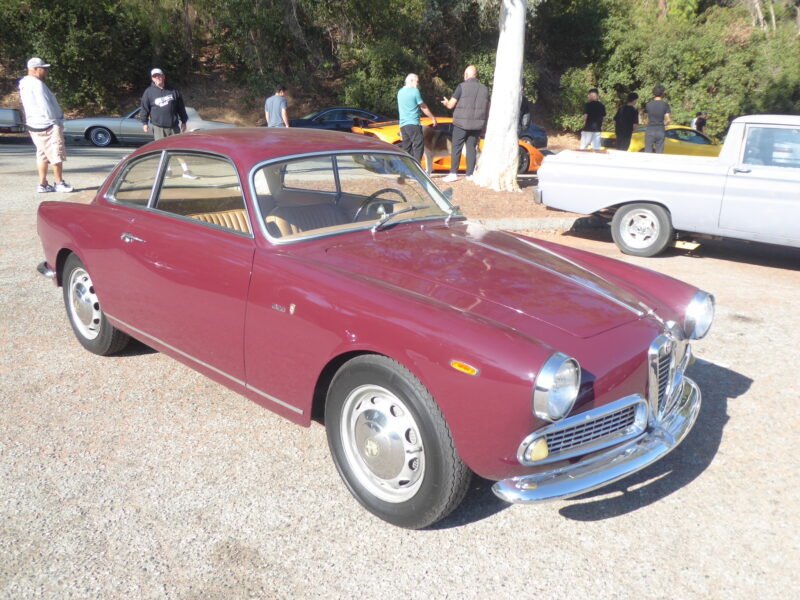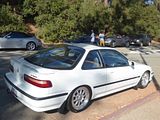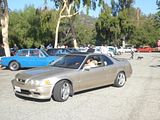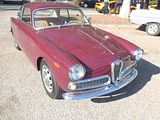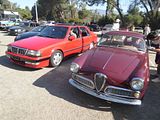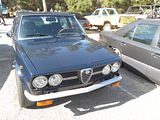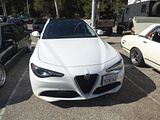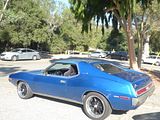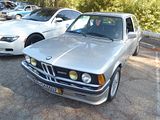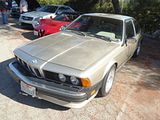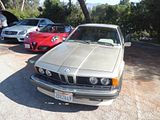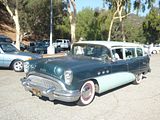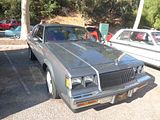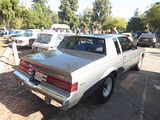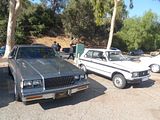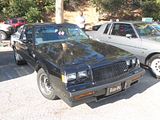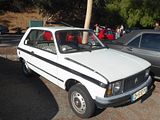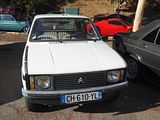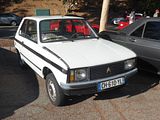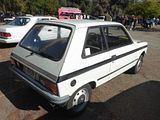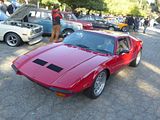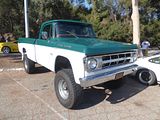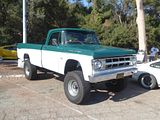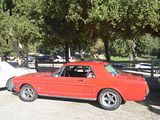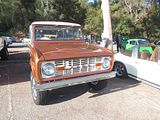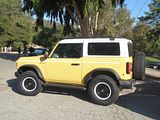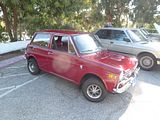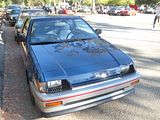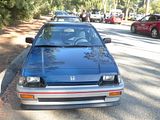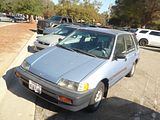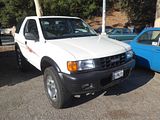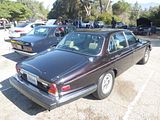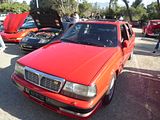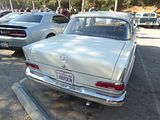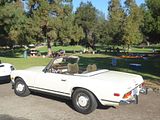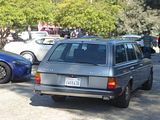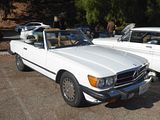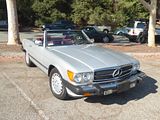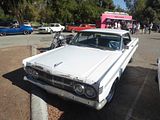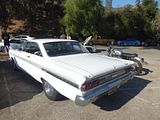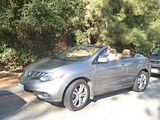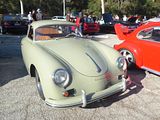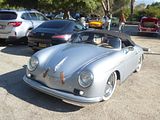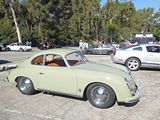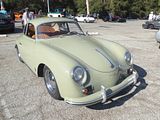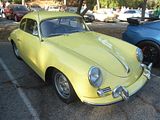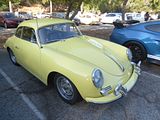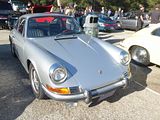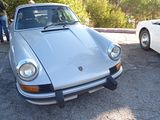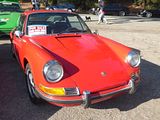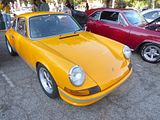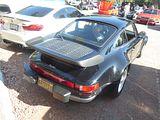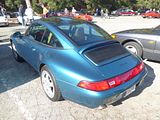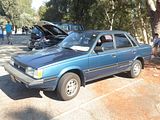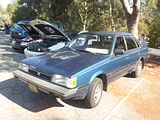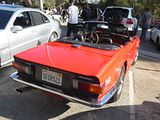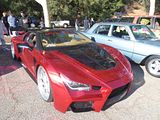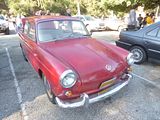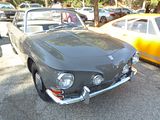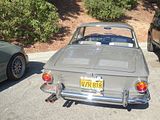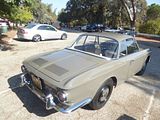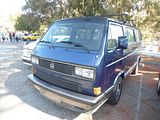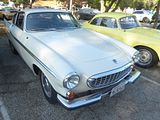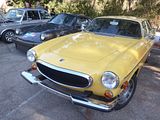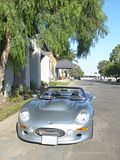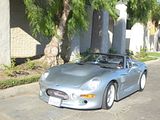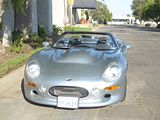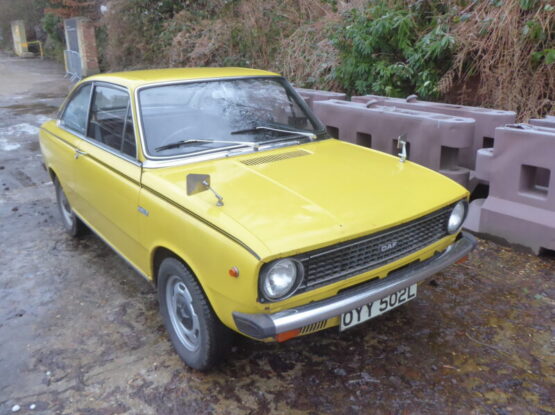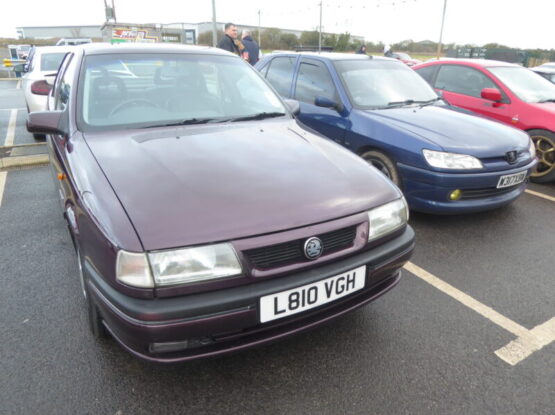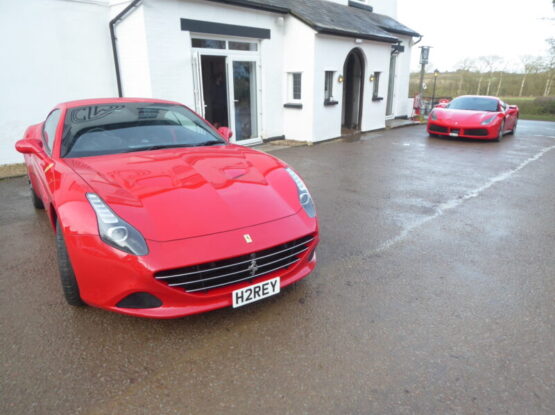This is my second Cars and Coffee in the Los Angeles area in two days. Unlike the first one I attended, which was a new discovery, this is one I found out a little while ago and so this was a return visit. Called the Los Angeles Cars and Coffee, it is held in the semicircle area in Griffith Park, that huge expanse of land in the Hollywood Hills to the north of the DownTown area. You’d be unlikely to stumble across it by accident as you need to drive through the main parking lot and keep going to find a smaller parking lot which is used for the core of the event, with a larger area available as overspill if needed. Like all such events in the US, things start early and finish early, so I made sure that I was at Hertz quite a bit earlier than usual, and did not linger over the selection of a rental car so I could make the journey of around 20 miles, which takes 25 to 30 minutes at this time of day on a Sunday, arriving before many of the early birds started to depart. There was already plenty parked up, and ore cars continued to arrive, so there was plenty to look at. As always at events like this, I did not take photos over absolutely everything that was there, for various reason, but there were plenty that I thought worthy of photos, and here they are. There were a number of European cars, not all of which were sold new here and for those which were not, I would guess have been imported here in the “over 25 year” rule. Enjoy!
ACURA
An all new Integra was introduced in 1989. The second-generation Integra continued to be available as a hatchback coupe but also a new 4-door notchback is available instead of a 5-door hatchback. The Integra coupe has a wheelbase that is 3.9 in (99 mm) longer than the previous generation and weights approximately 190-235 lbs more depending on the model. The second-generation Integra was introduced in April 1989, featuring the first VTEC engine ever manufactured by Honda (the B16A). For North America’s GS-R, the B17A1 engine is a 1.7-liter DOHC VTEC 4-cylinder engine with a specific power output of 160 PS was available beginning with the 1992 model year. VTEC engagement is at 5,500 rpm on the B16A engine, redline for the XSi is 8,200 rpm. All Japanese models remained exclusive to Honda Japanese dealership network called Honda Verno. There were two variants of the top DOHC VTEC model, the RSi, and the XSi. The RSi was the base model with a lighter weight thanks to wind-up windows, no rear spoiler and few options. Early RSi models also featured the S1 gearbox with slightly closer gear ratios than the Y1 gearbox fitted to the XSi. The XSi was the fully-optioned variant with climate control, optional sunroof, and anti-lock brakes. The XSi had a 0–100 km/h (62 mph) time of 7.2 seconds and can complete a standing quarter mile in 15.1 seconds. This top-spec DOHC VTEC model was complemented by more docile models that used dual-carburettor or PGM-Fi versions of the versatile 1.6-litre DOHC (ZC) engine but in the more compact SOHC configuration. Similarly there were base and full options variants of these SOHC engine Integras coded RX/RXi and ZX/ZXi respectively. All vehicles sold in Japan had their width dimensions slightly reduced so as to be in compliance with Japanese government regulations concerning exterior dimensions so that the car would be officially recognized as a “compact” and not incur yearly taxes for being wider. In October 1991, the range received a mild facelift. At the same time, a 1.8-liter version of the 4-door hardtop was made available in Japan. Called the ESi, it offered 140 PS at 6,300 rpm and was only available in conjunction with a 4-speed automatic transmission. At the same time, the VTEC was upgraded and now had 170 PS. This generation saw the discontinuation of the 5-door liftback, and the first availability of a 4-door sedan outside Japan. The new hardtop bodystyle reflected a popular trend in Japan of offering an entry-level sedan, such as the Civic-based platform the Integra used, in a reduced-height 4-door hardtop. The Integra sedan saw competition from the similarly sized Toyota Corolla Ceres, the Toyota Sprinter Marino, the Nissan Presea, and the Mazda Lantis. The sedan was only styled to look like a hardtop. The vehicle retained the B-pillar, while the doors were constructed without window frames. This styling carried over to the third-generation sedan, and shared visual similarities to the Honda Verno larger companion, the Honda Vigor. In North America, the Integra was sold under the Acura nameplate. Acura offered three trim levels (RS, LS and GS) for 1990 and 1991 model years and added a fourth trim level (GS-R) beginning in May 1992. Model choices consisted of a 3-door liftback and a new 4-door sedan. All trim levels were available with a 5-speed manual or 4-speed automatic transmission except for the GS-R which was only offered in a 5-speed manual with shorter gearing than other trim levels. The second-generation Integra coupe is 4.2 in (107 mm) longer overall and 1.8 in (46 mm) wider than the previous generation. A new 1.8-liter DOHC 4-cylinder engine producing 130 HP was standard equipment. Anti-lock brakes was standard on the GS model and motorized front shoulder belts were standard on all US-market models, while the Canadian-market models had the manual front shoulder belts. The third generation car arrived in 1993.
The Acura Legend is a mid-size luxury car manufactured by Honda from Japan. It was sold in the U.S. and Canada under Honda’s luxury brand, Acura, from 1985 until 1995. It was the first flagship sedan sold under the Acura nameplate, until being renamed in 1996 as the Acura 3.5RL. The 3.5RL was the North American version of the KA9 series Honda Legend. The opportunity for Japanese manufacturers to export more expensive models had arisen with the 1980s voluntary export restraints, negotiated by the Japanese government and U.S. trade representatives, restricting mainstream car sales. The initial success of the Legend and Honda’s Acura division in competing against established European and American luxury manufacturers would lead to Toyota and Nissan creating the Lexus and Infiniti brands, respectively, to compete in the luxury car market. Honda introduced the model in Japan on October 22, 1985, to be their premier luxury model, and in North America for the 1986 model year, as the top of the line model for its then-new Acura lineup. Sedan models came to the market first, powered by a 151 hp 2.5 L C25A V6, with coupes making their first appearance in 1987, powered by a new 161 hp 2.7 L C27A engine. Sedans received the new engine for 1988. The Legend was the first production Honda vehicle to offer a V6 engine. The 1987 Acura Legend LS coupe would be the first Japanese car to offer a driver’s side airbag. The Legend was a result of a joint venture with Britain’s Austin Rover Group called Project XX that started in November 1981 with the Austin Rover-Honda XX letter of intent signed by the two companies to replace the Rover SD1 and to provide a luxury vehicle for Honda. The Rover Company had a long established reputation as a luxury car in the United Kingdom and Europe, demonstrated with the Rover P6, and Honda wanted to introduce a luxury car for both domestic Japanese and the United States markets. The joint development produced the Legend and the corresponding British version was the Rover 800-series, which was badged under the Sterling brand in the United States and competed with the Legend. Rover also wanted to return to the American market when they had reportedly sold only 1,500 cars in 1971, and a brief return in 1980, selling 800 Rover SD1s by offering the Sterling. The Legend won Car and Driver’s Ten Best three years in a row and Motor Trend’s Import Car of the Year for 1987. Manual-equipped models could accelerate from 0-60 mph in under 8 seconds and reach a top speed of 135 mph (217 km/h). Sedan models had a drag coefficient of 0.32, while coupes were only 0.30. When the Legend was introduced, Honda’s newly established luxury car division just for the Legend was called Acura, using the advertising slogan “Precision Crafted Performance”, and the Legend was offered with one factory installed option, the choice of transmission used, and one trim level. In the 1986 sales brochure, the Legend’s full name used was “Legend Touring Sedan”. The vehicle was virtually identical in luxury content to the Japanese market V6Zi, but was identical in size and the longer overall length of the top level V6Xi to comply with United States crash standards, using the larger 2.5 V6 engine. The Technics supplied 80W four speaker cassette tape stereo offered four user programmable equalizer settings, and was equipped with a dual diversity antenna, meaning it had a conventional extendable power antenna and an embedded antenna in the rear window. One of the novelty items was a simple volume control rocker switch and a pre-set radio station channel selector installed on the instrument binnacle within reach of the right hand; the opposite side of the instrument binnacle had a button to open, tilt or close the standard equipped glass moonroof with sun shade. The North American Legend was not offered with some of the items offered in Japan, such as automatic, one-touch climate control, and 100% wool cloth interior in brown. Blue interior was shared with Japan and North America, but brown was not offered in North America, and “sand gray” was offered instead. Exterior colours were matched to only one interior colour choice and leather was not offered. Due to the success Honda had with the Legend, it served as an inspiration for the Subaru Legacy with which it shares many visual resemblances and dimensions both inside and out. In late 1988 for the 1989 model year, the sedan received some minor tweaks, upgrading to the one-piece front headlamps already in use in Japan since the 1985 introduction, a revised front bumper, trunk lid, tail light cluster, and an upgraded double-wishbone rear suspension, with a new alloy wheel appearance. By that time all Legends came equipped with a Honda-designed 4-wheel anti-lock brake system. A driver’s side airbag was now standard on all Legends. Other features such as power driver’s seat memory for 3 positions were added. High-end LS models featured a trip computer, electronic vehicle monitoring system in the center console and a Bose sound system. It was also joined by the Acura Vigor which set the stage for the larger second generation Legend introduced October 1990. For the 1990 model year, all Legends came with body-colored side mirrors. Legend coupes had a revised body-colored front grille, new red & clear tail lights, and improved front seats. LS model coupes also received a trunk-mounted lip spoiler. All LS models featured burlwood interior trim. Production of the first-generation models ended in 1990 as a second-generation version became available for the 1991 model year. At least by the 1990 model year, the fuel filler door on the sedan had been moved rearward about 15 cm (5.9 in). From the exterior, there are only superficial similarities between the Legend and its Rover 800/Sterling cousin. Both cars share the 2.5L and 2.7L Honda engine with 160 hp and a 4-speed automatic transmission. The core structure and chassis design is also common to both cars, however the Rover version has its own exterior panelwork, interior and electrical systems. The Rover was also offered with a 2.0L in-line 4-cylinder engines, however the Legend was only available with V6 power regardless of market. In Japan only, Honda installed a turbocharger with variable geometry in the Legend with the smaller 2.0 L V6, called the “Wing Turbo” for model year 1989.
Second generation Legends became available October 24, 1990, now using a 200 hp SOHC (C32A) engine mated to either a standard 6-speed manual or an optional 4-speed automatic. The second generation Legend was a larger, more streamlined-looking car (drag coefficients were actually higher at 0.34 for sedans and 0.32 for coupes). The design was referred to as a “fuselage” shape, and had rear-wheel drive proportions which were possible thanks to the use of a longitudinally mounted engine; unusual for front-wheel-drive automobiles. The Legend offered a host of features seen on luxury cars of today including dual front driver & passenger airbags (standard on 1991 Legend LS, 1992 L and LS trims), speed-sensitive steering, hands-free telephone, automatic climate control, heated leather seats, heated mirrors, four-wheel ABS disc brakes, seatbelt pretensioners, and electric soft-close doors (coupe only). Japan and New Zealand coupe/sedan models came factory with one-piece headlamps and built-in foglights. In Europe the Legend was fitted with all glass headlamps as well as built-in foglights, also a flush decklid spoiler option was available from factory (1991-1993 coupes only), similar to the USDM KA3/KA4 Legend first generation coupe/sedan option . (1994-1995 coupe) rear decklids were excluded from Europe’s factory flush spoiler option, as they offered a slightly enhanced curvature of decklid in the later production years. Japan, New Zealand & Europe coupe/sedan models also came fitted with a one of a kind Honda alpha touring grille. North American models did not, however they did receive a factory option set of lower bumper guard foglights making all legend model interchangeable options endless. Appearance of the sedan was adopted from the first generation Legend coupe and Honda also wanted to visually align the appearance of both the Legend coupe and sedan to the Acura NSX. Legend coupes also shared the same mirror design as the first generation NSX. The segment the Legend originally filled was now being served by the Acura Vigor which allowed the Legend to position itself more towards the rear drive Lexus LS and the Infiniti Q45 sedans. Honda decided not to upgrade the size of the engine to a V8 because it would have upstaged the Acura NSX which has a V6 that introduced Honda’s VTEC technology. For 1991 and 1992 the Legend sedan was available in ‘base’, ‘L’, and ‘LS’ trims; the coupe remained available in L and LS through its entire run. The higher-end LS cars added automatic climate control, a power four-way passenger seat, burled walnut interior trim, and body coloured side mouldings. Honda made significant upgrades for 1993, making a 230 hp Type II North America version of the SOHC C32A1 engine standard on all coupes, along with the option of a 6-speed manual transmission (for 1993-1995 coupes 1994-1995 sedan). The LS version of the sedan lost the option for a manual transmission and was only available with an automatic transmission from then on. 1993 also saw the addition of dual airbags as standard equipment in all trims, the deletion of the black moulding on the entry-level cars, and a new wheel design with fewer spokes on the sedans (16-spoke vs. 20-spoke). To reach the higher output, the Type II engine has bigger intake valves, a higher lift camshaft, and an exhaust with freer flow. For the 1994–95 model years, all Legends received new front bumper and trunk lid designs, a new front grille (L & LS Sedans only), and a power tilt-telescoping steering column; the word “Legend” was now spelled out in individual letters on the back. The base sedan was dropped, while a new GS sedan became the new top-line variant, sporting the 230 hp Type II engine, upgraded brakes from the coupe, sport suspension from the coupe, a body-coloured version of the 1991 to 1993 grille, the same standard 6-speed manual transmission found on the coupes as well as the special 16-inch 5-spoke LS Coupe wheels (better known as GS Wheels). This was the only 6-speed sedan offered. Added for 1995 was the limited-production ‘SE’ sedan, which was essentially a Legend ‘L’ with a two-tone paint scheme, pre-1993 15-inch 7-spoke ‘LS’ coupe wheels, “Special Edition” floor mats, and an automatic transmission. The Japan Domestic Market version of the 1990 Legend (second generation) was the second vehicle offered with a navigation system (electro Gyrocator). The tooling and intellectual property rights of the second generation Legend were licensed to Daewoo Motors of South Korea, where a clone of the Legend sedan, called the Daewoo Arcadia, was produced from 1994 to 1999. During this period, Honda also held a small stake in Daewoo Motors. Whilst the Legend name persisted in other markets, the successor to this car was rebranded as the RL in the US market when it appeared in 1995.
ALFA ROMEO
Following the 1900 family, Alfa’s next new model range would be cheaper and aimed at capturing some of the market from middle class buyers. Known as Giulietta, the 750 and later 101 Series were a series of family-sized cars made from 1954 to 1965, and Alfa Romeo’s first, successful, foray into the 1.3-litre class. The first to be introduced was the Giulietta Sprint 2+2 coupé which was premiered at the 1954 Turin Motor Show. Designed by Franco Scaglione at Bertone, it was produced at the coachbuilder’s Grugliasco plant, near Turin. A year later, at the Turin Motor Show in April 1955, the Sprint was joined by the 4-door saloon Berlina. In mid 1955, the open two-seat Giulietta Spider, featuring convertible bodywork by Pininfarina arrived. The Giulietta used unibody construction and a front-engine, rear-wheel-drive layout. Front suspension was by control arms, with coaxial coil springs and hydraulic dampers. At the rear there was a solid axle on coil springs and hydraulic dampers. The axle was located by a longitudinal link on each side, and by a wishbone-shaped arm linking the top of the aluminium differential housing to the chassis. All Giuliettas (save for the last SZ examples) had hydraulic drum brakes on all four corners. The Giulietta used an Alfa Romeo Twin Cam straight-four of 1290 cc, with an aluminium alloy engine block and cast iron inserted sleeves. Bore and stroke measured 74.0 mm and 75.0 mm. The aluminium alloy cylinder head was of a crossflow design and featured hemispherical combustion chambers. The double overhead camshafts were driven by two timing chains, and acted on two valves per cylinder, angled 80°. In 1957 a more powerful Berlina version, called Giulietta T.I. (Turismo Internazionale) was presented with minor cosmetic changes to the bonnet, the dial lights and rear lamps. Carrozzeria Colli also made the Giulietta station wagon variant called Giulietta Promiscua. Ninety-one examples of this version were built. Carrozzeria Boneschi also made a few station wagon examples called Weekendina. A new version of the Giulietta Berlina debuted at the Frankfurt Motor Show in 1959. Mechanical changes were limited to shifting the fuel pump from the cylinder head to a lower position below the distributor, and moving the previously exposed fuel filler cap from the tail to the right rear wing, under a flap. The bodywork showed a revised front end, with more rounded wings, recessed head lights, and new grilles with chrome frames and two horizontal bars. The rear also showed changes, with new larger tail lights on vestigial fins, which replaced the earlier rounded rear wings. The interior was much more organised and upholstered in new cloth material; the redesigned dashboard included a strip speedometer flanked by two round bezels, that on the T.I. housed a tachometer and oil and water temperature gauges. The T.I. also received a front side repeater mounted in a small spear, unlike the Normale which kept the earlier small round lamp with no decorations. During 1959 the type designation for all models was changed from 750 and 753 to 101. In February 1961 the 100,001st Giulietta rolled out of the Portello factory, with a celebration sponsored by Italian actress Giulietta Masina. In Autumn 1961 the Giulietta was updated a second time. Both Normale and T.I. had revised engines and new exhaust systems; output rose to 61 bhp and 73 bhp. With this new engine the car could reach a speed of almost 100mph. At the front of the car square mesh side grilles were now pieced together with the centre shield, and at the rear there were larger tail lights. Inside the T.I. had individual instead of bench seats, with storage nets on the seatbacks. June 1962 saw the introduction of the Alfa Romeo Giulia, which would eventually replace the Giulietta. As until 1964 the Giulia only had a larger 1.6-litre engine, production of the standard Berlina ended with 1963, whilst the T.I. continued for a full year more. A last T.I. was completed in 1965. The Giulietta sport models had a different fate: Sprint, Sprint Speciale and Spider were fitted with the new 1.6-litre engine, received some updates and continued to be sold under the Giulia name until they were replaced by all-new Giulia-based models during 1965. These days., the Berlina is the model you see the least often. A few of the model are used in historic racing where the car takes on the might of those with far larger engines. A total of 177,690 Giuliettas were made, the great majority in Berlina saloon, Sprint coupé or Spider roadster body styles
Taking its name from the successful Formula One car of 1951, the Type 159, was the Alfetta, and there was one of these to be seen here. The 116 Series Alfetta was launched in 1972, equipped with a 1.8-litre four-cylinder. It was a three-box, four-door saloon (Berlina in Italian) with seating for five designed in-house by Centro Stile Alfa Romeo; the front end was characterised by twin equally sized headlamps connected to a central narrow Alfa Romeo shield by three chrome bars, while the tail lights were formed by three square elements. At the 1975 Brussels Motor Show Alfa Romeo introduced the 1,594 cc 08 PS Alfetta 1.6 base model, easily recognizable by its single, larger round front headlights. Meanwhile, the 1.8-litre Alfetta was rebadged Alfetta 1.8 and a few months later mildly restyled, further set apart from the 1.6 by a new grille with a wider central shield and horizontal chrome bars. Engines in both models were Alfa Romeo Twin Cams, with two overhead camshafts, 8-valves and two double-barrel carburettors. Two years later the 1.6 was upgraded to the exterior and interior features of the 1.8. In 1977 a 2.0-litre model was added. Launched at the March Geneva Motor Show, the Alfetta 2000 replaced the long running 115 Series Alfa Romeo 2000. This range-topping Alfetta was 10.5 cm (4.1 in) longer than the others, owing to a redesigned front end with square headlights and larger bumpers with polyurethane inserts; the rectangular tail light clusters and C-pillar vents were also different. Inside there were a new dashboard, steering wheel and upholstery materials. Just a year later, in July 1978, the two-litre model was updated becoming the Alfetta 2000 L. Engine output rose from 122 PS to 130 PS; inside, the upholstery was changed again and dashboard trim went from brushed aluminium to simulated wood. The 2000 received fuel injection in 1979. A turbodiesel version was introduced in late 1979, the Alfetta Turbo D, whose engine was supplied by VM Motori. Apart from a boot lid badge, the Turbo D was equipped and finished like the top-of-the-line 2000 L both outside and inside. Therefore, it received a tachometer—very unusual in diesels of this era, but no standard power steering, in spite of the additional 100 kg (220 lb) burden over the front axle. The turbodiesel, a first on an Alfa Romeo’s passenger car, was of 2.0 litres and produced 82 PS. The Alfetta Turbo D was sold mostly in Italy and in France, as well as a few other continental European markets where the tax structure suited this model. It was never offered in the UK. In 1981 Alfa Romeo developed in collaboration with the University of Genoa a semi-experimental Alfetta version, fitted with a modular variable displacement engine and an electronic engine control unit. Called Alfetta CEM (Controllo Elettronico del Motore, or Electronic Engine Management), it was shown at the Frankfurt Motor Show. The 130 PS 2.0-litre modular engine featured fuel injection and ignition systems governed by an engine control unit, which could shut off two of four cylinders as needed in order to reduce fuel consumption. An initial batch of ten examples were assigned to taxi drivers in Milan, to verify operation and performance in real-world situations. According to Alfa Romeo during these tests cylinder deactivation was found to reduce fuel consumption by 12% in comparison to a CEM fuel-injected engine without variable displacement, and almost by 25% in comparison to the regular production carburetted 2.0-litre. After the first trial, in 1983 a small series of 1000 examples was put on sale, offered to selected clients; 991 examples were produced. Despite this second experimental phase, the project had no further developments. In November 1981 the updated “Alfetta ’82” range was launched, comprising 1.6, 1.8, 2.0 and 2.0 Turbo Diesel models. All variants adopted the bodyshell and interior of the 2.0-litre models; standard equipment became richer. All Alfettas had black plastic rubbing strips, side sill mouldings, tail light surround and hubcaps; the 2000 sported a satin silver grille and a simulated mahogany steering wheel rim. July 1982 saw the introduction of the range topping Alfetta Quadrifoglio Oro (meaning Gold Cloverleaf, a trim designation already used on the Alfasud), which took the place of the discontinued 2000 L. The Quadrifoglio Oro was powered by a 128 PS version of the usual 1962 cc engine, equipped with the SPICA mechanical fuel injection used on US-spec Alfettas; standard equipment included several digital and power-assisted accessories like a trip computer, check control panel and electrically adjustable seats. Visually the Quadrifoglio Oro was distinguished by twin round headlights, concave alloy wheels, and was only available in metallic grey or brown with brown interior plastics and specific beige velour upholstery. In March 1983 the Alfetta received its last facelift; the exterior was modernised with newly designed bumpers (integrating a front spoiler and extending to the wheel openings), a new grille, lower body plastic cladding, silver hubcaps and, at the rear, a full width grey plastic fascia supporting rectangular tail lights with ribbed lenses and the number plate. The C-pillar ventilation outlets were moved to each side of the rear screen. Inside there were a redesigned dashboard and instrumentation, new door panels and the check control panel from the Quadrifoglio Oro on all models. Top of the range models adopted an overhead console, which extended for the full length of the roof and housed three reading spot lamps, a central ceiling light, and controls for the electric windows. Alongside the facelift two models were introduced: the 2.4 Turbo Diesel, replacing the previous 2.0-litre, and a renewed Quadrifoglio Oro, equipped with electronic fuel injection. Thanks to the Bosch Motronic integrated electronic fuel injection and ignition the QO had the same 130 PS output of the carburetted 2.0, while developing more torque and being more fuel efficient. In April 1984 the successor of the Alfetta debuted, the larger Alfa Romeo 90. At the end of the year the Alfetta Berlina went out of production, after nearly 450,000 had been made over a 12-year production period.
Along with the Stelvio, the modern Giulia has been offered to US buyers since 2017. The car has only sold in small numbers, and has had a rather less enthusiastic reception from the US press compared to the positive write-ups that the car has had in Europe.
AMC
The AMC Javelin is an American front-engine, rear-wheel-drive, two-door hardtop automobile manufactured by American Motors Corporation (AMC) across two generations, 1968 through 1970 and 1971 through 1974 model years. The car was positioned and marketed in the pony car market segment. Styled by Dick Teague, the Javelin was available in a range of trim and engine levels, from economical pony car to muscle car variants. In addition to manufacture in Kenosha, Wisconsin, Javelins were assembled under license in Germany, Mexico, Philippines, Venezuela, as well as Australia – and were marketed globally. American Motors also offered discounts to U.S. military personnel, and cars were taken overseas. The Javelin won the Trans-Am race series in 1971, 1972, and 1976. The second-generation AMX variant was the first pony car used as a standard vehicle for highway police car duties by an American law. American Motors’ Javelin was the company’s entrant into the “pony car” market. The segment was created by the Ford Mustang even if Ford’s car was not the first entry. The Javelin’s design evolved from two prototype cars named AMX that were shown in AMC’s “Project IV” auto show circuit during 1966. One was a fiberglass two-seat “AMX”, and the other was a four-seat “AMX II”. These offerings reflected the company’s strategy to shed its “economy car” image and appeal to a more youthful, performance-oriented market. Sales of convertibles were dropping, and AMC did not have the resources to design separate fastback and notchback hardtops that were available on the Mustang and the second-generation Plymouth Barracuda, so the AMC styling team led by Dick Teague penned only one body style, “a smooth semi-fastback roofline that helped set Javelin apart from other pony cars.” The Javelin was built on AMC’s “junior” (compact) Rambler American platform only as a two-door hardtop model to be a “hip”, dashing, affordable pony car, as well as available in muscle car performance versions. “Despite management’s insistence on things like good trunk space and rear-seat room, Teague managed to endow the Javelin with what he termed the wet T-shirt look: voluptuous curves with nary a hint of fat.”
AUSTIN HEALEY
Known officially as the Sprite, it was announced to the press in Monte Carlo by the British Motor Corporation on 20 May 1958, just before that year’s Monaco Grand Prix. It was intended to be a low-cost model that “a chap could keep in his bike shed”, yet be the successor to the sporting versions of the pre-war Austin Seven. The Sprite was designed by the Donald Healey Motor Company, with production being undertaken at the MG factory at Abingdon. It first went on sale at a price of £669, using a tuned version of the Austin A-Series engine and as many other components from existing cars as possible to keep costs down. It was produced for a little over 3 years before being replaced by a Mark 2 version, which was then joined by a badge-engineered MG version, the Midget, reviving a model name used by MG from the late 1920s through to the mid 1950s. Enthusiasts often refer to Sprites and the later Midgets collectively as “Spridgets.” The first Sprite quickly became affectionately known as the “frogeye” in the UK and the “bugeye” in the US, because its headlights were prominently mounted on top of the bonnet, inboard of the front wings. The car’s designers had intended that the headlights could be retracted, with the lenses facing skyward when not in use; a similar arrangement was used many years later on the Porsche 928. But cost cutting by BMC led to the flip-up mechanism being deleted, therefore the headlights were simply fixed in a permanently upright position, giving the car its most distinctive feature. The body was styled by Gerry Coker, with subsequent alterations by Les Ireland following Coker’s emigration to the US in 1957. The car’s distinctive frontal styling bore a strong resemblance to the defunct American 1951 Crosley Super Sport. The problem of providing a rigid structure to an open-topped sports car was resolved by Barry Bilbie, Healey’s chassis designer, who adapted the idea provided by the Jaguar D-type, with rear suspension forces routed through the bodyshell’s floor pan. The Sprite’s chassis design was the world’s first volume-production sports car to use unitary construction, where the sheet metal body panels (apart from the bonnet) take many of the structural stresses. The original metal gauge (thickness of steel) of the rear structure specified by Bilbie was reduced by the Austin Design Office during prototype build, however during testing at MIRA (Motor Industry Research Association) distortion and deformation of the rear structure occurred and the original specification was reinstated. The two front chassis legs projecting forward from the passenger compartment mean the shell is not a full monocoque. The front sheet-metal assembly, including the bonnet (hood) and wings, was a one-piece unit, hinged from the back, that swung up to allow access to the engine compartment. The 43 bhp, 948 cc OHV engine (coded 9CC) was derived from the Austin A35 and Morris Minor 1000 models, also BMC products, but upgraded with twin 11⁄8 inch SU carburettors which gave it 43 hp at 5200 rpm and 52 lb/ft at 3300 rpm. When tested by “The Motor” magazine in 1958. It had a top speed of 82.9 mph and could accelerate from 0-60 mph in 20.5 seconds. Fuel consumption of 43 mpg was recorded. The rack and pinion steering was derived from the Morris Minor 1000 and the front suspension from the Austin A35. The front suspension was a coil spring and wishbone arrangement, with the arm of the Armstrong lever shock absorber serving as the top suspension link. The rear axle was both located and sprung by quarter-elliptic leaf springs, again with lever-arm shock absorbers and top links. There were no exterior door handles; the driver and passenger were required to reach inside to open the door. There was also no boot lid, owing to the need to retain as much structural integrity as possible, and access to the spare wheel and luggage compartment was achieved by tilting the seat-backs forward and reaching under the rear deck, a process likened to potholing by many owners, but which resulted in a large space available to store soft baggage. The BMC Competition Department entered Austin Healey Sprites in major international races and rallies, their first major success coming when John Sprinzel and Willy Cave won their class on the 1958 Alpine Rally. Private competitors also competed with much success in Sprites. Because of its affordability and practicality, the Austin Healey Sprite was developed into a formidable competition car, assuming many variants by John Sprinzel, Speedwell and WSM. The Sebring Sprite became the most iconic of the racing breed of Austin Healey Sprites. Many owners use their Austin Healey Sprites in competition today, sixty years after its introduction. 48,987 “frogeye” Sprites were made and the car remains popular to this day.
The Mark II to Mark IV Sprite were all very similar and represented the evolution of the model throughout the 1960s, The Mark II was announced at the end of May 1961. It used the same 948 cc engine with larger twin 1 1⁄4 inch SU carburettors, increasing power to 46.5 bhp. A close-ratio gearbox was fitted. The bodywork was completely revamped, with the headlights migrating to a more conventional position in the wings, either side of a full-width grille. At the rear, styling borrowed from the soon-to-be-announced MGB gave a similarly more modern look, with the added advantages of an opening boot lid and conventional rear bumper bar. The result was a much less eccentric-looking sports car, though at the expense of some 100 lbs extra weight. It followed the MG version of the car which was introduced a couple of weeks earlier as ‘the new Midget,’ reviving a model name which had been a great success for the MG Car Company in the 1930s. The Midget was to prove more popular with the public than the Sprite and by 1972 had completely supplanted it within the BMC range. In October 1962, both Sprites and Midgets were given a long-stroke 1098 cc engine. A strengthened gearbox with Porsche (baulk-ring) synchromesh was introduced to cope with the extra power – 56 bhp. Front disc brakes were also introduced at the same time and wire wheels became an option. 31,665 Mark II Sprites were made. The Mark III Sprite was also marketed as the Mark II MG Midget – differences between the two were again restricted to minor trim detailing. Although still 1098 cc, the engine had a stronger block casting, and the size of the crankshaft main bearings was increased to two inches. A new (slightly) curved-glass windscreen was introduced with hinged quarterlights and wind-up side windows. Exterior door handles were provided for the first time, with separate door locks. Though the car could now be secured, with a soft-top roof the added protection was limited. The rear suspension was modified from quarter-elliptic to semi-elliptic leaf springs, which gave a more comfortable ride for a near-negligible weight penalty as well as providing additional axle location, the upper links fitted to the quarter-elliptic models being deleted. Though scarcely sybaritic, these changes helped the Sprite and Midget compete with the recently released Triumph Spitfire. 25,905 Mark III Sprites were made. The next upgrade was presented at the London Motor Show in October 1966. Besides receiving the larger 1275 cc engine (which disappointed enthusiasts by being in a lower state of tune than that of the Mini-Cooper ‘S’), the Mark IV and its cousin the Mark III MG Midget had several changes which were more than cosmetic. Most notable is the change from a removable convertible top, which had to be stowed in the boot, to a permanently affixed, folding top of greatly improved design, which was much easier to use. Separate brake and clutch master cylinders were fitted, as car manufacturers’ thoughts began to turn to making their products safer. For the 1970 model year cast-alloy wheels were fitted and the grille was changed to resemble that fitted to the MG Midget. 22,790 Mark IV Sprites were made. The Healey connection was discontinued in 1971, so the final 1,022 Sprites built were simply Austin Sprites.
BMW
BMW E21 is the first generation of the BMW 3 Series compact executive car, produced by from 1975 to 1981. Most E21s were sold as 2-door compact sedans, however a Baur cabriolet was also available. Under the direction of its 51% percent shareholder, Herbert Quandt, BMW decided upon a replacement for their aging 02 Series. Paul Bracq, Director of Design at BMW from 1970 to 1974, is credited with setting the design direction of the E21. In July 1975, BMW’s Board of Management first presented this new model series in the Munich Olympic Stadium for public appraisal. The frontal view of the new car was dominated by the BMW trademark kidney grille standing out clearly from the radiator cover. The styling of the new car bore a resemblance to the BMW E12 5 Series. The wedge shape of the two-door model was distinctive, extending all the way to the unusually high rear end. In response to criticism of the tail design, a black plastic trim panel between the tail lights was added. Like many other BMW models, the C-pillar of the E21 features a Hofmeister kink. The cockpit design of the E21 marked the introduction of a new design concept, with the centre console and central dashboard area angled towards the driver. This feature has become part of BMW’s interior design philosophy for many years. As a sign of passive safety, all edges and control elements within the interior were rounded off and padded. The suspension incorporated rack and pinion steering and MacPherson strut suspension at the front, and semi-trailing arm type independent suspension at the rear. The rear suspension design causes camber changes, which can introduce “snap oversteer” at the handling limits, and the car was castigated repeatedly for this (now, of course, the press would shout in joy about such an attribute! The power assisted brakes were discs on the front wheels, while the rear wheels had drum brakes. Initially, a Getrag four-speed manual was the standard transmission fitment. Five-speed overdrive Getrag gearboxes were fitted as standard in 1980, but close ratio ‘sport’ gearboxes were available at the car’s release as an option. Alternatively, purchasers could opt for the ZF 3 HP-22 three-speed automatic transmission. At the E21’s release, three models were available: with 316 (1.6-litre), 318 (1.8-litre) and 320 (2.0-litre) versions of the BMW M10 4-cylinder engine. To differentiate between models, the 320 model came with dual headlights, while the 316 and 318 had single headlights. The fuel-injected 320i was introduced at the end of 1975. It featured the M10 4-cylinder engine with Bosch K-Jetronic fuel injection, and a limited slip differential was available as an option. At the 1977 International Auto Show in Frankfurt, BMW unveiled its new variants of the E21, featuring the new straight-6 M20 engines (which were initially called “M60”). BMW had invested DM 110 million the M20 engine series. The 4-cylinder 320 model was replaced with the 320/6, featuring a 2.0 version of the M20 engine. The 323i model was introduced, featuring 2.3 litre with 141 hp, which gave the 323i a top speed of 200 km/h (124 mph). The braking system was also upgraded, with the 323i featuring disc brakes on all wheels. Options include power steering, a 5-speed close-ratio ‘dogleg’ sport gearbox, and 25% limited slip differential. For the 1980 model year, the four-cylinder models were upgraded: the 1.8 litre carburetted M10 unit was revised to produce 89 hp and entered the market in the updated 316, while a fuel-injected version of the 1.8 litre M10 was introduced in the 318i model (which replaced the carburetted 318 as the mid-range model). The 320is model (USA only) was released in 1980 using a 1.8 litre version of the M10. The “S Package” featured Recaro sport seats, a modified dash with no air conditioning (A/C could be added by the dealer), upgraded suspension components that included a rear anti-roll bar and a larger front anti-roll bar, a 5-speed transmission and limited-slip differential, cross-spoke alloy wheels, an upgraded tool kit, a dual operation manual sunroof, an AM/FM Blaupunkt radio with cassette player, fog lights, a 3-spoke leather-wrapped steering wheel and leather shift knob, a front air dam, a “delete” of the alphanumeric 320i markers on the rear boot lid and a limited colour palate of white, silver or black. Just 2,500 320is were produced. In 1981, the economy model 315 was introduced as a reaction to the second “oil crisis” in late 1979. More spartan than the other E21 models, it was the last E21 to be built and shared production with the E30.
The first car to bear the 6 Series nomenclature was the E24, which was launched in 1976, as a replacement for the E9 model 3.0 CS and CSL coupés first produced in 1965. The 3.0 CS was almost changed by adding a few centimeters in height to make it easier for customers to get into the car. However, Bob Lutz rebelled against the decision and rough drafted an alternative version that soon became the 6 series. Production started in March 1976 with two models: the 630 CS and 633 CSi. Originally the bodies were manufactured by Karmann, but production was later taken in-house to BMW. In July 1978 a more powerful variant, the 635 CSi, was introduced that featured as standard a special close-ratio 5-speed gearbox and a single piece black rear spoiler. The bigger bore and shorter stroke facilitated max 218 hp at 5200rpm and a better torque curve. For the first year, the 635 CSi was offered in three colours (Polaris, Henna Red, Graphite), and could also be spotted by the front air dam that did not have attached fog lights. These simple cosmetic changes reportedly worked to reduce uplift on the car at high speeds by almost 15% over the non-spoiler body shape. This early model shared suspension components with the inaugural BMW 5-series, the E12. In 1979 the carburettor 630 CS was replaced with the 628 CSi with its fuel injected 2.8 litre engine taken from the BMW 528i. In 1980 the 635 CSi gained the central locking system that is also controlled from the boot. Also, the E24 body style converted from L-jetronic injection to a Bosch Motronic DME. In 1982 (Europe) and 1983 (US), the E24 changed slightly in appearance, with an improved interior and slightly modified exterior. At the same time, the 635 CSi received a new engine, a slightly smaller-bored and longer-stroked 3430 cc six to replace the former 3453 cc engine and became available with a wide-ratio 5-speed manual or an automatic. This slight change was in fact a major change as pre-1982 cars were based on the E12 5-series chassis; after mid-1982, E24s shared the improved E28 5-series chassis. The only parts that remained the same were some of the exterior body panels. E24s produced after June 1987 came with new, ellipsoid headlamps which projects beam more directly onto road surface (newly introduced E32 7-series also sporting them). The sleeker European bumpers were also discontinued. Previous cars had either a European-standard bumper or a larger, reinforced bumper to meet the US standard requiring bumpers to withstand impact at 5 mph without damage to safety-related components. 1989 was the last year for the E24 with production stopping in April. The E24 was supplanted by the considerably heavier, more complex, and more exclusive 8 Series. BMW Motorsport introduced the M 635 CSi in Europe at the Frankfurt Motor Show in 1983. It is essentially an E24 powered by the powerplant of the BMW M1 – the M88 with 286 PS). Most of the cars were equipped with special metric 415 mm diameter wheels requiring Michelin TRX tyres. A catalysed, lower compression ratio version of the car with the S38 engine (260 PS ) was introduced in the U.S. in 1987. All M6 cars came standard with a 25% rear limited slip differential. U.S. models included additional comforts that were usually optional on models sold in Europe such as Nappa leather power seats and a dedicated rear A/C unit with a centre beverage chiller. 4,088 M635CSi cars were built between 1983 and 1988 with 1,767 U.S. M6 built.
The BMW E28 was produced from 1981 to 1988 and replaced the E12 5 Series. The E28 has a self-supporting body that is welded to the body platform. The passenger cell is a safety passenger cell with deformation elements both in the front and rear of the vehicle. Unlike its E12 predecessor and E34 successor, the E28 has a rear-hinged bonnet. The boot has a volume of 460 litres. Most models have a fuel tank capacity of 70 L with some models having a smaller tank of 63 litres. The kerb weight is 1,140–1,410 kg (2,513–3,109 lb). Cruise control, an ‘on-board computer’ (to display trip information) and a “check control” panel (to alert the driver about fluid levels and lighting faults) were introduced to the 5 Series on the E28. The glazing is made of single-pane safety glass, the windscreen has laminated glass. As part of developing the air-conditioning system for the E28, several of the BMW engineers in charge of this program drove a previous generation E12 5 Series during the middle of summer in Texas. The E12 528i was painted black with a black interior, and driven 500 mi (805 km) in one day. The styling was developed under BMW’s chief designer Claus Luthe, with development of the E28 beginning in 1975. At the time that BMW was designing the E28, the company had only one computer, which was used for payroll management and spare parts logistics. Wolfgang Matschinsky and his team borrowed that computer to perform the calculations necessary to develop the new drivetrain and chassis. This was due to the fact that the addition of an ABS system necessitated a redesign from the previous model due to excessive vibrations under heavy braking. The four models available at the launch of the E28 were the 518, 520i, 525i and 528i, with the 518 using a straight-four petrol engine and the other three models using a straight-six petrol engine. Over the course of the E28 model, the following models were added: the 524d and 524td using diesel engines, the 518i (a fuel-injected version of the 518), the 525e/528e as fuel-economy models, and the upper-specification 533i, 535i, M535i, and M5 models. Production ceased at the end of 1987 in readiness for the E34 generation. A total of 722,328 cars were built.
BUICK
The 1950 through 1953 Estate continued using the Super and Roadmaster “C” platform, then in 1954 to 1958 it was offered on the shorter B platform Century and Special, with all steel bodies, shared with the Oldsmobile 88. Due to the high maintenance required of the genuine wood veneer panels requiring a coat of varnish to keep the durability and appearance, the use of wood gradually decreased until 1950 when it was not much more than window surround for the exterior while more modestly used inside where the wood was protected from the elements. The Estate for 1950 was offered on the Super and Roadmaster, while the Roadmaster was offered with two trim packages called Model 79 Estate Wagon and the Model 79R Deluxe Estate Wagon, the latter offering leather upholstery, a carpeted cargo area and the first time power windows and power adjustable front seat were available. It was installed with the largest engine available in the top-level Roadmaster, which was the Fireball Straight-eight engine that necessitated the long 126.25 in (3,207 mm) wheelbase. Production numbers for both continued to be modest, with the Super Estate manufacturing 2,480 in comparison to 114,745 Super Riviera Sedan, with a listed retail price of US$2,480 while the Roadmaster Estate and Roadmaster Deluxe Estate had a combined production of 420 and a listed retail price of US$3,433 making the Deluxe Estate the most expensive Buick for that year. Production numbers of the Estate had remained small since it was introduced, and Buick changed the platform used a few times in an attempt to stimulate sales, and in 1955 the Estate had its most popular year with a combined total of 7,195, with the breakdown of 2,952 Special Estate with the last year of the 264 cu in (4.3 L) Fireball Straight-eight engine at a listed retail price of US$2,974 and 4,243 for the Century Special and US$3,175, installing the all-new 322 cu in (5.3 L) Fireball V8. “Cordaveen” upholstery began to be installed in various configurations beginning in the mid-1950s with cloth inserts on higher trim packages. Later during the 50s, the fashionable hardtop body style was introduced on the Century Caballero Estate Wagons that were offered only in 1957 and 1958 and was shared with the Oldsmobile 88 Fiesta hardtop station wagon. The hardtop feature was also offered on the Special Riviera Estate Wagon and sold 6,817 with a listed retail price of US$3,167, while the Century Caballero Estate Wagon sold 10,186 with a listed retail price of US$3,706, leading in sales against the Chrysler New Yorker Town & Country and Mercury Colony Park.
A downsized Regal appeared for the 1978 model year with Buick’s new 196 cu in (3.2 L) V6 engine as standard equipment and a revised version of the venerable 231 cu in (3.8 L) V6 as an option (which became standard for 1980). Initially, a three-speed manual transmission was standard but this was later replaced by an automatic. At the time of introduction, Regals were available exclusively as coupés with the Century nameplate applied to standard equipment sedans and station wagons. In January 1982 the Century was replaced by an all-new car on the front-wheel drive A platform, which meant that the Regal gained a four-door sedan and five-door station wagon – essentially facelifted and rebadged versions of the previous year’s rear-wheel drive Century. It was the first time the name appeared on a full model lineup. The wagon was discontinued after 1983, and the sedan dropped from the lineup the next year. This generation Regal lasted ten years. The base model was equipped with softer-riding luxury suspension, and did not offer a manual transmission in later years. The 1978 Regal could be equipped with a 3,791 cc Turbocharged V6 engine with automatic transmission, and was known as a Regal Sport Coupe. The Buick LeSabre was also available with the turbocharged engine. The only other turbocharged cars available in the U.S. market in 1978 were imports from Mercedes-Benz, Porsche and Saab. The Regal Sport Coupe also included a firm handling suspension with larger tires and sport wheels. Bucket seats and a centre console with a T-shifter were also available. For 1980, the Regal was offered in a special Somerset Limited Edition trim which featured unique tan and dark blue designer exterior paint, wire wheel covers, sport mirrors, and chrome Somerset badging. The interior had tan and blue plush velour upholstery, brushed chrome trim, and additional Somerset badging. A Somerset Limited Edition model was also offered on the restyled 1981 Regal. It had unique dark sandstone and camel exterior paint, sport mirrors, and turbine wheels. The interior’s plush velour upholstery was camel with dark brown piping. A major facelift for 1981 gave the Regal a much more aerodynamic profile, helping make it possible for the car to compete on the NASCAR racing circuit. The sloping hood and nose of the car made it the favourite of several NASCAR teams, and reduced the drag coefficient by eighteen percent. Richard Petty drove one to victory in the 1981 Daytona 500, and the car won a majority of the 1981 and 1982 seasons races and won the NASCAR manufacturers title in 1981 and 1982. Buick would remain the last marque other than Chevrolet or Ford to win the Cup Series manufacturers championship until Toyota scored its first in 2016. It also propelled Buick to #3 in sales after 26 years, remaining in that place through 1983. V8s for street use were still available, but had shrunk to 265 cu in (4.3 L) (1980 and 1981 only, Pontiac built), and the V6 was rapidly gaining popularity. From 1986 to 1987, the 307 cu in (5.0 L) V8 was available as an option. The 3,791 cc 2-bbl V6 was standard. The 200-4R overdrive transmission was an option with either engine.
CHEVROLET
The Chevrolet Special Deluxe Series AH Fleetline is an automobile that was produced from 1941 to 1952. From 1946 to 1948 it was a sub-series of the Chevrolet Fleetmaster rather than a series of the Special Deluxe and, from 1949 to 1951, it was a sub-series of both the Chevrolet Special and the Chevrolet Deluxe. In its final year it was offered only as a sub-series of the latter. The Fleetline was introduced late in the 1941 model year as a four-door sedan only. In 1942, a fastback two-door “Aerosedan” was also offered while the sedan was renamed “Sport Master”. Production was indefinitely deferred in 1942 due to World War II, after 110,000 had been made, though several thousand Chevrolet coupes and sedans were produced during the war years for military staff use. In 1945, production for civilians resumed. In 1947, the Fleetline made up 31,86% of Chevrolet’s sales (213,938 of 671,543). For the years 1949 through 1952, the fastback was the only model offered, and Chevrolet dropped the Fleetline for 1953. The original series was produced through 1948. A redesigned Fleetline with reduced body contour and integrated rear fenders was offered for the 1949 through 1952 model years. It was referred to as a “fastback” because of its distinct sloping roof which extends through to the trunk lid. The Fleetline during the 1949 to 1950 years also has a lower look than a sedan, with the windshield being one inch shorter in height than a standard contemporary sedan. The 1949 to 1951 models were made in both four-door and two-door models, with only the lower part of the doors being interchangeable with a sedan door. The Fleetline series is currently highly collectable. Many are made into street rods, with the common Chevrolet 350 small block V8 and the 350 or 400 turbo transmission being used. However, with the turn of the new decade, the fastback designs were quickly becoming dated. Cadillac had already shed its fastbacks after the 1949 model year, while Buick, Oldsmobile and Pontiac lasted until 1951. Even by its last model year, 1952, the fastback Fleetline models was reduced to just one model, the Deluxe 2-door sedan. However, only 37,164 were produced in that model year, just about one-sixth of the 215,417 Styleline equivalents, and only a fifth of the 1950 high of 189,509.
The third generation Corvette, patterned after the Mako Shark II concept car, was introduced for the 1968 model year and was in production until 1982. C3 coupes featured the first use of T-top removable roof panels. The C3 introduced monikers that were later revived, such as LT-1, ZR-1, Z07 and Collector Edition. In 1978, the Corvette’s 25th anniversary was celebrated with a two-tone Silver Anniversary Edition and an Indy Pace Car replica edition of the C3. This was also the first time that a Corvette was used as a Pace Car for the Indianapolis 500. Engines and chassis components were mostly carried over from the C2, but the body and interior were new. The 350 cu in (5.7 litre) engine replaced the old 327 cu in (5.36 litre) as the base engine in 1969, but power remained at 300 bhp. 1969 was the only year for a C3 to optionally offer either a factory installed side exhaust or normal rear exit with chrome tips. The all-aluminium ZL1 engine was also new for 1969; the special big-block engine was listed at 430-hp , but was reported to produce 560 hp and propelled a ZL1 through the 1/4 mile in 10.89 seconds. There was an extended production run for the 1969 model year due a lengthy labour strike, which meant sales were down on the 1970 models, to 17,316. 1970 small-block power peaked with the optional high compression, high-revving LT-1 that produced 370 bhp. The 427 big-block was enlarged to 454 cu in (7.44 litre) with a 390 bhp rating. The ZR-1 special package was an option available on the 1970 through 1972 model years, and included the LT-1 engine combined with special racing equipment. Only 53 ZR-1’s were built. In 1971, to accommodate regular low-lead fuel with lower anti-knock properties, the engine compression ratios were lowered which resulted in reduced power ratings. The power rating for the 350 cu in (5.7 litre) L48 base engine decreased from 300 to 270 hp and the optional special high performance LT1 engine decreased from 370 to 330 hp. The big-block LS6 454 was reduced from 450 to 425 bhp, though it was not used in Corvettes for 1970; it was used in the Chevelle SS. For the 1972 model year, GM moved to the SAE Net measurement which resulted in further reduced, but more realistic, power ratings than the previous SAE Gross standard. Although the 1972 model’s 350 cu in horsepower was actually the same as that for the 1971 model year, the lower net horsepower numbers were used instead of gross horsepower. The L48 base engine was now rated at 200 bhp and the optional LT1 engine was now rated at 270 bhp. 1974 models had the last true dual exhaust system that was dropped on the 1975 models with the introduction of catalytic converters requiring the use of no-lead fuel. Engine power decreased with the base ZQ3 engine producing 165 bhp), the optional L82’s output 250 bhp, while the 454 big-block engine was discontinued. Gradual power increases after 1975 peaked with the 1980 model’s optional L82 producing 230 bhp. Styling changed subtly throughout the generation until 1978 for the car’s 25th anniversary. The Sting Ray nameplate was not used on the 1968 model, but Chevrolet still referred to the Corvette as a Sting Ray; however, the 1969 (through 1976) models used the “Stingray” name as one word, without the space. In 1970, the body design was updated including fender flares, and interiors were refined, which included redesigned seats, and indication lights near the gear shift that were an early use of fibre optics . Due to government regulation, the 1973 Corvette’s chrome front bumper was changed to a 5-mile-per-hour (8 km/h)system with a urethane bumper cover. 1973 Corvettes are unique in that sense, as they are the only year where the front bumper was polyurethane and the rear retained the chrome two-piece bumper set. 1973 was also the last year chrome bumpers were used. The optional wire-spoked wheel covers (left) were offered for the last time in 1973. Only 45 Z07 were built in 1973. From 1974 onwards both the front and rear bumpers were polyurethane. In 1974, a 5-mph rear bumper system with a two-piece, tapering urethane bumper cover replaced the Kamm-tail and chrome bumper blades, and matched the new front design from the previous year. 1975 was the last year for the convertible, (which did not return for 11 years). For the 1976 models the fibreglass floor was replaced with steel panels to provide protection from the catalytic converter’s high operating temperature. 1977 was last year the tunnelled roof treatment with vertical back window was used, in addition leather seats were available at no additional cost for the first time. The 1978 25th Anniversary model introduced the fastback glass rear window and featured a new interior and dashboard. Corvette’s 25th anniversary was celebrated with the Indy 500 Pace Car limited edition and a Silver Anniversary model featuring silver over gray lower body paint. All 1979 models featured the previous year’s pace car seats and offered the front and rear spoilers as optional equipment. 53,807 were produced for the model year, making 1979 the peak production year for all versions of the Corvette. Sales have trended downward since then. In 1980, the Corvette received an integrated aerodynamic redesign that resulted in a significant reduction in drag. After several years of weight increases, 1980 Corvettes were lighter as engineers trimmed both body and chassis weight. In mid-1981, production shifted from St. Louis, Missouri to Bowling Green, Kentucky, and several two-tone paint options were offered. The 1981 models were the last available with a manual transmission until well into the 1984 production run. In 1982, a fuel-injected engine returned, and a final C3 tribute Collectors Edition featured an exclusive, opening rear window hatch.
The third generation of Nova ran from 1968 to 1974. There was a complex array of models offered and there were annual changes, as was the custom in the US at this time. The 1973 model year introduced a hatchback body style based on the 2-door coupe. The front and rear of the Nova were restyled, following a government mandate for vehicles to be fitted with front bumpers capable of withstanding 5 mph (8 km/h) impacts and rear bumpers capable of absorbing 2.5 mph (4 km/h) impacts. To go along with the bigger bumpers, stylists gave the Nova a new grille with a loosely patterned crosshatch insert and parking lights located inboard of the headlights. In 1974, the rear bumper could absorb 5 mph impacts. Fuel tank capacity increased to 21 gallons, which required a redesigned trunk pan where a circular section was stamped to house the space-saver spare tire used on hatchback models. An SS option remained available, but it was merely a $123 dress-up package that included a blackout grille and Rally wheels. It could be ordered with any of the Nova engines. 35,542 SS packages were installed, making 1973 the best-selling year for the option. A modified rear side window shape was also introduced, eliminating the vent windows on both two- and four-door models. A revised rear suspension was adapted from the second generation Camaro with multi-leaf springs replacing the mono-leaf springs used on Novas since the original 1962 model. By this time, six-cylinder and V8 engines were de rigueur for American compact cars, with the 307 cu in (5.03 L) and 350 cu in (5.7 L) V8s becoming fairly common. The 1973 Nova with a six-cylinder engine or 307 cu. in. (5.0 L) V8 were among the last Chevrolets to be offered with the two-speed Powerglide automatic transmission, which was in its final year. A dressy Custom series (which became a mid-level trim package in 1975) joined the Nova line and a Custom hatchback listed for $2,701 with a six-cylinder engine. That was $173 more than the six-cylinder base-model two-door hatchback. Air conditioning added $381. Every 1973 Chevrolet Nova got side guard door beams and additional sound insulation, as well as flow-through ventilation systems. A sunroof could be installed, and fold-down rear seats were available. For 1974, the Chevrolet Nova got a centered bow-tie grille emblem, as well as modified bumpers that added two inches to the length and helped cushion minor impacts. The Powerglide was replaced by a lightweight version of the three-speed Turbo-Hydramatic 350 ( THM 250 ) already offered with the 350 cu in (5.7 L) V8, which was the only V8 offered for 1974. Nova sales continued the surge they had enjoyed since 1972 and approached 400,000 cars for 1974. Six-cylinder Novas were the fastest gainers, as sales of V-8 Novas declined. These were the years of the first energy crisis as Middle Eastern countries cut back on oil exports. After waiting for hours in gas lines and fretting about the prospect of fuel rationing, thrifty compacts looked pretty good to plenty of Americans and it fit the bill. The ‘Spirit of America’ Nova was introduced in 1974. In anticipation of the US bicentennial in 1976, the limited edition Nova Coupes were painted white and featured blue and red accent stripes as well as red and blue interior carpets and fabrics. Oldsmobile and Buick entered the compact car market; both the Apollo and Omega debuted, using the same body styles from the Nova lineup. Additional options were included on these Nova-like models, such as lighting under the dashboard and in the glove compartment. Pontiac’s final GTO of this era was based on a facelifted 1974 Ventura coupe, itself based on the Nova, but fitted with a shaker hood scoop from the Trans Am. Novas and all 1974 cars were fitted with a weight-sensitive relay within the front seat that prevented the vehicle from being started until the driver’s seatbelt had been fastened, following a safety mandate from the NHTSA. Later, Congress repealed the mandate requiring this type of device, declaring that it infringed on a driver’s freedom of choice, and allowed owners of 1974-model cars to have the seat belt interlock bypassed.[29] The devices were not included in future Nova models. Along with this controversial seat belt interlock, a new, more convenient “inertial reel” one-piece lap/shoulder safety belt assembly was standard for both front outboard passengers, along with a plastic clip attached to the headrest to guide the belt across the wearer’s shoulder.
The G body was restyled with the other GM mid-size formal coupes (Oldsmobile Cutlass Supreme, Pontiac Grand Prix, Buick Regal). It featured a smoother profile than the previous models and new vertical taillights similar to the 1973 through 1977 models. Engine offerings were carried over, including the standard 229 cu in (3.8 L) Chevrolet V6 (231 cu in (3.8 L) Buick V6 in California) an optional 267 cu in (4.4 L) V8 (not available in California), a 305 cu in (5.0 L) V8 in the base and Landau models, and a turbocharged 170 hp 231 cu in (3.8 L) Buick V6 in the Monte Carlo Turbo. There were a total of 3,027 Monte Carlo Turbos for 1981. The Monte Carlo Turbo appeared slightly different from other Monte Carlos that year because, in addition to the turbo, it also was equipped with a small hood scoop on the left side of the hood. It also had “Turbo 3.8” badges with a Chevrolet bowtie on the sides of the hood scoop, the trunk lid, and the right side of the dash. Standard equipment included automatic transmission, power steering, and front disc brakes. While some considered this car much better looking (and appeared more aerodynamic) than its Buick Regal, Pontiac Grand Prix, and Olds Cutlass cousins, only one team attempted to use the Monte Carlo in NASCAR cup racing. While the big Monte Carlo was the dominant body style in the late 1970s, winning many races, the downsized 1981 body would only take two checkered flags during the 1981 and 1982 seasons. Few revisions were made on the 1982 Monte Carlo. All engines, except for the turbocharged 231 cu in (3.8 L) V6, which was discontinued along with the Monte Carlo Turbo model, were carried over from 1981. New for 1982 were a 263 cu in (4.3 L) V6 and an Oldsmobile 350 cu in (5.7 L) V8, both of which were diesel engines. With the introduction of GM’s new mid-size platform that saw the introduction of the Buick Century, Chevrolet Celebrity, Oldsmobile Cutlass Ciera, and Pontiac 6000, the chassis designations were changed. The new mid-size cars were designated as A-body cars, whereas the cars previously designated as A-bodies were now called G-bodies. A black exterior was not offered in 1982 and also not available in 1982 for the first time in Monte Carlo history was a sportier interior option with Strato bucket seats and console, as only the standard notchback bench or optional 55/45 bench were offered this year. Weight distribution was 57% in the front and 43% in the rear. Receiving only minor updates, the 1983 model year Monte Carlo gained a revised grille and interior trim patterns. The standard engine continued to be the 229 cu in (3.8 L) V6, and the 150 hp 305 cu in (5.0 L) V8 was optional. The Monte Carlo SS was reintroduced in 1983 with the 175 hp 305 cu in (5.0 L) HO being standard, following twelve years of being discontinued. The Monte Carlo SS featured European body color-coding, a new front fascia, a rear spoiler, a performance axle ratio, the F41 suspension package, model-specific wheels and tires, as well as interior upgrades. The 1984 year model coupe production totalled 112,730 with an additional 24,050 had the SS option (with a 180 hp 305 V8 that saw a 5 hp boost from the previous year). The Monte Carlo SS was available with Strato bucket seats and floor console as extra-cost options for the first time in place of the standard split bench seat with armrest (the Strato buckets also returned as an option on the regular Monte after a two-year absence along with the T-top option.). The regular Monte Carlo came standard with a 125 hp 229 cu in (3.8 L) V6 (231 cu in (3.8 L) V6 for California) and a 165 hp 305 cu in (5.0 L) V8 was optional. The 350 cu in (5.7 L) diesel engine was available for the last year in a base Monte Carlo and were only 168 manufactured. All engines for 1984 included the three-speed automatic transmission except for three SSs at the end of the 1984 production run that received the Turbo Hydramatic 200-4R transmission with overdrive. In 1984, a limited number of Monte Carlo SSs were made in Mexico for Mexican sale. The differences are many compared to US/Canadian SSs. There was no rear spoiler. The wheels were 14-inch checker style, an option on the base Monte Carlos in the US. The side mirrors are in a different style and painted black. The interior is from the Grand Prix and is only in blue. The engine was a 350 cu in (5.7 L) V8, and the transmission was a 4-speed manual with a Hurst shifter. For 1985, additional SS colours (black, maroon, and silver in addition to white), pinstriping, and options were made available. The (later to be highly sought after) medium blue (“gunmetal”) colour for the SS was dropped. A four-speed automatic overdrive transmission, the Turbo Hydramatic 200-4R, with a revised sport rear axle ratio with a 3.73:1 gear, became standard on the SS. Discontinued were the 229 cu in (3.8 L) V6 and 350 cu in (5.7 L) V8 diesel engines. Introduced in place of the 229 V6 was a 262 cu in (4.3 L) V6 (RPO LB4) that was fuel-injected with throttle-body fuel injection. The small block 305 cu in (5.0 L) V8s included computer-controlled 2-barrel Quadrajet carburetors with an automatic choke to improve starting. The 1985 Chevrolet Monte Carlo was no longer available with a diesel engine. The base model’s previously standard 3.8 L Chevy V6 was changed to a 4.3 L V6 with throttle-body fuel injection. This increased output to 130. The optional 5.0 L V8 gained horsepower via an increased compression ratio. Horsepower rating went from 150 to 165. The High Output 5.0 L V8 in the 1985 Chevrolet Monte Carlo SS remained at 180 horsepower. 10.5-inch front disc brakes were standard, with drum brakes on the rear. A/C was $730. The V6 and base V8 were available with either a three- or four-speed automatic transmission, but the H.O. V8 in the SS came only with a four-speed automatic this year. The base coupe was visually unchanged except for pin-striping, optional T-tops, or a vinyl-covered roof. The SS version was modified. Previously offered only in white or dark blue metallic, color choices were expanded to include silver, maroon, and black. “Removable glass roof panels” (T-tops) came on board as a midyear option. Nearly 120,000 Monte Carlos were sold in 1985. Though the total was down from 1984, the SS model saw sales climb from 24,050 to 35,484. The 1985 Monte Carlo SS also came with a 35-millimeter sway bar. For 1986, there were four distinct body styles available. The base model Sport Coupe was still available with the same general body panels that it had since 1981, but featured new “aero” side mirrors similar to those on Camaros and Chevrolet Corvette of the 1980s. New for the 1986 model year was a Luxury Sport model with a revised front fascia, new “aero” side mirrors, and an updated sleek-looking rear fascia. The LS front fascia included “Euro” headlights with removable bulbs in a glass composite headlamp housing, versus the smaller sealed beam glass headlights of previous years. The rear bumper of the LS no longer had a “notch” between the bumper and trunk, and the taillights wrapped around so that they were visible from the sides of the car. The 1986 Super Sport model incorporated “aero” mirrors yet utilized the previous year’s styling for the rear bumper. New for 1986 was the Aerocoupe model. Modifications to the Super Sport body included a more deeply sloped rear window and a shorter trunk lid with a lower spoiler than the previous Super Sports version. A total of 200 Aerocoupes were sold, which was the number NASCAR required for road model features to be incorporated into the racing cars. All 200 were built in Arlington, Texas, finished in white with burgundy interior and sent to Cars & Concepts in Michigan for the conversion. In 1987, Chevrolet eliminated the Sport Coupe version of the Monte Carlo, leaving the LS, SS, and Aerocoupe. The Super Sport incorporated the “smoothed” rear bumper and tail lamps first introduced on the 1986 Luxury Sport; the “lay-down” spoiler was introduced midway through the production year. The Aerocoupe made up 6,052 of the 39,251 Super Sports produced that year. A total of 39,794 Luxury Sports were produced in 1987. The Monte Carlo returned for a shortened 1988 model year, largely carryover from 1987. The Monte Carlo SS now only offered a lay-down style spoiler (dropping the stand-up spoiler), with the LS seeing no visible changes. The Aerocoupe did not return, as Chevrolet had unveiled its intention to enter the Chevrolet Lumina coupe into NASCAR racing for 1989 – before the production vehicle was released to dealers as an early 1990 model. The design was more aerodynamic compared to the Monte Carlo SS. The final G-platform Monte Carlo – a silver SS — was produced by Arlington Assembly on December 12, 1987; production in the shortened model year fell to 30,174 units (16,204 Monte Carlo SS).
The 1982 (through the final 1987) El Camino sported a new frontal appearance with a crosshatch grille flanked by quad rectangular headlights. New under the hood for 1982 was a 105 hp 5.7-liter (350-cubic-inch) Diesel V8, which was also offered in Chevrolet’s full-size cars. Though mileage with the diesel was commendable, it was an expensive option and would eventually amass a dismal repair record. Gasoline-engine choices were unchanged, except Chevrolet’s 229-cubic-inch (3.8-liter) V6 was now standard in California-bound cars, replacing Buick’s 231-cubic-inch V6. In 1983, the 4.4-liter V8 was gone, leaving the 5.0-liter version as the only optional gas V8. The standard engine was again Chevrolet’s 3.8-liter V6 with 110 hp, though California cars, once again, got a Buick V6 with similar specifications. Continuing on the options list was the 5.7-liter V8 Diesel with 105 hp. The sister Malibu sedan and wagon were discontinued after the 1983 model year. The Royal Knight package was also discontinued in 1983. The 1983–87 El Camino was also offered as a cosmetic conversion through select dealers (completed by Choo-Choo Customs Inc., of Chattanooga, Tennessee). Modifications included an aerodynamic front end similar to the Monte Carlo SS, side exhaust skirts, and aluminum wheels. The conversion also included the addition of SS decals on the exterior of the body. However, the majority of El Caminos sent for customizing weren’t actual Super Sports. That distinction was only obtained by ordering the ‘SS Sport Decor’ option package from the factory which carries an RPO code of Z15. For 1985, GM shifted El Camino production to Mexico, and the new fuel-injected 4.3 L V6 became the base engine through 1987. El Camino production ended quietly in late 1987. Some model year 1987s (420 El Caminos and 325 GMC Caballeros) are listed as new car retail deliveries in calendar year 1988 based on their date of first retail sale. Speculation in online forums indicates 3GCCW80H2HS915586 “may” be the final vehicle. The GM Media Archive/Heritage Center confirmed that no 1988 El Caminos or Caballeros were ever produced.
There were also a couple of examples of the latest C8 generation Corvette here.
CITROEN
The Citroën LN (Hélène) and Citroën LNA (Hélèna) are city car automobiles produced between 1976 and 1986. The added “A” used in the name of the bigger engined LNA stood for Athlétique (Athletic). The LN was introduced in July 1976. It combined the bodyshell of the Peugeot 104 Z (a shortened floorpan version of the 104) with the economical 602 cc two-cylinder petrol engine of the Citroën 2CV. Equipment levels were low, but the LN’s key selling points were its cheap price and low running costs. There was evidence of defensiveness at the press launch, possibly because a car that looked like a Peugeot, but was assembled at a Citroën plant and fitted with a Citroën engine, sharply refuted assurances that the two marques would retain their individuality. Those assurances had been provided by the same press departments just a few months earlier, when Citroën had again run out of money and Peugeot had taken control. When pressed, Citroën explained that the LN project had been rushed through because of “the need to supply customers and the [dealership] network with a model to strengthen Citroën’s position at the lower end of the market” which was hardly a ringing endorsement of a range which at the time included the Ami and the Dyane as well as the venerable 2CV which would continue in production long after any of the others. Citroën made it clear that this would not happen again. They stayed true to this until the 1996 Citroën Saxo. Citroën sold the LN in its native France only, but a more powerful replacement, the LNA, was introduced on 6 November 1978 and was exported to much of the rest of Europe (including right-hand drive versions for Great Britain, where it was not launched until early 1983). It had the more powerful and modern 652 cc two-cylinder engine of the Citroën Visa with electrical ignition. In December 1982 a 1.1 L four-cylinder engine was added which had a top speed of nearly 90 mph (145 km/h) for the LNA 11E and 11RE, which spelled the end of the two-cylinder models in many markets. But like the smaller-engined LN, the LNA was cheap to buy and cheap to run. For Italy and France only, there was also an intermediate version called the LNA 10E, with a 954 cc Peugeot engine. By 1980 the LNA could also be purchased, in France, badged as the “LNA Entreprise”, with the back seat removed. This was effectively a function of taxation rules, whereby the two-seater car could be sold with a reduced rate of value-added tax, to the delight of budget conscious tradesfolk and sales representatives. After the LNA was launched, its Peugeot-sourced bodyshell also spawned the Talbot Samba which had square headlights and a different, slightly longer, rear body part. The mechanicals and a developed version of the full length 104 floorpan were used in the Citroën Visa that was also launched in 1978. 1983 cars arrived early, in July 1982, and benefited from new black plastic bumpers, a new decoration for the C-pillar, a newly positioned rubber side-stripe, new rear lights and, more elaborately styled wheels, which were shared with the manufacturer’s Visa Super E. In July 1985 Citroën introduced cars for the 1986 model year. The previously black grill and bumpers were now coloured grey, although LNA production ceased in the summer of 1986, around the same time as the Talbot Samba. Its successor, the Citroën AX, was launched shortly afterwards.
DE TOMASO
Designed by American Tom Tjaarda, and unlike the Mangusta, which employed a steel backbone chassis, the Pantera was a steel monocoque design, the first instance of De Tomaso using this construction technique. The Pantera logo included a version of Argentina’s flag turned on its side with a T-shaped symbol that was the brand used by De Tomaso’s Argentinian cattle ranching ancestors. The car made its public debut in Modena in March 1970 and was presented at the 1970 New York Motor Show a few weeks later. Approximately a year later the first production Panteras were sold, and production was increased to three per day. The curious slat-backed seats which had attracted comment at the New York Show were replaced by more conventional body-hugging sports-car seats in the production cars: leg-room was generous but the pedals were off-set and headroom was insufficient for drivers above approximately 6 ft. Reflecting its makers’ transatlantic ambitions, the Pantera came with an abundance of standard features which appeared exotic in Europe, such as electric windows, air conditioning and even “doors that buzz when … open”. By the time the Pantera reached production, the interior was in most respects well sorted, although resting an arm on the central console could lead to inadvertently activating the poorly located cigarette lighter. The first 1971 Panteras were powered by a Ford 351 cu in (5.8 litre) V8 engine that produced a severely underrated 330 hp. Stock dynos over the years proved that power was more along the lines of about 380 hp. The high torque provided by the Ford engine reduced the need for excessive gear changing at low speeds: this made the car much less demanding to drive in urban conditions than many of the locally built competitor products. The ZF transaxle used in the Mangusta was also used for the Pantera: a passenger in an early Pantera recorded that the mechanical noises emanating from the transaxle were more intrusive than the well restrained engine noise. Power-assisted four-wheel disc brakes and rack and pinion steering were all standard equipment on the Pantera. The 1971 Pantera could accelerate to 60 mph in 5.5 seconds. In the summer of 1971, a visitor to the De Tomaso plant at Modena identified two different types of Pantera awaiting shipment, being respectively the European and American versions. From outside, the principal differences were the larger tail lamps on the cars destined for America, along with addition of corner marker lamps. The visitor was impressed by the large number of cars awaiting shipment; but in reality, spending the best part of a year under dust covers in a series of large hangars probably did nothing for the cash-flow of the business or the condition of some of the cars by the time they crossed the Atlantic. Late in 1971, Ford began importing Panteras for the American market to be sold through its Lincoln Mercury dealers. The first 75 cars were simply European imports and are known for their “push-button” door handles and hand-built Carrozzeria Vignale bodies. A total of 1,007 Panteras reached the United States that first year. These cars were poorly built, and several Panteras broke down during testing on Ford’s test track. Early crash testing at UCLA showed that safety cage engineering was not very well understood in the 1970s. Rust-proofing was minimal on these early cars, and the quality of fit and finish was poor, with large amounts of body solder being used to cover body panel flaws. Notably, Elvis Presley once fired a gun at his Pantera after it would not start. An L model (“Lusso”) was added in 1972 and a GTS version in 1974, but it was not enough and Ford ended their importation to the US in 1975, having sold around 5,500 cars. De Tomaso continued to build the car in ever-escalating forms of performance and luxury for almost two decades for sale in the rest of the world. A small number of Panteras were imported to the US by grey market importers in the 1980s, notably Panteramerica and AmeriSport. After 1974, Ford US discontinued the Cleveland 351 engine, but production continued in Australia until 1982. De Tomaso started sourcing their V8s from Australia once the American supplies dried up. These engines were tuned in Switzerland and were available with a range of outputs up to 360 PS. The chassis was completely revised in 1980, beginning with chassis number 9000. From May 1980 the lineup included the GT5, which had bonded and riveted-on fibreglass wheelarch extensions and from November 1984 the GT5S model which had blended arches and a distinctive wide-body look. The GT5 also incorporated better brakes, a more luxurious interior, much larger wheels and tires and the fibreglass body kit also included an air dam and side skirts. Production of the wide body GT5 (and similarly equipped narrow body GTS models) continued until 1985, when the GT5-S replaced the GT5. Although the factory has not made its records available, an analysis based on Vehicle Identification Numbers by the Pantera Owners Club of America (POCA) late model (9000 series) registrar has shown that fewer than 252 GT5 Panteras were likely to have been built. The GT5-S featured single piece flared steel fenders instead of the GT5’s riveted-on fibreglass flares, and a smaller steel front air dam. The ‘S’ in the GT5-S name stood for “steel”. Otherwise the GT5-S was largely identical to the GT5. The POCA 9000 series registrar’s VIN analysis indicates that fewer than 183 GT5-S Panteras were built. Concurrent GTS production continued, on a custom order and very limited basis, until the late 1980s. The car continued to use a Ford V8 engine, although in 1988, when the supply of Ford 351 Cleveland engines from Australia ran out, De Tomaso began installing Ford 351 Windsor engines in the Pantera instead. For 1990 the 351 was changed to the Ford 302 cu in (4942 cc, commonly called a “5.0”). Incorporating a Marcello Gandini facelift, suspension redesign, partial chassis redesign and the new, smaller engine, the Pantera 90 Si model was introduced in 1990. Only 38 90 Si models were sold before the Pantera was finally phased out in 1993 to make way for the radical, carbon-fibre-bodied Guarà. Some say 41 were built (with the last one not finished until 1996), of which four were targa models. The targas were converted by Pavesi directly off the production lines. In all, about 7,200 Panteras were built.
DODGE
The Dodge Power Wagon is a four-wheel drive medium duty truck that was produced in various model series from 1945 to 1980 by Dodge. A one-ton W300 light-duty/civilian type Power Wagon was released in 1958. This also had the styled cab and sheet metal as the D300 Medium duty one-ton trucks. The two-ton W500 Power Wagon (only a chassis cab was built) was introduced in 1956 as the C3-HW and lasted through the 1971 model year. This was replaced in 1972 with the W600 (also cab and chassis only), which was produced until 1977 when all Dodge medium-duty models were discontinued. To compensate for the loss of the medium-duty W600 a new W400 chassis cab was introduced in 1977.
FERRARI
It was with the 360 Modena that sales of Ferrari models really took off, with unprecedented volumes of the car being sold. The 360 Modena was launched in 1999, named after the town of Modena, the birthplace of Enzo Ferrari. A major innovation in this all new model came from Ferrari’s partnership with Alcoa which resulted in an entirely new all-aluminium space-frame chassis that was 40% stiffer than the F355 which had utilised steel. The design was 28% lighter despite a 10% increase in overall dimensions. Along with a lightweight frame the new Pininfarina body styling deviated from traditions of the previous decade’s sharp angles and flip-up headlights. The new V8 engine, common to all versions, was of 3.6 litre capacity with a flat plane crankshaft, titanium connecting rods and generates 400 bhp Despite what looks like on paper modest gains in reality the power to weight ratio was significantly improved on over the F355, this was due to the combination of both a lighter car and more power. The 0 to 100 km/h acceleration performance improved from 4.6 to 4.3 seconds. The first model to be rolled out was the 360 Modena, available as a manual, or an F1 electrohydraulic manual. Next up was an open car. The 360 was designed with a Spider variant in mind; since removing the roof of a coupe reduces the torsional rigidity, the 360 was built for strength in other areas. Ferrari designers strengthened the sills, stiffened the front of the floorpan and redesigned the windscreen frame. The rear bulkhead had to be stiffened to cut out engine noise from the cabin. The convertible’s necessary dynamic rigidity is provided by additional side reinforcements and a cross brace in front of the engine. Passenger safety is ensured by a strengthened windscreen frame and roll bars. The 360 Spider displays a curvilinear waistline. The fairings imply the start of a roof, and stable roll bars are embedded in these elevations. Due to use of light aluminium construction throughout, the Spider weighs in only 60 kg heavier than the coupé. As with the Modena version, its 3.6 litre V8 with 400 bhp is on display under a glass cover. The engine — confined in space by the convertible’s top’s storage area — acquires additional air supply through especially large side grills. The intake manifolds were moved toward the center of the engine between the air supply conduits in the Spider engine compartment, as opposed to lying apart as with the Modena. In terms of performance, the 0-60 mph time was slightly slower at 4.4 seconds due to the slight weight increase, and the top speed was reduced from 189 to 180 mph. Despite the car’s mid-mounted V8 engine, the electrically operated top is able to stow into the compartment when not in use. The convertible top was available in black, blue, grey and beige. The transformation from a closed top to an open-air convertible is a two-stage folding-action that has been dubbed “a stunning 20 second mechanical symphony”. The interior of the Spider is identical to that of the coupé
FIAT
In the US, the 500 Abarth is badged as a Fiat, as this avoided the need to set up a new marque for what would be a relatively low volume car. The US market Abarths are made in Mexico and although looking very similar to the cars seen in the rest of the world are more different than you think. The most significant of the changes is that the car uses as 160 bhp version of the MultiAir engine, as opposed to the T-Jet that the rest of the world receives. The car did not really change from launch, a fact which continually frustrated the American owners, who wanted the changes they could see in the 595 and 695 models, and there was only ever one model, with just the choice of hatch or cabrio body.
The Fiat 124 Spider (Type 348) is a front-engine, rear-drive, two-passenger roadster manufactured by Mazda for FCA, having debuted at the 2015 LA Auto Show for model year 2016. Largely based on the fourth generation Mazda MX-5 Miata roadster, and manufactured alongside the MX-5 at Mazda’s Hiroshima plant, the 124 shares its platform, mechanicals, interior and top mechanism with the MX-5 — it is distinguished by an FCA engineered and manufactured turbocharged Multiair engine, uniquely tuned shock absorbers, unique exterior styling and slightly increased length and cargo capacity over the MX-5. In May 2012, Mazda and Alfa Romeo — at the time a subsidiary of the Fiat Group, now Stellantis — announced a joint venture to manufacture a common rear wheel drive platform. The companies would “develop two differentiated, distinctly styled, iconic and brand specific, lightweight roadsters featuring rear wheel drive”, with the two variants offering proprietary engines unique to each brand. In December 2014, FCA’s Sergio Marchionne determined Alfa Romeos would be manufactured only in Italy, saying “some things belong to a place. Alfa belongs to Italy,” adding “I remain committed to that architecture, with our powertrain. I’m not sure it will be with Alfa. But it will be with one of our brands.” At the time, Alfa Romeos were manufactured only in Italy, while Fiats were manufactured in Italy, but also globally — from Tychy, Poland, to Toluca, Mexico. With their prior agreement in place — for FCA to market a roadster based on the MX-5 to be manufactured by Mazda at its Hiroshima factory — FCA conceived of marketing a Fiat badged variant in lieu of the Alfa Romeo variant. In August 2016, FCA formally announced the Fiat 124 Spider based on the Mazda ND platform. In December 2016, the Detroit News said “in partnering with Mazda’s MX-5 Miata to resurrect the classic Fiat 124 Spider, Fiat Chrysler not only gained a halo sports car for its struggling Italian brand, but likely saved the most celebrated small sports car of the past 25 years (the MX-5)” — citing the markedly increased cost of developing a new car at the time and “the costliest wave of government regulation since the 1970s.” The 124 Spider was powered by Fiat’s 1.4 litre MultiAir turbocharged inline-four, producing 140 PS (138 bhp) and 240 Nm (177 lb/ft) of torque in European specification—and 160 bhp and 184 lb/ft (249 Nm) of torque in North American specification. The 124 manual transmission is from the third generation MX-5’s six speed transmission to cope with the turbo’s torque. Multiair is a hydraulically actuated variable valve timing (VVT) engine technology enabling “cylinder by cylinder, stroke by stroke” control of intake air directly via a gasoline engine’s inlet valves. Developed by Fiat Powertrain Technologies, the technology bypasses a primary engine inefficiency: pumping losses caused by restriction of the intake passage by the throttle plate, used to regulate air feeding the cylinders. At the 124’s debut, Fiat marketed a 124 Spider Anniversary edition, with 124 units carrying the designation—to commemorate the 50th anniversary of original 124 Sport Spider. Including features of the 124 Spider Lusso Plus trim, the edition also includes chromed mirrors, red ‘124’ badge on the front grille, interior numbered plaque, red exterior and black leather interior. In January 2019, FCA announced the Fiat 124 Spider was to be withdrawn from the market in the United Kingdom with immediate effect. The Abarth 124 Spider continued to be sold, but this too was withdrawn from the UK market in April 2019. On December 23, 2020, Stellantis announced the 124 Spider and 500 were to be withdrawn from their North American model lineup after the 2020 model year and would not return for 2021, as is the situation with 500L. These models were expected to sell into 2021 until stock depletion.
FORD
Drawing on inspiration from the mid-engined Ford Mustang I concept vehicle, Lee Iacocca ordered development of a new “small car” to vice-president of design at Ford, Eugene Bordinat. Bordinat tasked Ford’s three design studios (Ford, Lincoln-Mercury, and Advanced Design) to create proposals for the new vehicle. The design teams had been given five goals for the design of the Mustang: It would seat four, have bucket seats and a floor mounted shifter, weigh no more than 2,500 pounds (1,100 kg) and be no more than 180 inches (4,572 mm) in length, sell for less than $2,500, and have multiple power, comfort, and luxury options. The Lincoln–Mercury design studio ultimately produced the winning design in the intramural contest, under Project Design Chief Joe Oros and his team of L. David Ash, Gale Halderman, and John Foster. Development of the Mustang was completed in a record 18 months from September 1962 to March 1964. and Iacocca himself championed the project as Ford Division general manager. The styling is often credited to one person, and that is not accurate, as this was very much a team effort, it has been reported by those involved. To decrease developmental costs, the Mustang used chassis, suspension, and drivetrain components derived from the Ford Falcon and Fairlane. It used a unitised platform-type frame from the 1964 Falcon, and welded box-section side rails, including welded crossmembers. Although hardtop Mustangs accounted for the highest sales, durability problems with the new frame led to the engineering of a convertible first, which ensured adequate stiffness. Overall length of the Mustang and Falcon was identical, although the Mustang’s wheelbase was slightly shorter. With an overall width of 68.2 in (1,732 mm), it was 2.4 in (61 mm) narrower, yet the wheel track was nearly identical. Shipping weight, approximately 2,570 lb (1,166 kg) with the straight six-cylinder engine, was also similar to the Falcon. A fully equipped V8 model weighed approximately 3,000 lb (1,361 kg). Although most of the mechanical parts were from the Falcon, the Mustang’s body was completely different; sporting a shorter wheelbase, wider track, lower seating position and lower overall height. An industry first, the “torque box” was an innovative structural system that greatly stiffened the Mustang’s construction and helped contribute to better handling. The car was launched in 17th April 1964, as a hardtop and a convertible, with the fastback version following in August. It was an instant sensation, with demand massively exceeding supply. Since it was introduced four months before the normal start of the 1965 production year and manufactured alongside 1964 Ford Falcons and 1964 Mercury Comets, the earliest Mustangs are widely referred to as the 1964½ model. Nevertheless, all “1964½” cars were given 1965 U.S. standard VINs at the time of production, and – with limited exception to the earliest of promotional materials – were marketed by Ford as 1965 models. The low-end model hardtop used a “U-code” 170 cu in (2.8 litre) straight-6 engine borrowed from the Falcon, as well as a three-speed manual transmission and retailed for US$2,368. Standard equipment for the early 1965 Mustangs included black front seat belts, a glove box light, and a padded dash board. Production began in March 1964 and official introduction following on April 17 at the 1964 World’s Fair. V8 models got a badge on the front fender that spelled out the engine’s cubic inch displacement (“260” or “289”) over a wide “V.” This emblem was identical to the one on the 1964 Fairlane. Several changes to the Mustang occurred at the start of the “normal” 1965 model year in August 1964, about four months after its introduction. These cars are known as “late 65’s”. The engine lineup was changed, with a 200 cu in (3.3 litre) “T-code” engine that produced 120 hp. Production of the Fairlane’s “F-code” 260 cu in (4.3 litre) engine ceased when the 1964 model year ended. It was replaced with a new 200 hp “C-code” 289 cu in (4.7 litre) engine with a two-barrel carburettor as the base V8. An “A-code” 225 hp four-barrel carburettor version was next in line, followed by the unchanged “Hi-Po” “K-code” 271 hp 289. The DC electrical generator was replaced by a new AC alternator on all Fords (a way to distinguish a 1964 from a 1965 is to see if the alternator light on the dash says “GEN” or “ALT”). The Mustang GT version was introduced as the “GT Equipment Package” and included a V8 engine (most often the 225 hp 289), grille-mounted fog lamps, rocker panel stripes, and disc brakes. In the interior the GT option added a different instrument panel that included a speedometer, fuel gauge, temp. gauge, oil pressure gauge and ammeter in five round dials (the gauges were not marked with numbers, however.) A four-barrel carburettor engine was now available with any body style. Additionally, reverse lights were an option added to the car from August 1964 production. In 1965, the Shelby Mustang was born, it was available only in newly introduced fastback body version with its swept-back rear glass and distinctive ventilation louvres. The standard interior features of the 1965 Mustang included adjustable driver and passenger bucket seats, an AM radio, and a floor mounted shifter in a variety of colour options. Ford added additional interior options during the 1965 model year. The Interior Decor Group was popularly known as “Pony Interior” due to the addition of embossed running ponies on the seat fronts, and also included integral armrests, woodgrain appliqué accents, and a round gauge cluster that would replace the standard Falcon instrumentation. Also available were sun visors, a (mechanical) remote-operated mirror, a floor console, and a bench seat. Ford later offered an under-dash air-conditioning unit, and discontinued the vinyl with cloth insert seat option, offered only in early 1965 models. One option designed strictly for fun was the Rally-Pac. Introduced in 1963 after Ford’s success at that year’s Monte Carlo Rally and available on other Ford and Mercury compacts and intermediates, the Rally-Pac was a combination clock and tachometer mounted to the steering column. It was available as a factory ordered item for US$69.30. Installed by a dealer, the Rally-Pac cost US$75.95.A 14″ rim option was available for Rally-pac and GT350R vehicles widening front and rear track to 57.5″. Reproductions are presently available from any number of Mustang restoration parts sources. A compass, rear seat belts, A/C, and back-up lights were also optional. The 1966 Mustang debuted with moderate trim changes including a new grille, side ornamentation, wheel covers and filler cap. Ford’s new C-4 “cruise-o-matic” three-speed auto transmission became available for the 225 hp V8. The 289 “HiPo” K-code engine was also offered with a c4 transmission, but it had stronger internals and can be identified by the outer casing of the servo which is marked with a ‘C’. The long duration solid-lifter camshaft that allowed the high revving 289 to make the horsepower it was known for, was not friendly for a low stall speed automatic torque converter. The “HiPo” could be spotted very easily by the 1-inch-thick vibration damper, (as compared to 1/2 inch on the 225-hp version) and the absence of a vacuum advance unit on the dual point distributor. With the valve covers off, there is a large letter “K” stamped between the valve springs, along with screw in studs (vs. a pressed in stud for other 289s) for the adjustable rocker arms. A large number of new paint and interior color options, an AM/eight-track sound system, and one of the first AM/FM mono automobile radios were also offered. It also removed the Falcon instrument cluster; the previously optional features, including the round gauges and padded sun visors, became standard equipment. The Mustang would be the best-selling convertible in 1966, with 72,119 sold, beating the number two Impala by almost 2:1. The 1965 and 1966 Mustangs are differentiated by variations in the exterior, despite similar design. These variations include the emblem on the quarter-panels behind the doors. From August 1964 production, the emblem was a single vertical piece of chrome, while for 1966 models the emblem was smaller in height and had three horizontal bars extending from the design, resembling an “E”. The front intake grilles and ornaments were also different. The 1965 front grille used a “honeycomb” pattern, while the 1966 version was a “slotted” style. While both model years used the “Horse and Corral” emblem on the grille, the 1965 had four bars extending from each side of the corral, while on the 1966, these bars were removed. The 1966 model year saw introduction of ‘High Country Special’ limited edition, 333 of them were sold in Colorado, Wyoming, and Nebraska. When Ford wanted to introduce the Mustang in Germany, they discovered that Krupp company had already registered the name for a truck. The German company offered to sell the rights for US$10,000. Ford refused and removed Mustang badges from exported units, instead naming the cars as T-5 (a pre-production Mustang project name) for the German market until 1979 when Krupp copyrights expired. In 1965, Harry Ferguson Research purchased 3 Mustang notchbacks and converted them to 4×4 in an attempt to sell potential clients on their FF AWD system. A similar system was used in the Ferguson P99 Formula One car, and would go on to be featured in the Jensen FF, widely considered the first AWD passenger car. As in the Jensen FF, the AWD Mustangs also featured an ABS braking system, long before such a feature was commonplace. Ford Australia organised the importation and conversion of 1966 Mustang to right-hand-drive for the Australian market. This coincided with the launch of new XR Falcon for 1966, which was marketed as “Mustang-bred Falcon”. To set the official conversion apart from the cottage industry, the RHD Mustangs were called “Ford Australia Delivered Mustang” and had compliance plates similar to XR Falcon. About 209 were imported to Australia with 48 units were converted in 1965 while the further 161 were done in 1966. The 1967 model year Mustang was the first redesign of the original model. Ford’s designers began drawing up a larger version even as the original was achieving sales success, and while “Iacocca later complained about the Mustang’s growth, he did oversee the redesign for 1967 .” The major mechanical feature was to allow the installation of a big-block V8 engine. The overall size, interior and cargo space were increased. Exterior trim changes included concave taillights, side scoop (1967 model) and chrome (1968 model) side ornamentation, square rear-view mirrors, and usual yearly wheel and gas cap changes. The high-performance 289 option was placed behind the newer 335 hp 6.4 litre FE engine from the Ford Thunderbird, which was equipped with a four-barrel carburettor. During the mid-1968 model year, a drag racer for the street could be ordered with the optional 428 cu in (7.0 litre) Cobra Jet engine which was officially rated at 335 hp. All of these Mustangs were issued R codes on their VIN’s. The 1967 Deluxe Interior was revised, discontinuing the embossed running horse motif on the seat backs (the source for the “pony interior” nickname) in favor of a new deluxe interior package, which included special colour options, brushed aluminium (from August 1966 production) or woodgrain dash trim, seat buttons, and special door panels. The hardtop also included upholstered quarter trim panels, a carryover from the 1965-66 deluxe interior. The 1967 hardtop also had the chrome quarter trim caps, carried over from 1965-66, but these were painted to match the interior in 1968 models. The 1967 deluxe interior included stainless steel-trimmed seat back shells, similar to those in the Thunderbird. These were dropped at the end of the 1967 model year, and were not included in the woodgrain-trimmed 1968 interior. The deluxe steering wheel, which had been included in the deluxe interior for the 1965-66, became optional, and could also be ordered with the standard interior. The 1968 models that were produced from January 1968 were also the first model year to incorporate three-point lap and shoulder belts (which had previously been optional, in 1967-68 models) as opposed to the standard lap belts. The air-conditioning option was fully integrated into the dash, the speakers and stereo were upgraded, and unique center and overhead consoles were options. The fastback model offered the option of a rear fold-down seat, and the convertible was available with folding glass windows. Gone was the Rally-Pac, since the new instrument cluster had provisions for an optional tachometer and clock. Its size and shape also precluded the installation of the accessory atop the steering column. The convenience group with four warning lights for low fuel, seat belt reminder, parking brake not released, and door ajar were added to the instrument panel, or, if one ordered the optional console and A/C, the lights were mounted on the console. Changes for the 1968 model increased safety with a two-spoke energy-absorbing steering wheel, along with newly introduced shoulder belts. Other changes included front and rear side markers, “FORD” lettering removed from hood, rearview mirror moved from frame to windscreen, a 302 cu in (4.9 litre) V8 engine was now available, and C-Stripe graphics were added. The California Special Mustang, or GT/CS, was visually based on the Shelby model and was only sold in Western states. Its sister, the ‘High Country Special’, was sold in Denver, Colorado. While the GT/CS was only available as a coupe, the ‘High Country Special’ model was available in fastback and convertible configurations during the 1966 and 1967 model years, and as a coupe for 1968. The 1968 Ford Mustang GT Fastback reached iconic status after it was featured in the 1968 film Bullitt, starring Steve McQueen. In the film, McQueen drove a modified 1968 Mustang GT 2+2 Fastback chasing a Dodge Charger through the streets of San Francisco. There were further annual updates until the model’s replacement in 1973, but with each the car got steadily bigger and less overtly sporty. Sales reduced, too, suggesting that Ford were losing their way. Mustang II did not fix that, of course, but gradually, the legendary nameplate has returned to delivering the same sort of promise as those early and much loved cars were able to do. The idea behind the Bronco began with Ford product manager Donald N. Frey in the early 1960s (who also conceived the Ford Mustang) and was engineered by Paul G. Axelrad, with Lee Iacocca approving the final model for production in February 1964, after the first clay models were built in mid-1963. Developed as an off-road vehicle (ORV), the Bronco was intended as a competitor for the Jeep CJ-5, International Harvester Scout and Toyota Land Cruiser. Today a compact SUV in terms of size, Ford marketing shows a very early example of promoting a civilian off-roader as a “Sports Utility” (the two-door pickup version). Initially selling well, following the introduction of the Chevrolet Blazer, Jeep Cherokee, and International Scout II (from 1969 to 1974), demand shifted towards SUVs with better on-road capability, leading to a decline in demand for the Bronco. The first-generation Bronco is built upon a chassis developed specifically for the model range, shared with no other Ford or Lincoln-Mercury vehicle. Built on a 92-inch wheelbase (sized between the CJ-5 and Scout; only an inch shorter than the later CJ-7), the Bronco used box-section body-on-frame construction. To simplify production, all examples were sold with four-wheel drive; a shift-on the-fly Dana 20 transfer case and locking hubs were standard. The rear axle was a Ford 9-inch axle, with Hotchkiss drive and leaf springs; the front axle was a Dana 30, replaced by a Dana 44 in 1971. In contrast to the Twin I-Beams of larger Ford trucks, the Bronco used radius arms to locate the coil-sprung front axle, along with a lateral track bar, allowing for a 34-foot turning circle, long wheel travel, and antidive geometry (useful for snowplowing). A heavier-duty suspension system was an option, along with air front springs. At its August 1965 launch, the Bronco was offered with a 170-cubic-inch inline six. Derived from the Ford Falcon, the 105-hp engine was modified with solid valve lifters, a 6-US-quart (6 L) oil pan, heavy-duty fuel pump, oil-bath air cleaner, and carburettor with a float bowl compensated against tilting. In March 1966, a 200-hp 289-cubic-inch V8 was introduced as an option. For the 1969 model year, the 289 V8 was enlarged to 302 cubic inches, remaining through the 1977 model year. For 1973, a 200 cubic-inch inline six became the standard engine, offered through 1977. To lower production costs, at its launch, the Bronco was offered solely with a three-speed, column-shifted manual transmission and floor-mounted transfer case shifter (with a floor-mounted transmission shifter later becoming a popular modification). In 1973, in response to buyer demand, a three-speed automatic transmission was offered as an option. In a central theme of the first-generation Bronco, styling was subordinated to simplicity and economy, so all glass was flat, bumpers were straight C-sections, and the left and right door skins were symmetrical (prior to the fitment of door-mounting hardware). For 1966, three Bronco body configurations were offered, including a two-door wagon, a half-cab pickup, and an open-body roadster. With a base price of $2,194, the Bronco included few amenities as standard. However, a large number of options were offered through both Ford and its dealers, including front bucket seats, a rear bench seat, a tachometer, and a CB radio, as well as functional items such as a tow bar, an auxiliary gas tank, a power take-off, a snowplow, a winch, and a posthole digger. Aftermarket accessories included campers, overdrive units, and the usual array of wheels, tires, chassis, and engine parts for increased performance. For 1967, Ford introduced the Sport option package for the Bronco wagon. Consisting primarily of chrome exterior trim and wheel covers, the Sport package was distinguished by red-painted “FORD” grille lettering. For 1970, the Bronco Sport became a freestanding model rather than an option package. To comply with federal regulations, the Bronco was fitted with back-up lights and side marker lamps in 1967 and 1968, respectively. After struggling with sales, the open-body Bronco roadster was withdrawn after the 1968 model year. After 1972, the Bronco half-cab was withdrawn; along with its lower sales compared to the wagon, Ford had introduced the larger Ford Courier compact pickup. In a minor revision, for 1977, the exterior-mounted fuel tank caps were replaced behind hinged doors (as on all other Ford trucks). A second generation model was launched for 1978.
The 1979 Mustang was based on the larger Fox platform (initially developed for the 1978 Ford Fairmont and Mercury Zephyr). The larger body with an increased wheelbase yielded more interior space for four passengers, especially in the back seat, as well as a larger capacity trunk and a bigger engine bay. Body styles included a coupe (or notchback), hatchback, and convertible which was added for the 1983 model year. Available trim levels included an unnamed base model (1979–1981), Ghia (1979–1981), Cobra (1979–1981, 1993), L (1982–1984), GL (1982–1983), GLX (1982–1983), GT (1982–1993), Turbo GT (1983–1984), LX (1984–1993), GT-350 20th anniversary edition (1984), SVO (1984–1986) and Cobra R (1993). Engines and drivetrains carried over from the Mustang II including the 2.3 L I4, 2.8 L V6, and 4.9 L V8 engines. A troublesome 2.3 L turbocharged I4 was available during initial production startup and then reappeared after undergoing improvements for the mid-year introduction of the 1983 turbo GT. The 2.8 L V6, in short supply, was replaced with a 3.3 L I6 engine during the 1979 model year. That engine was ultimately replaced with a new 3.8 L V6 for 1983. The 302 cu in (4.9 L) V8 was suspended after 1979 and replaced with a smaller, 4.2 L V8 which was dropped in favour of the high output 302 cu in (4.9 L) V8 for 1982. From 1979 to 1986, the Capri was domestically produced as a Mercury-badged version of the Mustang, using a few of its own styling cues. The third-generation Mustang had two different front-end styles. From 1979 to 1986, the front end was angled back using four rectangular headlights, known by enthusiasts as “four eyes”. The front end was restyled for 1987 to 1993 model years to reflect the contemporary, rounded-off “aero” style of the Ford Taurus using flush-composite headlamps and a smooth grille-less nose. The Mustang was selected as the 1979 Official Indianapolis 500 Pace Car with replicas sold to the public. Its special body-appearance parts were adapted by the Cobra package for 1980–81. 1982 marked the return of the Mustang GT (replacing the Cobra) which used a specially-modified high-output 302 cu in (4.9 L) engine. 1983 saw the return of the Mustang convertible after a nine-year absence. The front fascias of all Mustangs were restyled, featuring new grilles, sporting “blue oval” Ford emblems for the first time. 1984 introduced the high-performance Mustang SVO, which featured a 2.3 L turbocharged and intercooled four-cylinder engine and unique bodywork. The Mustang celebrated its 20th anniversary with a special GT350 model in white with red interior and red lower-bodyside rocker stripes. 1985 Mustangs received another front-fascia restyle. In response to poor sales and escalating fuel prices during the early 1980s, a new Mustang was in development. It was to be a variant of the Mazda MX-6 assembled at AutoAlliance International in Flat Rock, Michigan. Enthusiasts wrote to Ford objecting to the proposed change to a front-wheel drive, Japanese-designed Mustang without a V8 option. The result was the continuation of the existing Mustang while the Mazda MX-6 variant had a last-minute name change from Mustang to Probe and was released as a 1989 model. The Mustang received a major restyling for 1987, including the interior, which carried it through the end of the 1993 model year. Under the newly established Ford SVT division, the 1993 Ford Mustang SVT Cobra and Cobra R were added as special, high-performance models.
The idea behind the Bronco began with Ford product manager Donald N. Frey in the early 1960s (who also conceived the Ford Mustang) and engineered by Ford engineer Paul G. Axelrad, with Lee Iacocca approving the final model for production in February 1964, after the first clay models were built in mid-1963. Developed as an off-road vehicle (ORV), the Bronco was intended as a competitor for the Jeep CJ-5 and International Harvester Scout. Today a compact SUV in terms of size, Ford marketing shows a very early example of promoting a civilian off-roader as a “Sports Utility” (the two-door pickup version). Initially selling well, following the introduction of the Chevrolet Blazer, Jeep Cherokee, and International Scout II (from 1969 to 1974), demand shifted towards SUVs with better on-road capability, leading to a decline in demand for the Bronco. The first-generation Bronco is built upon a chassis developed specifically for the model range, shared with no other Ford or Lincoln-Mercury vehicle. Built on a 92-inch wheelbase (sized between the CJ-5 and Scout; only an inch shorter than the later CJ-7), the Bronco used box-section body-on-frame construction. To simplify production, all examples were sold with four-wheel drive; a shift-on the-fly Dana 20 transfer case and locking hubs were standard. The rear axle was a Ford 9-inch axle, with Hotchkiss drive and leaf springs; the front axle was a Dana 30, replaced by a Dana 44 in 1971. In contrast to the Twin I-Beams of larger Ford trucks, the Bronco used radius arms to locate the coil-sprung front axle, along with a lateral track bar, allowing for a 34-foot turning circle, long wheel travel, and antidive geometry (useful for snowplowing). A heavier-duty suspension system was an option, along with air front springs. At its August 1965 launch, the Bronco was offered with a 170-cubic-inch inline six. Derived from the Ford Falcon, the 105-hp engine was modified with solid valve lifters, a 6-US-quart (6 L) oil pan, heavy-duty fuel pump, oil-bath air cleaner, and carburettor with a float bowl compensated against tilting. In March 1966, a 200-hp 289-cubic-inch V8 was introduced as an option.For the 1969 model year, the 289 V8 was enlarged to 302 cubic inches, remaining through the 1977 model year. For 1973, a 200 cubic-inch inline six became the standard engine, offered through 1977. To lower production costs, at its launch, the Bronco was offered solely with a three-speed, column-shifted manual transmission and floor-mounted transfer case shifter (with a floor-mounted transmission shifter later becoming a popular modification). In 1973, in response to buyer demand, a three-speed automatic transmission was offered as an option. In a central theme of the first-generation Bronco, styling was subordinated to simplicity and economy, so all glass was flat, bumpers were straight C-sections, and the left and right door skins were symmetrical (prior to the fitment of door-mounting hardware). For 1966, three body configurations were offered, including a two-door wagon and half-cab pickup, and open-body roadster. At its $2,194 base price, the Bronco included few amenities as standard. However, a large number of options were offered through both Ford and its dealers, including front bucket seats, a rear bench seat, a tachometer, and a CB radio, as well as functional items such as a tow bar, an auxiliary gas tank, a power take-off, a snowplow, a winch, and a posthole digger. Aftermarket accessories included campers, overdrive units, and the usual array of wheels, tyres, chassis, and engine parts for increased performance. For 1967, Ford introduced the Sport option package for the Bronco wagon. Consisting primarily of chrome exterior trim and wheelcovers, the Sport package was distinguished by red-painted FORD grille lettering. For 1970, the Bronco Sport became a freestanding model rather than an option package. To comply with federal regulations, the Bronco was fitted with backup lights and side marker lamps (in 1967 and 1968, respectively). After struggling with sales, the open-body Bronco roadster was withdrawn after the 1968 model year. After 1972, the Bronco half-cab was withdrawn; along with its lower sales compared to the wagon, Ford had introduced the larger Ford Courier compact pickup. In a minor revision, for 1977, the exterior-mounted fuel tank caps were replaced behind hinged doors (as on all other Ford trucks). Initially offered as a single trim level with a long option list, for 1967, Ford introduced the Sport option package for the Bronco wagon. Consisting primarily of chrome exterior trim and wheelcovers, the Sport package was distinguished by red-painted FORD grille lettering. For 1970, the Bronco Sport became a freestanding model rather than an option package. For 1972, in line with the F-Series trucks, the Ranger trim became the top-of-the-line Bronco, offering body stripes, model-specific wheel covers, cloth seats, woodgrain door panels, and carpeted interior. In a 1975 interior revision, the Bronco Sport and Bronco Ranger adapted the two-spoke steering wheel from the F-Series.
Also here was the recently released new Bronco, a direct rival to the Jeep Wrangler and a model which has clear styling links to the original.
HONDA
Honda’s idea for a practical kei-class car came to life with the N360 series. The “N” stood for “norimono”, which means “vehicle” in Japanese. Hitting the market in March 1967, the N360 was built for domestic sales in Japan, while the N600 was destined for the European and American markets. The N600 was the first automobile Honda sold in America. As such, it is the genesis for every Honda hatchback that followed, both here and in Japan: Life, City, Today, Civic, and N-One. The drivetrain was even used as the basis for other Hondas, such as the TN360, Life Step Van and truck, Vamos, and Z-series. The engine for the N-series was derived from the CB450 motorcycle. Both cars originally came standard with manual transmissions, but offered an automatic transmission option starting in 1968, making the N360 the first kei-class car to do so.
In 1983 for the 1984 model year, Honda introduced an all-new two-seater that shared the drivetrain with the Civic but offered unique styling and interior furnishings. At its introduction, the CR-X was available in Japan through Honda Verno dealership sales channels, and accompanied the Vigor, the Quint, and the Prelude. In North America, the CRX was marketed in two versions: economy and sport. The economy model used a new aluminium 1.3-litre CVCC four-cylinder engine. The sportier model featured an aluminium 1.5-litre 12-valve engine and was available with either a 5-speed manual or a 3-speed automatic transmission. For 1985, Honda North America replaced the economy model with an HF (high fuel) model featuring a 1.5-litre engine which uses an aluminium block but the 1984 CVCC cylinder head (two valves per cylinder) instead of the new aluminium head with three valves per cylinder. In spring 1985, Honda introduced an Si (Sports, injected) model featuring a more powerful 1.5-litre SOHC PGM-FI four-cylinder engine. The Si model included a power sunroof, standard dual remote exterior mirrors, rear wiper, 13-inch alloy wheels and an Si-exclusive ducktail spoiler for the hatch. For 1986, Honda updated the CRX with new aerodynamic headlights. The Si received body colour matched lower cladding, a revised rear spoiler, new bumper covers and 14-inch alloy wheels. The interior was upgraded and added a centre console with cassette tape storage. 1987 was virtually unchanged from 1986 and would be the final year of the first-generation CRX.
Honda launched a very different looking third generation Civic in late 1983. The five-door wagon received unique bodywork and interior. “Shuttle” in most countries, it was called the wagon and “Wagovan” in the United States; the differences being the wagon having 50/50 split folding cloth fixed rear seats that reclined to four different positions, and the Wagovan having a vinyl single piece rear seat that slid forward to accommodate additional cargo as well as metal bars across the rear side windows. It was also available as a “full” van, called “Pro”, for commercial users in the Japanese domestic market. The Shuttle’s appearance as a “tall wagon” was similar to that of the concept car Lancia Megagamma introduced earlier. The wagon was originally only available in front-wheel drive; in 1985 a part-time any-speed four-wheel drive, operated by a push button on the dash, became available. The four-wheel drive transmission also introduced a low-speed “granny gear” which could only be engaged in four-wheel drive. Externally, not much was changed aside from “4WD” stickers: the rear bumper was somewhat larger and mudflaps were standard, while the ground clearance was increased to 177 mm (7.0 in), up from 165 mm (6.5 in). The central tunnel for the driveshaft was unusually low and only minimally affected interior space. Undercarriage shielding was added for both the engine/transmission and gas tank, while the spare tire hung under the rear cargo area in a roll cage. In Europe, the 85 PS 1.5 litre 12-valve ‘four’ from the regular Shuttle was fitted. For 1987, the push-button four-wheel drive system on the wagon was changed; a new Real-Time 4WD system featured an automatic viscous coupling unit that shifted power to the rear wheels automatically when needed. The coupling featured 67 individual friction plates, surrounded by a heat sensitive silicone oil, which would distribute power to the rear driveshaft when a difference in both front/rear wheels was present.[9] Real-Time 4WD models are recognizable by the charcoal grey center covers, covering the lug nuts which were exposed on FWD models.
ISUZU
The Isuzu MU is a mid-size SUV which was produced by Japan-based manufacturer Isuzu from 1989 to 2005. The three-door MU was introduced in 1989, followed in 1990 by the five-door version called Isuzu MU Wizard. Production of these first generation models ceased in 1998 to be replaced by a second generation. This time, the five-door version dropped the “MU” prefix, to become the Isuzu Wizard. The acronym “MU” is short for “Mysterious Utility”. Isuzu manufactured several variations to the MU and its derivates for sale in other countries. The short-wheelbase (three-door) version was sold as the Isuzu MU and Honda Jazz in Japan, with the names Isuzu Amigo and later Isuzu Rodeo Sport used in the United States. Throughout continental Europe, the three-door was called the Opel Frontera Sport, with the Vauxhall Frontera Sport name used in the United Kingdom, and Holden Frontera Sport in Australia. The long-wheelbase (five-door) version was available as the Isuzu Wizard in Japan, and in North America as Isuzu Rodeo and the Honda Passport. Opel, Vauxhall, and Holden each also sold rebadged versions of the five-door as the Opel Frontera, Vauxhall Frontera, and Holden Frontera. It was also sold as the Chevrolet Frontera in Egypt, the Isuzu Cameo and Isuzu Vega in Thailand, the Isuzu Frontier in South Africa, and as the Chevrolet Rodeo in Ecuador, Colombia and Bolivia. The three-door Isuzu MU made its debut in Japan during 1989, with the five-door MU Wizard introduced the following year. Based on the Isuzu Faster (TF) pickup truck of 1988, both the three- and five-door models shared bodywork and most internal components from the front doors forward. Like the Faster pickup, the MU and MU Wizard featured rear- and four-wheel drive layout configurations. Between 1993 and 1996, Honda retailed three-door versions of the MU under the name Honda Jazz for the Japanese market under a model sharing arrangement that resulted in several Isuzu models being badged Honda and vice versa. Sales of the three-door began in the United States during the second quarter of 1989 under the Isuzu Amigo name. A 2.3-liter 4ZD1 inline-four engine, producing 102 hp came standard with the RWD while the 4WD was offered with the 2.6-liter 4ZE1 engine. The transmission was initially manual only. There were very limited options for the early Amigo including air conditioning, seating for two or four, and two trim levels to choose from, S or XS. A limited number of XS-F editions (with the “F” standing for “Frontera”) were produced which had additional options such as power windows and locking as well as four-wheel anti-lock brakes (ABS), which were inactive in low-range 4WD mode and only active on the rear wheels in 4WD high-range. This version of the Amigo had only 49-state emissions (reasons unknown) and there are no official sales numbers, although most dealers agree there were fewer than 75 sold. The only badging used to distinguish this model from the outside was a sport-blue XS symbol with a sport-font “F” beside it (also finished in sport blue). Isuzu introduced the five-door Isuzu Rodeo to the United States in 1990 for the 1991 model year. It was available with either a 2.6-liter inline-four engine rated at 119 horsepower or a 3.1-liter V6 engine made by General Motors (GM), which had the same horsepower output as the 2.6 but more torque. An automatic transmission was available for the V6. Like the Amigo, the Rodeo was available in both RWD and 4WD, with the latter featuring manually locking hubs on the S version and automatically locking hubs on the XS and top-of-the-line LS. Rear-wheel ABS were standard feature on 4WDs. A RWD manual transmission model with a 21.9 US gal (83 L) tank was rated at 18 mpg‑US (13 L/100 km) in city driving by the EPA, and 22 mpg‑US (11 L/100 km) on the highway. A 4WD model with the V6 and automatic transmission was rated at 15 mpg‑US (16 L/100 km) city and 18 mpg‑US (13 L/100 km) highway. All Rodeos had a rear seat bottom which folded forward and rear seat back which folded down, extending the 35-cubic-foot (990 L) cargo area. The vehicle’s lug wrench was stored under the seat bottom, concealed by a carpeted Velcro flap. The jack was located behind a plastic panel in the rear left of the cargo area along with the rear windshield washer fluid reservoir if equipped. The LS was available with privacy glass, velour upholstery, and split-folding rear seats. A secret locking compartment was fitted in the depths of the center console below a removable cassette storage bin. The vehicle weighed 3,490–3,820 pounds (1,580–1,730 kg), depending on engine and options. For the 1993 model year, Isuzu replaced the GM V6 engine with their own 3.2-liter 24-valve SOHC V6 which was rated at 174 hp. Manually locking hubs were eliminated, but the floor-mounted transfer case shifter remained. The 1993 Rodeo featured a recalibrated suspension system, softened spring rates and softened shock valving. The Rodeo now weighed between 3,536–4,120 pounds (1,604–1,869 kg) and the EPA rating was 18 mpg‑US (13 L/100 km) city and 21 mpg‑US (11 L/100 km) highway. Also for 1993, a Family II 2.4 litre four-cylinder engine from Holden was introduced, and the Rodeo gained a third brake light above the rear window and a more refined center console. The “V6” badge on V6 models was moved behind the front wheels. Midway through 1995, the Rodeo received an updated dashboard and steering wheel, both of which added airbags. The “ISUZU” badge on the front grille also shrunk in size. For 1996 Isuzu increased the power of their 3.2-liter V6 up to 194 hp and 262 Nm (193 lb/ft) of torque, and the top level trim LS received the same 16-inch aluminium wheels as the Trooper, and was available in two-tone exterior colors. Isuzu sold 24,612 Rodeos in 1991 and 45,257 Rodeos in 1992. US models were manufactured at Subaru-Isuzu Automotive, Inc. (now, Subaru of Indiana Automotive, Inc.) in Lafayette, Indiana. The vehicle was still considered an import, as 75 percent of its parts were made overseas.
This is a heavily modified Overland conversion of an Isuzu NPR truck. The NPR is also known as the Elf. The fifth generation Isuzu Elf appeared in July 1993, with more sculpted headlights. The 2.8 4JB1 and 4JB1T are standard on both Elf 150 10 ft/14 ft and Elf 250 along with 3.6 4BE1. The non-turbo 4JB1 featured a new VE Rotary injection pump which increase power to 90 PS. In May 1995 it received a minor change, including upgraded, cleaner diesel engines. The H-series 4.0-liter 4HE1 and 4.3-liter 4HF1. The 16 ft chassis with an H-series engine was standard while the 14 ft version was optional and is still in production. An OEM deal with Nissan led to the Elf also being badged as a Nissan Atlas H41/ H42 and a Nissan Diesel Condor 20/30/35 beginning at this time, followed by the Nissan Atlas Max from 1996 until 2000. The Atlas Max was based on the new, lighter-duty Elf 100 (June 1995) which was available with a 2.0-liter petrol, or a 2.5 or 2.7-litre diesel engine. The bonneted version (walk through van) of Isuzu ELF also exists as Isuzu ELF UT . It was sold only in Japan. It only came with 3.1-liter 4JG2 and 4.3-liter 4HF1 engines, and available only in rear-wheel drive. Production of Isuzu ELF UT began in 1996 and ended in 2001. The ELF UT was also rebadged as Nissan Atlas Max. The successor of Isuzu ELF UT was the Isuzu Begin, which was based on the Isuzu Rodeo frame. Isuzu Begins were produced from 2001 to 2004. In the United States, the Elf maintained the four rectangular halogen headlights from the 4th generation through 2005. 2006 and early year 2007 models had trapezoidal headlights. The Elf was marketed as the Isuzu NPR and Chevrolet/GMC W series, each available with either the 4BD2T 3.9-liter turbo-diesel engine until 1998, the 4HE1 4.8-liter turbo-diesel engine from 1998 to 2004, the 4HK1 5.2-liter turbo-diesel engine from 2005. It then became available with GM’s 5.7-liter L31 Vortec or GM’s 6.0-liter LQ4 Vortec engine with 4L80-E automatic transmission. The 5.7-liter engine was rated at 275 to 325 hp at 4,600 rpm and 330 to 350 lb/ft (447 to 475 Nm) of torque at 2,800 rpm. The 6.0-liter engine was rated at 300 to 325 hp at 4,400 rpm and 358 to 370 lb/ft (485 to 502 Nm) of torque at 2,800 rpm. In May 2004, subsequent to a few minor changes, the Elf underwent a major facelift with new and larger trapezoidal headlamps. Another OEM deal was forged at this time and the Elf was now also marketed as the Mazda Titan in parallel.
JAGUAR
There was a Series 3 example of the well-respected XJ6 here. This was released in April 1979, and was based solely on the long-wheelbase version of the car, and incorporated a subtle redesign by Pininfarina. Externally, the most obvious changes over the SII were the thicker and more incorporated rubber bumpers with decorative chrome only on the top edge, flush door handles for increased safety, a one-piece front door glass without a separate 1/4 light, a grille with only vertical vanes, reverse lights moved from the boot plinth to the larger rear light clusters and a revised roofline with narrower door frames and increased glass area. There were three engine variants, including the 5.3 litre V12, the 4.2 litre straight-six and 3.4 litre straight-six. The larger six-cylinder, and V12 models incorporated Bosch fuel injection (made under licence by Lucas) while the smaller six-cylinder was carburettor fed. There was also the option of a sunroof and cruise control for the first time on an XJ model. In 1981 the 5.3 V12 models received the new Michael May designed “fireball” high compression cylinder head engines and were badged from this time onwards to 1985 as HE (High Efficiency) models. In late 1981 Daimler Sovereign and Double Six models received a minor interior upgrade for the 1982 model year with features similar to Vanden Plas models. Also for the 1982 model year, a top spec “Jaguar” Vanden Plas model was introduced for the US market. In late 1982 the interior of all Series III models underwent a minor update for the 1983 model year. A trip computer appeared for the first time and was fitted as standard on V12 models. A new and much sought-after alloy wheel featuring numerous distinctive circular holes was also introduced, commonly known as the “pepperpot” wheel. In late 1983 revision and changes were made across the Series III model range for the 1984 model year, with the Sovereign name being transferred from Daimler to a new top spec Jaguar model, the “Jaguar Sovereign”. A base spec Jaguar XJ12 was no longer available, with the V12 engine only being offered as a Jaguar Sovereign HE or Daimler Double Six. The Vanden Plas name was also dropped at this time in the UK market, due to Jaguar being sold by BL and the designation being used on top-of-the-range Rover-branded cars in the home UK market. Daimler models became the Daimler 4.2 and Double Six and were the most luxurious XJ Series III models, being fully optioned with Vanden Plas spec interiors. Production of the Series III XJ6 continued until early 1987 and on till 1992 with the V12 engine. In 1992, the last 100 cars built were numbered and sold as part of a special series commemorating the end of production for Canada. These 100 cars featured the option of having a brass plaque located in the cabin. This initiative did not come from Jaguar in Coventry. It was a local effort, by Jaguar Canada staff and the brass plaques were engraved locally.132,952 Series III cars were built, 10,500 with the V12 engine. In total between 1968 and 1992 there were around 318,000 XJ6 and XJ12 Jaguars produced.
LAMBORGHINI
The Lamborghini Huracán (Spanish for “hurricane”; [uɾaˈkan]) is a sports car replacing the previous V10 offering, the Gallardo. The Huracán was revealed online in December 2013, making its worldwide debut at the 2014 Geneva Auto Show, and was released in the market in the second quarter of 2014. The Huracán’s name (huracán being the Spanish word for hurricane) is inspired by a Spanish fighting bull. Historic Spanish fighting bulls have traditionally provided the names of most Lamborghini car models. Huracán was a bull known for its courage that fought in 1879. The Huracán maintains the 5.2-litre naturally aspirated Audi/Lamborghini V10 engine with an additional 0.2 litres, compared to the Gallardo, tuned to generate a maximum power output of 602 bhp/610 PS. To ensure its balance and performance, the car is mid-engined. The engine has both direct fuel injection and multi-point fuel injection. It combines the benefits of both of these systems; it is the first time this combination is used in a V10 engine. To increase its efficiency, the Huracán’s engine also includes a start-stop system. The firing order of the engine is 1, 6, 5, 10, 2, 7, 3, 8, 4, 9. This is printed on a metal plate on the top of the engine, as with all other Lamborghini models. The drag coefficient of Cd=0.39 was undisclosed until 2021. The LP 610-4 designation comes from the car having 610 PS and four-wheel drive, while LP stands for “Longitudinale Posteriore”, which refers to the longitudinal mid-rear engine position. Changes from the Gallardo include full LED illumination, a 12.3 inch full-colour TFT instrument panel, fine napa leather and Alcantara interior upholstery, redesigned dashboard and central tunnel, Iniezione Diretta Stratificata (IDS, essentially an adapted version of parent Audi’s Fuel Stratified Injection) direct and indirect gasoline injections, engine Stop & Start technology, EU6 emissions regulation compliance, Lamborghini Doppia Frizione (LDF) 7-speed dual-clutch transmission with 3 modes (STRADA, SPORT and CORSA), 20-inch wheels, carbon-ceramic braking system, optional Lamborghini Dynamic Steering variable steering system and MagneRide electromagnetic damper control. The main competitors of the Huracán include the McLaren 650S (as well as the 720S), the Audi R8, the Ferrari 458 Speciale and the 488 GTB. Extra options that increase the price of the car include interior enhancements, special paint schemes, improved suspension, and a lifting system, as well as multiple components optionally available in carbon fibre, rather than aluminium. The convertible variant of the Huracán LP 610-4 was revealed at the Frankfurt Motor Show on 14 September 2015. The 5.2-litre naturally-aspirated V10 engine is the same as the coupé and generates a maximum power output of 602 bhp/610 PS. Acceleration from 0 to 100 km/h (62 mph) takes 3.4 seconds and the top speed is 323 km/h (201 mph). It has the same 7-speed Lamborghini Doppia Frizione (LDF) dual-clutch transmission as that of the coupé. The Spyder has a dry weight of 1,542 kg (3,400 lb) which is 120 kg (265 lb) more than the coupé due to chassis reinforcing components. The Spyder has a CO2 emission of about 280 g/km. Unveiled at the 2016 Geneva Motor Show, the Huracán LP 580-2 is a lower cost derivative of the Huracán LP 610-4 that differs mostly in having the 5.2 L V10 engine detuned to 572 bhp/580 PS and 533 Nm (393 lb/ft) of torque along with having a rear wheel drive drivetrain instead of the all-wheel drive drivetrain found in the standard Huracán. Lamborghini claims the car will accelerate from 0–100 km/h (0–62 mph) in 3.4 seconds and 0–200 km/h (0–124 mph) in 10.1 seconds. The top speed is claimed to be as high as 320 km/h (199 mph). It also features slight visual differences to the standard variant of the car – with a different front fascia and larger air vents at the rear of the car for improved brake cooling. The seven-speed dual-clutch transmission is the same as used in the standard LP 610–4. The base level LP 580-2 costs US$201,100, about US$40,000 less than the base level LP 610–4. A convertible variant of the Huracán LP 580-2 was unveiled at the Los Angeles Auto Show on 16 November 2016. The 5.2-litre naturally-aspirated V10 engine is the same as in the coupé, and generates a maximum power output of 572 bhp/580 PS. 0 to 100 km/h (62 mph) takes 3.6 seconds and the top speed is 320 km/h (199 mph). A track oriented variant of the Huracán, called the Performante, was unveiled at the 2017 Geneva Motor Show. The Performante underwent various exterior changes with the most noticeable being the front and rear bumpers. Carbon fibre is used for the bumpers and the side skirts. An adjustable carbon fibre rear wing has been added to increase downforce. The position of the exhaust has also been changed, and is now just a bit above the rear diffuser. The interior also underwent noticeable changes, now sporting new seats and a new digital speedometer (similar to that of the Aventador SV’s speedometer). The Performante’s 5.2-litre V10 has been tuned to have a power output of 631 bhp/640 PS at 8,000 rpm and 601 Nm (443 lb/ft) of torque at 6,500 rpm. The weight has also decreased by 40 kg (88 lb), courtesy of the forged aluminium and forged carbon fibre body components (first used in the construction of the Sesto Elemento). All the new aero components on the car have active aerodynamic capability and help keep the car stable at high speeds. The Performante is capable of accelerating from 0–100 km/h (0–62 mph) in 2.9 seconds, 0–200 km/h (0–124 mph) in 8.9 seconds. It also has a theoretical top speed of 325 km/h (200 mph). The car has been stiffened by 10% with new springs, roll bars, and radial axial arm bushings. The magnetorheological suspension has been reworked to give a driver a serious track experience. The Lamborghini Dynamic Steering has been re-calibrated. The Performante utilises Lamborghini’s new ALA (Aerodinamica Lamborghini Attiva) system, which is said to be 80% lighter than regular sports car hydraulic systems. According to Lamborghini, ALA is also said to provide 750% more downforce than the standard Huracán. The Lamborghini Huracán Performante Spyder was unveiled at the 2018 Geneva Motor Show. It takes much of the styling inspiration from the coupé and the outgoing LP 610-4 Spyder. The Spyder is identical to the coupé from performance and technological standpoint, but the acceleration time from 0–60 mph has risen by one-tenth of a second and stands at 3.1 seconds while the 0–200 km/h (0–124 mph) has risen by four-tenths of a second and stands at 9.3 seconds. Due to the loss of the roof, the Spyder weighs 125 kg (276 lb) more than the coupé due to chassis reinforcing components. Top speed remains the same as well and stands at 325 km/h (202 mph). Deliveries of the Spyder began in the fourth quarter of 2018. The Huracán received a mid-cycle update in 2019, now being called the Huracán Evo. It now shares its engine and some of the technology with the Performante variant. The updated version of the Huracán has a more aggressive design language, the new front bumper has integrated aeroblades for improved downforce along with the rear styling inspired by the Performante variant, having the same rear diffuser, exhaust pipe position and radiators. A new ducktail spoiler improves downforce by 5 times as compared to the outgoing model. The engine is shared with the Performante and generates 631 bhp/640 PS at 8,000 rpm and 601 Nm (443 lb/ft) of torque at 6,500 rpm. The exhaust system is more refined and has titanium intake valves. This allows the car to achieve a 0–60 mph) acceleration time of 2.9 seconds, 0–200 km/h (0–124 mph) acceleration time of 9 seconds and a top speed of 325 km/h (202 mph). The car has a braking distance from 100–0 km/h (62–0 mph) of 104 ft (32 m). The Huracán Evo has a rear-wheel steering system for improved handling and a torque vectoring system. A new central processing unit controls the various functions of the car and monitors various settings. The control system is controlled by the new infotainment system (via an 8.4 inch touchscreen) dubbed the Lamborghini Dinamica Veicolo Integrata which has integrated both Apple CarPlay and Android Auto. The infotainment system predicts the driving modes by a feed forward logic. The feed forward logic works by sensors monitoring the lateral, longitudinal and vertical accelerations, as well as roll, pitch and yaw rate to predict the best possible driving mode for the driver. The magnetorheological suspension is also revised and now uses electromagnetic current to adjust the suspension system in accordance with the driving mode. The transmission system from the outgoing model is retained which transfers power to all four wheels. A new Ego mode allows the driver to change driving settings to their own preference. The Huracán Evo Spyder was introduced online in February 2019. The Spyder has the same enhancements as the coupé but is 100 kg (220 lb) heavier due to the addition of chassis reinforcement components owing to the loss of the roof. The car has the same canvas folding soft top as the outgoing model which takes 17 seconds for operation and is operable at speeds up to 50 km/h (31 mph). The Spyder can accelerate to 100 km/h (62 mph) in 3.1 seconds from a standstill, to 200 km/h (124 mph) in 9.3 seconds and can attain a top speed of 325 km/h (202 mph). A rear-wheel drive variant of the Evo debuted in January 2020, replacing the LP 580–2. The front splitter has been reshaped and generates more airflow, which is directed to the revised diffuser. Unique to the RWD model is P-TCS (Performance Traction Control System) that ensures that torque is not cut off abruptly; Lamborghini claims this increases oversteer by 30 percent compared to the LP 580–2. The engine is detuned and is now rated at 602 bhp/610 PS. Due to the detuned engine, the car is slower than the standard Huracán Evo accelerating to 100 km/h (62 mph) in 3.3 seconds while having the same top speed. The car also receives a unique paint option, Giallo Belenus, along with a matching interior upholstered in leather and microsuede. A convertible version of the rear-wheel drive variant of the Evo was showcased in May 2020, replacing the LP 580-2 Spyder. Like the Coupé variant, the convertible has a power output of 602 bhp/610 PS. The convertible has a 0– 60 mph acceleration time of 3.5 seconds and has a claimed top speed of 323 km/h (201 mph). Unveiled on April 12, 2022, The Huracán Tecnica sits between the EVO RWD and the track-focused STO. It is 6.1 cm (2.4 in) longer than the EVO, but is the same height and width. It uses the naturally-aspirated V10 engine from the STO and has a top speed of 325 km/h (202 mph) and an acceleration time of 0–100 km/h (0–62 mph) in 3.2 seconds. According to Lamborghini, the Tecnica’s aerodynamic changes increase downforce 35 percent and reduce drag by 20 percent compared to the EVO. It is expected that production will end in 2024.
LANCIA
Lancia launched the Delta in 1979, as what we would now think of as a “premium hatch”. Offered in 1300 and 1500cc engines, this car, which collected the prestigious “Car of the year” award a few months later, brought Italian style and an expensive feeling interior to a new and lower price point in the market than Lancia had occupied since the early days of the Fulvia some 15 years earlier. The range grew first when a model was offered using the 4 speed AP automatic transmission and then in late 1982, more powerful models started to appear, with first a 1600cc engine, and then one with fuel injection, before the introduction of the HF Turbo. All these cars kept the same appearance and were quite hard to tell apart. These were the volume models of the range, but now they are very definitely the rare ones, as it is the performance versions which have survived and are now much loved classics, even though relatively were sold when they were new, thanks to a combination of the fact that they were quite costly and that they only ever came with left hand drive. The Integrale evolved over several years, starting off as the HF Turbo 4WD that was launched in April 1986, to homologate a new rally car for Lancia who needed something to fill the void left by the cancellation of Group B from the end of 1986. The Delta HF 4X4 had a four-wheel drive system with an in-built torque-splitting action. Three differentials were used. Drive to the front wheels was linked through a free-floating differential; drive to the rear wheels was transmitted via a 56/44 front/rear torque-splitting Ferguson viscous-coupling-controlled epicyclic central differential. At the rear wheels was a Torsen (torque sensing) rear differential. It divided the torque between the wheels according to the available grip, with a maximum lockup of 70%. The basic suspension layout of the Delta 4WD remained the same as in the rest of the two-wheel drive Delta range: MacPherson strut–type independent suspension with dual-rate dampers and helicoidal springs, with the struts and springs set slightly off-centre. The suspension mounting provided more isolation by incorporating flexible rubber links. Progressive rebound bumpers were adopted, while the damper rates, front and rear toe-in and the relative angle between springs and dampers were all altered. The steering was power-assisted rack and pinion. The car looked little different from the front wheel drive models. In September 1987, Lancia showed a more sophisticated version of the car, the Lancia Delta HF Integrale 8V. This version incorporated some of the features of the Delta HF 4WD into a road car. The engine was an 8-valve 2 litre fuel injected 4-cylinder, with balancing shafts. The HF version featured new valves, valve seats and water pump, larger water and oil radiators, more powerful cooling fan and bigger air cleaner. A larger capacity Garrett T3 turbocharger with improved air flow and bigger inter-cooler, revised settings for the electronic injection/ignition control unit and a knock sensor, boosting power output to 185 bhp at 5300 rpm and maximum torque of 224 lb/ft at 3500 rpm. The HF Integrale had permanent 4-wheel drive, a front transversely mounted engine and five-speed gearbox. An epicyclic centre differential normally split the torque 56 per cent to the front axle, 44 per cent to the rear. A Ferguson viscous coupling balanced the torque split between front and rear axles depending on road conditions and tyre grip. The Torsen rear differential further divided the torque delivered to each rear wheel according to grip available. A shorter final drive ratio (3.111 instead of 2.944 on the HF 4WD) matched the larger 6.5×15 wheels to give 24 mph/1000 rpm in fifth gear. Braking and suspension were uprated to 284 mm ventilated front discs, a larger brake master cylinder and servo, as well as revised front springs, dampers, and front struts. Next update was to change the engine from 8 valves to 16. The 16v Integrale was introduced at the 1989 Geneva Motorshow, and made a winning debut on the 1989 San Remo Rally. It featured a raised centre of the bonnet to accommodate the new 16 valve engine, as well as wider wheels and tyres and new identity badges front and rear. The torque split was changed to 47% front and 53% rear. The turbocharged 2-litre Lancia 16v engine now produced 200 bhp at 5500 rpm, for a maximum speed of 137 mph and 0–100 km/h in 5.5 seconds. Changes included larger injectors, a more responsive Garrett T3 turbocharger, a more efficient intercooler, and the ability to run on unleaded fuel without modification. The first Evoluzione cars were built at the end of 1991 and through 1992. These were to be the final homologation cars for the Lancia Rally Team; the Catalytic Evoluzione II was never rallied by the factory. The Evoluzione I had a wider track front and rear than earlier Deltas. The bodyside arches were extended and became more rounded. The wings were now made in a single pressing. The front strut top mounts were also raised, which necessitated a front strut brace. The new Integrale retained the four wheel drive layout. The engine was modified to produce 210 bhp at 5750 rpm. External changes included: new grilles in the front bumper to improve the air intake for engine compartment cooling; a redesigned bonnet with new lateral air slats to further assist underbonnet ventilation; an adjustable roof spoiler above the tailgate; new five-bolt wheels with the same design of the rally cars; and a new single exhaust pipe. Interior trim was now grey Alcantara on the Recaro seats, as fitted to the earlier 16V cars; leather and air conditioning were offered as options, as well as a leather-covered Momo steering wheel. Presented in June 1993, the second Evolution version of the Delta HF Integrale featured an updated version of the 2-litre 16-valve turbo engine to produce more power, as well as a three-way catalyst and Lambda probe. A Marelli integrated engine control system with an 8 MHz clock frequency which incorporates: timed sequential multipoint injection; self-adapting injection times; automatic idling control; engine protection strategies depending on the temperature of intaken air; Mapped ignition with two double outlet coils; Three-way catalyst and pre-catalyst with lambda probe (oxygen sensor) on the turbine outlet link; anti-evaporation system with air line for canister flushing optimised for the turbo engine; new Garrett turbocharger: water-cooled with boost-drive management i.e. boost controlled by feedback from the central control unit on the basis of revs/throttle angle; Knock control by engine block sensor and new signal handling software for spark park advance, fuel quantity injected, and turbocharging. The engine now developed 215 PS as against 210 PS on the earlier uncatalysed version and marginally more torque. The 1993 Integrale received a cosmetic and functional facelift that included. new 16″ light alloy rims with 205/45 ZR 16 tyres; body colour roof moulding to underline the connection between the roof and the Solar control windows; aluminium fuel cap and air-intake grilles on the front mudguards; red-painted cylinder head; new leather-covered three-spoke MOMO steering wheel; standard Recaro seats upholstered in beige Alcantara with diagonal stitching. In its latter years the Delta HF gave birth to a number of limited and numbered editions, differing mainly in colour, trim and equipment; some were put on general sale, while others were reserved to specific markets, clubs or selected customers.
First shown at the Turin Auto Show in 1986, the Lancia Thema 8·32 (“8” standing for the number of cylinders and “32” for the number of valves) was assembled at Lancia’s S. Paolo plant in Turin. It used a 2,927 cc, Tipo F105L, Ferrari V8. This engine was based on the unit used in the Ferrari 308 and in the Ferrari Mondial Quattrovalvole, and some of the componentry was assembled by Ducati from castings made at Maranello. The engine differed from other Ferrari V8s of the time in that it was equipped with a cross-plane type crankshaft rather than the usual flat-plane crankshaft, smaller valves and different firing order: all this was to make the engine characteristics more suitable for a four-door luxury saloon. In non catalysed form the engine produced 215 PS at 6,750 rpm, and the car was capable of 0–100 km/h in 6.8 seconds and a top speed of 240 km/h (149 mph). Catalysed versions produce 205 PS which gave 0–100 km/h in 7.2 seconds and a top speed of 235 km/h (146 mph). The transmission was a 5-speed manual gearbox; there was no automatic option. The braking system used larger 294 mm vented front discs and the standard 251 mm rear ones from the other Themas. All 8·32s featured Bosch KE3 Jetronic fuel injection, ABS, ZF’s brand new Servotronic electronically controlled rack-and-pinion power steering (which varied steering wheel effort according to vehicle speed), and a retractable rear spoiler. The latter, designed to increase high speed stability, was controlled by the driver via a rotary switch on the right stalk. In closed position, it would fit flush with the boot lid. The tyres were specially developed 205/55 VR15 Goodyears on five-spoke 6J×15 alloy wheels. The car offered a handmade wood-and-Alcantara (or optional Poltrona Frau leather) interior, and was complete with similar luxury equipment as LX versions of the Thema. Stitched leather covered the entire dashboard, the steering wheel (including centre), gear and handbrake levers and booths, centre console, door panels and sun visors, while the headlining was Alcantara. A bespoke dashboard fascia housed two main instruments, six small auxiliary gauges, and triple round air conditioning vents. Like the door cappings and the lids concealing the radio and ashtray, it was veneered in matte varnish burr wood. The instrumentation had black dials with yellow hands and markings; it included water thermometer, oil thermometer and pressure gauge, and check panels for the lights and the drivetrain. The seats (and matching door panel inserts) were trimmed in beige or date brown Alcantara as standard, with black or brown leather was an optional extra. Brown interiors got colour-matching switchgear, carpets and trim. Irrespective of interior selection, Thema 8·32 buyers could choose from five paint colours, all metallics: Blizzard Blue, Winner Red, Quartz Grey, Reflex Green and Black. A double hand-painted pinstripe (the upper matched to body colour, the lower yellow) ran along the sides and the rear of the car. Besides the paint scheme, retractable spoiler and wheels, the only exterior details setting the 8·32 apart from other Themas were yellow “8·32” badges, a silver eggcrate-type grille, and twin exhaust outlets. Some notable options were automatic climate control, electrically actuated sunroof, provision for a car phone in the front armrest, and rear individual power seats. In 1988 the 8·32 received series 2 updates like other Themas, including new lights front and rear, a smaller grille badge, removal of model badging at the rear and on the side skirts, and the new side rubbing strips (previously absent on this model). There were no third series 8·32s. This version of the Thema was produced in limited numbers, with 2370 Series 1 built between 1986 and 1988 and 1601 Series 2 built between 1989 and 1992. All were left-hand drive, although one Thema 8·32 was converted to right hand drive by TAK Motor Co. in South Africa in 1987 for the MD of TAK. The Thema 8·32’s key competitors were some of the fastest saloon models of the late 1980s including the Audi 100 Quattro, BMW M535i, Ford Sierra RS Cosworth, Saab 9000 2.3 Turbo S, and the Vauxhall Lotus Carlton/Opel Lotus Omega. Road & Track described the 8·32 as one of the “one of the weirder sleepers to come out of the 1980s”. Towards the end of his life, Enzo Ferrari owned an 8·32 as his personal transport.
LAND ROVER
The Series 2 model, the successor to the successful Series I, saw a production run from 1958 to 1961. It came in 88 in and 109 in wheelbases (normally referred to as the ‘SWB’ and ‘LWB’). This was the first Land Rover to receive the attention of Rover’s styling department. Chief Stylist David Bache produced the familiar ‘barrel side’ waistline, with a 5 in greater width to cover the vehicle’s wider tracks, as well as the improved design of the truck cab variant, introducing the curved side windows and rounded roof still used on current Land Rovers. The series II was the first vehicle to use the well-known 2.25-litre petrol engine, although the first 1,500 or so short wheelbase (SWB) models retained the 52 hp 2.0-litre petrol engine from the series I. This larger petrol engine produced 72 hp and was closely related to the 2.0-litre diesel unit still in use. This engine became the standard Land Rover unit until the mid-1980s when diesel engines became more popular. The 109-inch series II station wagon introduced a twelve-seater option on top of the standard ten-seater layout. This was primarily to take advantage of UK tax laws, by which a vehicle with 12 seats or more was classed as a bus, and was exempt from Purchase Tax and Special Vehicle Tax. This made the twelve-seater not only cheaper to buy than the 10-seater version, but also cheaper than the seven-seater 88-inch Station Wagon. The twelve-seater layout remained a highly popular body style for decades, being retained on the later series and Defender variants until 2002, when it was dropped. The unusual status of the twelve-seater remained until the end—such vehicles were classed as minibuses and thus could use bus lanes and (if registered correctly) could be exempt from the London Congestion Charge. There was some degree of overlap between series I and II production. Early series-II 88-inch vehicles were fitted with the old 2-litre petrol engine to use up existing stock from production of the series I. The 107-inch Station Wagon continued until late 1959 due to continued demand from export markets and to allow the production of series-II components to reach full level. The SII and the SIIA are very difficult to distinguish. There were some minor cosmetic changes. Body configurations available from the factory ranged from short-wheelbase soft-top to the top-of-the-line five-door station wagon. A 2.25-litre diesel was added to the engine line, which after 1967 included a 2.6-litre inline six cylinder petrol engine for the long-wheelbase models, which also had servo-assisted brakes. 811 of these were NADA (or North American Dollar Area) trucks, which were the only long-wheelbase models made for the American and Canadian markets. From February 1969 (home market), the headlamps moved into the wings on all models, and the sill panels were redesigned to be shallower a few months afterwards. The series IIA is considered by many the most hardy series model constructed. It is quite possibly also the type of classic Land Rover that features strongly in the general public’s perception of the Land Rover, from its many appearances in popular films and television documentaries set in Africa throughout the 1960s, such as Born Free. In February 1968, just a few months after the Rover Company had been subsumed, under government pressure, into the Leyland Motor Corporation, the Land Rover celebrated its twentieth birthday, with total production to date just short of 600,000, of which more than 70% had been exported. Certainly it was whilst the series IIA was in production that sales of utility Land Rovers reached their peak, in 1969–70, when sales of over 60,000 Land Rovers a year were recorded. (For comparison, the sales of the Defender have been around the 25,000 level since the 1990s.) As well as record sales, the Land Rover dominated many world markets- in Australia in the 1960s Land Rover held 90% of the 4×4 market. This figure was repeated in many countries in Africa and the Middle East. The Series 3 replaced this version in 1971.
MERCEDES-BENZ
The 1961 introduced W110 was Mercedes-Benz’s standard line of mid-size automobiles for much of the 1960s. As part of Mercedes’ unified platform of “Fintail” (German: Heckflosse) models – first introduced as a six-cylinder Mercedes W111 in 1959 – the W110 followed in April 1961,[4] initially available with either 1.9 L M121 gasoline or 2.0 L OM621 diesel inline-four engines. The W110 was introduced as the 190c and 190Dc sedans, replacing the W120 180c/180Dc and W121 190b/190Db. The W110 line was refreshed in July 1965 to become the petrol 200 and diesel 200D (model year 1966 for North America). At the same time, the straight-six engined Mercedes W111 model 220 was replaced by a 230. Production of the W110 lasted just three more years, until the W114 ‘220’ and W115 ‘220D’ introduced in 1968. The Mercedes-Benz W110 and the six-cylinder W111 were the first series of Mercedes cars to be extensively crash tested for occupant safety. The 190c and 190Dc replaced the W120 180c/180Dc and W121 190b/190Db as Mercedes-Benz’s line of less-expensive four-cylinder sedans. The “D” denoted a Diesel engine, a technology pioneered by Mercedes-Benz and championed despite widespread derision in the motoring press.[citation needed] The body was derived from the W111 series but with a 145 mm shorter nose and round headlights (which gave a front-end appearance more reminiscent of the W120/121 “Ponton” models). The rear end was identical to the W111 220b (the 220b was the base model of the W111 series). The interior layout and dimensions were also identical to the W111 220b, but with fewer options such as fixed-back seats and bakelite trim on the dashboard (as opposed to wood in the W111 models). Because the 190c and 190Dc models were basically a W111 220b with a shorter front, they offered the same interior and luggage space as the W111 series but with smaller and more fuel efficient engines. This made them extremely popular with taxi drivers. Production of the 190Dc exceeded that of the petrol-engined 190c by nearly 100,000 units. The second series of 4-cylinder cars lasted just a few years. Production of the new 200, 200D and 230 models commenced in July, 1965, at the Sindelfingen plant. The 200 and 200D replaced the 190c and 190Dc models respectively. The engine in the 200 had the bore increased from 85 to 87 mm, giving a 1988 cc displacement, and was fitted with twin carburettors (the 190c had a single carburettor). The OM621 diesel engine in the 200D was essentially identical to that of the 190Dc (which was actually a 1988 c.c. unit despite the car being labelled as a ‘190’) but was improved by using a five main bearing crankshaft instead of the original three. Visually, the second series models had the front indicators relocated from the top of the front fenders to below the headlights. At the rear, the tail lights were squared off and the chrome trim was revised to feature two horizontal trim strips instead of chrome-trimmed tail fins. All models now featured air outlets with chrome trim on the C-pillars (identical to the W111 models). Inside, there were very few changes except all models now featured reclining front seats (excluding the bench seats), which had previously been an option on the 190c and 190Dc. The 230 had a central armrest in the back seat as standard. Further changes occurred in late 1967, with the beginning of the 1968 model year. 1968 models were equipped with collapsible steering columns to meet American safety regulations. Mirrors, interior door handles, and dashboard switchgear were also changed, matching those on the later W108/114/115 series cars. All three of the W110 second series cars ended production in January 1968 with the introduction of the W115 220 and 220D.
The Mercedes range of the 1960s was quite complex, with body styles and mechanical updates proceeding at a different rate, and even by referring to the cars by their internal development codes (the “W” number), they are still quite hard to define unambiguously. In the W111 family, the Coupe was the first to appear, a replacement for the two-door W120 “Ponton” models, and work on it began in 1957. Since most of the chassis and drivetrain were to be unified with the sedan, the scope was focused on the exterior styling. Some of the mockups and prototypes show that Mercedes-Benz attempted to give the two-door car a front styling almost identical to what would be realised in the Pagoda (W113), but ultimately favoured the work of engineer Paul Bracq. The rear featured small tailfins, subtle compared to the fintails’ and evocative of the later squarish styling of the W108/W109. Production began in late 1960, with the coupe making its debut at the 75th anniversary of the opening of Mercedes-Benz Museum in Stuttgart in February of the next year. The convertible followed at the Frankfurt Auto Show a few months later. Almost identical to the coupe, its soft-top roof folded into a recess behind the rear seat and was covered by a tightly fitting leather “boot” in the same colour as the seats. Unlike the previous generation of two-door ponton series, the 220SE designation was used for both the coupe and convertible; both received the same version of the 2195 cc M127 engine. Options included a sliding sunroof for the coupe, automatic transmission, power steering, and individual rear seats. In March 1962, Mercedes-Benz released the exclusive two-door M189-powered 300SE. Like the 300 sedan, it was based on the W111 chasis but shared both Daimler’s top-range 2996 cc fuel-injected engine and the unique W112 chassis designation, efforts on Mercedes’ part to distance it from the maker’s modest W110 and W111 lineups and link it to the prestigious W188 300S two-door luxury sports tourer. It was distinguished by a chrome strip, and featured air suspension and a higher level of interior trim and finish. In summer of 1965, Mercedes-Benz launched replacements for both W111 and W112 sedans, the W108 and W109 respectively. With the tailfin fashion well eroded by the mid 1960s, the new design was based on the restrained W111 coupe, widened and squared off. Work on a future new chassis that would fully replace the Ponton-derived W111/W112 and W108/W109 was well under way. With a concept car of the first S-Class shown in 1967, Daimler declined to develop a two-door W108/W109 vehicle, instead continuing production of the aging W111/W112 with modest changes. The 220SE was superseded in early autumn 1965 by the 250SE, which featured the new 2496cc M129 engine. Producing 150 hp. it gave the vehicle a significant improvement in top speed, to 120 mph. Visibly the only changes affected the new 14-inch rims, which came with new hub cabs and beauty rings accommodating the larger disk brakes and new rear axle from the W108 family. In November 1967 the 250 SE was superseded by the 280 SE. It was powered by the new 2778 cc M130 engine, which produced 160 hp. The top speed was hardly affected, but acceleration improved to 10.5 seconds. Inside the car received a wood veneer option on the dashboard and other minor changes, including door lock buttons and different heater levers. The hubcaps were changed yet again to a new one piece wheelcover, and the exterior mirror was changed. Despite its smaller engine, the 280 SE could outperform the early 1950s M189 powered 300 SE, resulting in the more expensive model’s retirement. The coupe and cabriolet retained their shared model model designation until replaced by a new-generation chassis in 1968. A final model was added in August 1969, the 280 SE 3.5. The car was fitted with the brand-new M116 3499 cc V8. It produced 200 hp, and had a top speed of 130 mph and a 0-100 km/h at 9.5 seconds. To accommodate the large engine, the car’s front grille was widened; front and rear bumpers were also modified with the addition of rubber strips. The rear lenses changed to a flatter cleaner design. This change was carried across the standard 280 SE. As the top of its range, the 280 SE 3.5 is seen as an ideological successor to the W112 300 SE, though it lacked the W112’s air suspension. The last 280 SE was produced in January 1971, with the 280 SE 3.5 ending in July. The total production over the decade was: 220 SEb – 16,902, 250 SE – 6,213, 280 SE – 5,187, and 280 SE 3.5 – 4,502 units. Not including 3,127 W112 300 SE models, the grand total of 2-door W111 models was 32,804 of which 7,456 were convertibles. These days the cars are much sought after and prices, especially for the convertible, are high and still rising.
Replacement for the 190SL cars of the 1950s were the “Pagoda” series of W113 cars. By 1955, Mercedes-Benz Technical Director Prof. Fritz Nallinger and his team held no illusions regarding the 190 SL’s lack of performance, while the high price tag of the legendary 300 SL supercar kept it elusive for all but the most affluent buyers. Thus Mercedes-Benz started evolving the 190 SL on a new platform, model code W127, with a fuel-injected 2.2 litre M127 inline-six engine, internally denoted as 220SL. Encouraged by positive test results, Nallinger proposed that the 220SL be placed in the Mercedes-Benz program, with production commencing in July 1957. However, while technical difficulties kept postponing the production start of the W127, the emerging new S-Class W112 platform introduced novel body manufacturing technology altogether. So in 1960, Nallinger eventually proposed to develop a completely new 220SL design, based on the “fintail” W 111 sedan platform with its chassis shortened by 11.8 in, and technology from the W112. This led to the W113 platform, with an improved fuel-injected 2.3 litre M127 inline-six engine and the distinctive “pagoda” hardtop roof, designated as 230 SL. The 230 SL made its debut at the prestigious Geneva Motor Show in March 1963, where Nallinger introduced it as follows: “It was our aim to create a very safe and fast sports car with high performance, which despite its sports characteristics, provides a very high degree of travelling comfort”. The W113 was the first sports car with a “safety body,” based on Bela Barényi’s extensive work on vehicle safety: It had a rigid passenger cell and designated crumple zones with impact-absorbing front and rear sections built into the vehicle structure. The interior was “rounded,” with all hard corners and edges removed, as in the W111 sedan. Production of the 230 SL commenced in June 1963 and ended on 5 January 1967. Its chassis was based on the W 111 sedan platform, with a reduced wheelbase by 11.8 in, recirculating ball steering (with optional power steering), double wishbone front suspension and an independent single-joint, low-pivot swing rear-axle with transverse compensator spring. The dual-circuit brake system had front disc brakes and power-assisted rear drum brakes. The 230 SL was offered with a 4-speed manual transmission, or an optional, very responsive fluid coupled (no torque converter) 4-speed automatic transmission, which was popular for US models. From May 1966, the ZF S5-20 5-speed manual transmission was available as an additional option, which was particularly popular in Italy. The 2,308 cc M127.II inline-six engine with 150 hp and 145 lb/ft torque was based on Mercedes-Benz’ venerable M180 inline-six with four main bearings and mechanical Bosch multi-port fuel injection. Mercedes-Benz made a number of modifications to boost its power, including increasing displacement from 2,197 cc, and using a completely new cylinder head with a higher compression ratio (9.3 vs. 8.7), enlarged valves and a modified camshaft. A fuel injection pump with six plungers instead of two was fitted, which allowed placing the nozzles in the cylinder head and “shooting” the fuel through the intake manifold and open valves directly into the combustion chambers. An optional oil-water heat exchanger was also available. Of the 19,831 230 SLs produced, less than a quarter were sold in the US. Looking identical, the 250 SL was introduced at the 1967 Geneva Motor Show. Production had already commenced in December 1966 and ended in January 1968. The short one-year production run makes the 250 SL the rarest of the W113 series cars. The 250 SL retained the stiffer suspension and sportier feel of the early SLs, but provided improved agility with a new engine and rear disc brakes. Range also improved with increased fuel tank capacity from 65 litres to 82. Like its predecessor, the 250 SL was offered with a 4-speed automatic transmission, and 4-speed or ZF 5-speed manual transmissions. For the first time, an optional limited slip differential was also available. The main change was the use of the 2,496 cc M129.II engine with a larger stroke, increased valve ports, and seven main bearings instead of four. The nominal maximum power remained unchanged at 150 hp, but torque improved from 145 lb/ft to 159 lb/ft. Resiliency also improved with a new cooling water tank (“round top”) with increased capacity and a standard oil-water heat exchanger. The 250 SL also marked the introduction of a 2+2 body style, the so-called “California Coupé”, which had only the removable hardtop and no soft-top: a small fold-down rear bench seat replaced the soft-top well between passenger compartment and boot. It is estimated that only 10% of the 250SLs that were brought into America were California Coupes. Of the 5,196 250 SLs produced, more than a third were sold in the US.The 280 SL was introduced in December 1967 and continued in production through 23 February 1971, when the W 113 was replaced by its successor, the entirely new and substantially heavier R107 350 SL. The main change was an upgrade to the 2,778 cc M130 engine with 170 hp and 180 lb/ft, which finally gave the W 113 adequate power. The performance improvement was achieved by increasing bore by 4.5 mm (0.2 in), which stretched the limits of the M180 block, and required pairwise cylinder casts without cooling water passages. This mandated an oil-cooler, which was fitted vertically next to the radiator. Each engine was now bench-tested for two hours prior to being fitted, so their power specification was guaranteed at last. The M130 marked the final evolution of Mercedes-Benz’ venerable SOHC M180 inline-six, before it was superseded by the entirely new DOHC M110 inline-six introduced with R107 1974 European 280 SL models. For some time, it was also used in the W 109 300 S-Class, where it retired the expensive 3 liter M189 alloy inline-six. Over the years, the W 113 evolved from a sports car into a comfortable grand tourer, and US models were by then usually equipped with the 4-speed automatic transmission and air conditioning. Manual transmission models came with the standard 4-speed or the optional ZF 5-speed, which was ordered only 882 times and thus is a highly sought-after original option today. In Europe, manual transmissions without air conditioning were still the predominant choice. Of the 23,885 280 SLs produced, more than half were sold in the US.
The W116 was the first Mercedes to be known officially by the title “S Class”, although sometimes it is now applied to the car’s predecessor as well, since it was also called – among other things – the 280SE. The ‘new’ S-class generation development began in 1966, which was only a year after the launch of the W108/09. This was the first Mercedes saloon to feature the brand new corporate styling theme which was to be continued until 1993 when the 190 was discontinued. The design, finalised in December 1969 was a dramatic leap forward, with more masculine lines that combined to create an elegant and sporty character. The basic design concept carried through the themes originally introduced on the R107 SL-Class roadster, especially the front and rear lights. As for the SL, the W116 received the ridged lamp covers which kept dirt accumulation at bay; this was to remain a Mercedes-Benz design theme into the 21st century. The W116 was Friedrich Geiger’s last design for Mercedes-Benz; his career had started with the Mercedes-Benz 500K in 1933. The car was presented in September 1972. The model range initially included two versions of the M110 engine (Straight-six with 2746 cc displacement)—the 280 S (using a Solex carburetor) and the 280 SE (using Bosch D-Jetronic injection), plus the 350 SE, powered by the M116 engine (V8 with 3499 cc displacement). After the 1973 Fuel Crisis, a long-wheelbase version of the 280 was added to the lineup. Half a year later, in early 1973, two new models powered by the M117 engine (V8 with 4520 cc displacement) were added to the range—the 450 SE and the 450 SEL (with a 100 mm longer body). The 450 had 225 PS in most markets, federalised cars offered 190 hp while Swedish market cars had an EGR-valve and 200 PS until 1976. The 450s received a plusher interior as well, with velour or leather seats rather than the checkered cloth of the lesser models. The door insides were also of a different design, being pulled up around the windows. The most notable W116 was the high-performance, limited-production 450 SEL 6.9, which was introduced in 1975. This model boasted by far the largest engine installed in a post-war Mercedes-Benz (and any non-American production automobile) up to that time, and also featured self-levelling hydropneumatic suspension. The 300 SD sedan (American market only) had a turbocharged 3.0-litre inline-five diesel engine developed from the C111 experimental vehicle. In September 2013, a 1979 W116 300 SD was campaigned in the 24 Hours of Lemons at Carolina Motorsports Park, where it completed 166 laps at an average speed of 54.8 MPH. It won the highest prize of the event, the Index of Effluency. Other than mild issues relating to brake and tire wear, no mechanical issues were encountered. After numerous modifications to handling, the car was again run in February 2014 at Barber Motorsports park in Birmingham, AL. It placed 44th, but turned 281 laps at an average pace of 59.6 MPH. One of the key advantages of the 300 SD is its exceptional fuel economy on track, where it burns just 2.5 GPH (Roughly 18MPG). In July 2014 it placed first in class at Sebring. It is still active in the series. The 450 SE was named the European Car of the Year in 1974, even though the W116 range was first introduced at the Paris Motor Show in October 1972. The W116 range became the first production car to use an electronic four-wheel multi-channel anti-lock braking system (ABS) from Bosch as an option from 1978 on. Production totalled 473,035 units. The W116 was succeeded by the W126 S-Class in 1979
Mercedes-Benz introduced the W123 four-door versions on 29 January 1976. While there were some technical similarities to their predecessors, the new models were larger in wheelbase and exterior dimensions. The styling was also updated, although stylistic links with the W114 / W115 were maintained. Initially, all models except 280/280E featured quad unequal-size round headlights and the latter large rectangular units. When facelifted, these units became standard across the range. All W115 engines were carried over, with the 3-litre 5-cylinder diesel model being renamed from “240D 3.0” to “300D” (as it had already been called before in North American markets). The only new engine was the 250’s 2,525 cc inline-six (Type M123, a short-stroke version of the 2.8-litre six Type M110) that replaced the old 2,496 cc Type M114 “six”. In the spring of 1976, a Coupé version was introduced on a shorter wheelbase than the saloon (106.7 in versus 110.0 in). This W123C/CE was available as a 230C (later 230CE) and as a 280C/CE in most markets; in North America there were additional 300CD versions with naturally aspirated, later turbocharged 3-litre diesel engines. In North America, buyers favored diesel engines for upmarket cars, while CAFE legislation meant that Mercedes-Benz North America had to lower their corporate average fuel economy. This led to the introduction of a few diesel models only sold in the United States. It is a tribute to the car’s instant popularity – and possibly to the caution built into the production schedules – that nine months after its introduction, a black market had developed in Germany for Mercedes-Benz W123s available for immediate delivery. Customers willing to order new cars from their local authorised dealer for the recommended list price faced waiting times in excess of twelve months. Meanwhile, models that were barely used and were available almost immediately commanded a premium over the new price of around DM 5,000. From August 1976, long-wheelbase versions (134.8 in) were produced. These were available as 7/8 seater saloons with works bodies or as a chassis with complete front body clip, the latter serving as the base for ambulance and hearse bodies by external suppliers like Binz or Miesen. These “Lang” versions could be ordered as 240D, 300D and 250 models. At the Frankfurt Auto Show in September, 1977 the W123T estate was introduced; the T in the model designation stood for “Touring and Transport”. All engines derivative except “200TD” were available in the range. T production began in March, 1978 in Mercedes’ Bremen factory. It was the first factory-built Mercedes-Benz estate, previous estates had been custom-built by external coachbuilders, such as Binz. In early 1979, the diesel models’ power output was increased; power rose from 54 hp to 59 hp in the 200D, from 64 hp to 71 hp in the 240D and from 79 hp to 87 hp in the 300D; at the same time, the 220D went out of production. The first Mercedes turbo diesel production W123 appeared in September, 1981. This was the 300 TD Turbodiesel, available with automatic transmission only. In most markets, the turbocharged 5-cylinder 3-litre diesel engine (Type OM617.95) was offered only in the T body style, while in North America it was also available in saloon and coupé guises. June 1980 saw the introduction of new four-cylinder petrol engines (Type M102). A new 2-litre four with shorter stroke replaced the old M115, a fuel-injected 2.3-litre version of this engine (in 230E/TE/CE) the old carburettor 230. Both engines were more powerful than their predecessors. In 1980/81, the carburettor 280 versions went out of production; the fuel-injected 280E continued to be offered. In September 1982, all models received a mild facelift. The rectangular headlights, previously fitted only to the 280/280E, were standardised across the board, as was power steering. Since February 1982, an optional five-speed manual transmission was available in all models (except the automatic-only 300 turbodiesel). W123 production ended in January, 1986 with 63 final T-models rolling out. Most popular single models were the 240D (455,000 built), the 230E (442,000 built), and the 200D (378,000 built). The W123 introduced innovations including ABS (optional from August, 1980), a retractable steering column and an airbag for the driver (optional from 1982). Power (vacuum servo) assisted disc brakes were standard on all W123s. Available options included MB-Tex (Mercedes-Benz Texturized Punctured Vinyl) upholstery or velour or leather upholstery, interior wood trim, passenger side exterior mirror (standard on T models), 5-speed manual transmission (European market only), 4-speed automatic transmission (standard in turbodiesel models), power windows with rear-seat switch cut-outs, vacuum powered central locking, rear-facing extra seats (estate only), Standheizung (prestart timer-controlled engine heating), self-locking differential, sun roof, air conditioning, climate control, “Alpine” horn (selectable quieter horn), headlamp wipers (European market only), Tempomat (cruise control), power steering (standard after 1982/08), seat heating, catalytic converter (available from 1984 for California only, from fall (autumn) 1984 also in Germany for the 230E of which one thousand were built). These days, the cars are very popular “youngtimer” classics, with all models highly rated.
With prices of the classic Pagoda model having risen to unaffordable for most people attention has started to switch to it successor, the R107 SL range, which had a long production life, being the second longest single series ever produced by the automaker, after the G-Class. The R107 and C107 took the chassis components of the mid-size Mercedes-Benz W114 model and mated them initially to the M116 and M117 V8 engines used in the W108, W109 and W111 series. The SL variant was a 2-seat convertible/roadster with standard soft top and optional hardtop and optional folding seats for the rear bench. The SLC (C107) derivative was a 2-door hardtop coupe with normal rear seats. The SLC is commonly referred to as an ‘SL coupe’, and this was the first time that Mercedes-Benz had based a coupe on an SL roadster platform rather than on a saloon, replacing the former saloon-based 280/300 SE coupé in Mercedes lineup. The SLC was replaced earlier than the SL, with the model run ending in 1981, with a much larger model, the 380 SEC and 500SEC based on the new S class. Volume production of the first R107 car, the 350 SL, started in April 1971 alongside the last of the W113 cars; the 350 SLC followed in October. The early 1971 350SL are very rare and were available with an optional 4 speed fluid coupling automatic gearbox. In addition, the rare 1971 cars were fitted with Bosch electronic fuel injection. Sales in North America began in 1972, and cars wore the name 350 SL, but had a larger 4.5L V8 with 3 speed auto (and were renamed 450 SL for model year 1973); the big V8 became available on other markets with the official introduction of the 450 SL/SLC on non-North American markets in March 1973. US cars sold from 1972 through 1975 used the Bosch D Jetronic fuel injection system, an early electronic engine management system. From July 1974 both SL and SLC could also be ordered with a fuel-injected 2.8L straight-6 as 280 SL and SLC. US models sold from 1976 through 1979 used the Bosch K Jetronic system, an entirely mechanical fuel injection system. All US models used the 4.5 litre engine, and were called 450 SL/SLC. In September 1977 the 450 SLC 5.0 joined the line. This was a homologation version of the big coupé, featuring a new all-aluminium five-litre V8, aluminium alloy bonnet and boot-lid, and a black rubber rear spoiler, along with a small front-lip spoiler. The 450SLC 5.0 was produced in order to homologate the SLC for the 1978 World Rally Championship. Starting in 1980, the 350, 450 and 450 SLC 5.0 models (like the 350 and 450 SL) were discontinued in 1980 with the introduction of the 380 and 500 SLC in March 1980. At the same time, the cars received a very mild makeover; the 3-speed automatic was replaced by a four-speed unit, returning to where the R107 started in 1971 with the optional 4 speed automatic 350SL. The 280, 380 and 500 SLC were discontinued in 1981 with the introduction of the W126 series 380 and 500 SEC coupes. A total of 62,888 SLCs had been manufactured over a ten-year period of which just 1,636 were the 450 SLC-5.0 and 1,133 were the 500 SLC. Both these models are sought by collectors today. With the exception of the SL65 AMG Black Series, the SLC remains the only fixed roof Mercedes-Benz coupe based on a roadster rather than a sedan. Following the discontinuation of the SLC in September 1981, the 107 series continued initially as the 280, 380 and 500 SL. At this time, the V8 engines were re-tuned for greater efficiency, lost a few hp and consumed less fuel- this largely due to substantially higher (numerically lower) axle ratios that went from 3.27:1 to 2.47:1 for the 380 SL and from 2.72:1 to 2.27:1 for the 500 SL. From September 1985 the 280 SL was replaced by a new 300 SL, and the 380 SL by a 420 SL; the 500 SL continued and a 560 SL was introduced for certain extra-European markets, notably the USA, Australia and Japan. Also in 1985, the Bosch KE Jetronic was fitted. The KE Jetronic system varied from the earlier, all mechanical system by the introduction of a more modern engine management “computer”, which controlled idle speed, fuel rate, and air/fuel mixture. The final car of the 18 years running 107 series was a 500 SL painted Signal red, built on August 4, 1989; it currently resides in the Mercedes-Benz museum in Stuttgart.
Also here was a W126-generation S Class. This premiered in September 1979 at the Frankfurt IAA Show, with sales starting in Europe in March 1980 and October 1980 for the UK. Following the debut of the 1970s generation W116 (which also included the limited-production Mercedes-Benz 450 SEL 6.9), Mercedes-Benz began plans for the next-generation S-Class model in October 1973. Codenamed “project W126,” the project aimed to provide an improved ride, better handling, and improved fuel efficiency, to help retain the model’s marketing position. Mercedes-Benz made fuel efficiency a goal (named “Energy Program”), in the large V8 engined versions of the S-Class. The W126 design team, led by Mercedes-Benz’s Bruno Sacco, sought to produce a car that was more aerodynamic than the previous model. The application of lighter materials and alloys combined with thorough wind tunnel testing to reduce overall drag meant the car consumed about 10% less fuel than its predecessor. The W126 featured the first seatbelt pretensioners. After six years of development, the W126 was introduced at the Internationale Automobil-Ausstellung (International Motor Show, or IAA) in Frankfurt on September 1979. The initial rsnge featured seven models in standard (S S-KLasse-Vergaser, SE S-Klasse-Einspritzmotor, SD S-Klasse-Diesel) and long (SEL, SDL) wheelbase sedan body styles: the 280 S/SE/SEL, 380 SE/SEL, 500 SE/SEL and 300 SD. The long-wheelbase (SEL) variants were internally codenamed V126. In 1981, the coupé version C126 (SEC, acronym for S-Klasse-Einspritzmotor-Coupé) of the W126 S-Class premiered at the IAA with the 500 SEC model. In 1981, Wheels Magazine selected the W126 model 380 SE as its Car of the Year. Although the top of range Mercedes-Benz 450 SEL 6.9 of the previous generation was not directly replaced, the W126 carried forward the hydropneumatic suspension of the 6.9 as an option on the 500 SEL and later on 420 SEL and 560 SEL models. Four years after the introduction of the fuel-efficiency “Energieskonzept” (Energy Concept) in 1981, the model range was extensively revised. In September 1985, again at the IAA in Frankfurt, the revised model range was introduced. Apart from visual changes to the bumpers, side covers and larger 15-inch wheels with a new design on the hubcaps and alloys (optional), there where technical upgrades as well as revised engines available. A new generation of inline-six petrol and diesel engines and new 4.2- and 5.5-litre V8s were added, and other engines were revised. The W126 generation was replaced by the W140 in 1991. Over the twelve years,1979-1991, W126 S-Class production reached 892,123 — including 818,063 sedans and 74,060 coupés.
MERCURY
The 1964 Comet was redesigned with a much more square shape, though it was still built on the same unibody as the 1963 model. Its basic lines were shared with the new Falcon, but the front grille used styling similar to that of the Lincoln Continental. Along with the redesign, the model designations were changed. The performance version was known as the Cyclone, replacing the previous S-22. Then in descending order of trim levels were the Caliente, 404, and 202, replacing the previous Custom and base models. The two-door station wagon bodystyle was discontinued. The top-of-the-line station wagon continued to be known as the Villager. The 144 inline-six engine was dropped, leaving the 170 as the base engine. The 260 V8 was available at the beginning of the production run, with the new 289 being available mid-year. Due to the success of the full-sized Ford and Mercury “fastback” roofline introduced in mid-1963, the Falcon and Comet two-door hardtops got a similar roofline with sharper corners. For 1964, Ford produced about 50 ultra-high performance, lightweight Comet Cyclones, equipped with their racing two-carburettor 427 engine, similar to the related Ford Thunderbolt. To avoid competing with each other, the Thunderbolts ran in Super Stock on 7 in (180 mm) tires, but the Cyclones were modified to run in A/FX on 10 in (250 mm) tyres, where they were as dominant as the Thunderbolts were in Super Stock. Drivers included Ronnie Sox, Don Nicholson, and Wild Bill Shrewsberry in conjunction with Jack Chrisman. Shrewsberry still owns his original 427 Comet in Caliente trim. For 1965, the Comet received updated styling front and rear (including stacked headlights, similar to what full-sized Fords, Pontiacs, and Cadillacs would use at the same time). The base six-cylinder engine was increased from 170 to 200 cubic inches (2.8 to 3.3 L); still using a single-barrel carburettor, it produced 120 hp at 4400 rpm. The base V8 engine was increased from 260 to 289 cubic inches (4.3 to 4.7 L) and, using a two-barrel carburettor, it produced 200 hp at 4400 rpm. The standard transmission continued as a column-shifted, three-speed manual transmission. The optional automatic was changed to a “Merc-O-Matic” three-speed automatic transmission (essentially a Ford C4). The 289 V8 was available in three horsepower ratings: base two-barrel 200 hp, four-barrel 225 hp, and the high-performance 271 hp version from the Ford Mustang, paired with a four-speed manual transmission. Beginning in 1966, the Comet grew from a compact to become a mid-sized car
This is an early example of the Cougar, a model conceived to fit between the Ford Mustang and the Ford Thunderbird, and to be something of a performance icon and eventually the icon for the Mercury name for several decades. The Cougar was available in two models (base and XR-7) and only came in one body style (a two-door hardtop with no centre B-pillar). Engine choices ranged from the 200 hp 4.7 litre two-barrel V8 to the 335 hp 6.4 litre four-barrel V8. A performance package called the GT was available on both the base and XR-7 Cougars. The 1967 Cougar, with the internal code T-7, went on sale September 30, 1966. It was based on the 1967 refaced first-generation Mustang, but with a 3-in-longer (76 mm) wheelbase and new sheet metal. A full-width divided grille with hidden headlamps and vertical bars defined the front fascia—it was sometimes called the electric shaver grille. At the rear, a similar treatment had the license plate surrounded on both sides with vertically slatted grillework concealing tail lights (with sequential turn signals), a styling touch taken from the Thunderbird. A deliberate effort was made to give the car a more “European” flavour than the Mustang, at least to American buyers’ eyes, drawing inspiration from the popular Jaguar E-Type, though ironically, it was never sold in Europe . Aside from the base model and the luxurious XR-7, only one performance package was available for either model: the sporty GT. The XR-7 model brought a simulated wood-grained dashboard with a full set of black-faced competition instruments and toggle switches, an overhead console, a T-type center automatic transmission shifter (if equipped with the optional Merc-O-Matic transmission), and leather-vinyl upholstery. This was the only generation with covered headlights. In 1967 and 1968, they were deployed using a vacuum canister system that opened and closed the headlamp doors. For 1969 and 1970, a redesigned vacuum system kept the doors down when a vacuum condition existed in the lines, provided by the engine when it was running. If a loss of vacuum occurred, the doors would retract up so that the headlights were visible if the system should fail. The Cougar continued to be a Mustang twin for seven years, and could be optioned as a muscle car. Nevertheless, the focus continued away from performance and toward luxury, evolving it into a plush pony car. The signs were becoming clear as early as 1970, when special options styled by fashion designer Pauline Trigère appeared, a houndstooth-patterned vinyl roof and matching upholstery, available together or separately. A facelift in 1971 did away with the hidden headlights and hidden wipers were adopted. Between 1969 and 1973, Cougar convertibles were offered. The Cougar was restyled for 1971, growing somewhat in size.
MINI
The Morris Mini Traveller and Austin Mini Countryman were two-door estate cars with double “barn-style” rear doors. Both were built on a slightly longer chassis of 84 inches (2.1 m) compared to 80.25 inches (2.038 m) for the saloon. The early Morris Mini Traveller and Austin Mini Countryman cars had an internal fuel tank located on the left hand side of the rear load area. This is identifiable by the fuel filler cap being on the left hand side of the car just below the rear window. In October 1961 the fuel tank was relocated to the underneath of the car and the filler cap was moved to low down on the right hand side of the car – the same configuration that was already in use on the Mini Van. From the start of production both models had a decorative, non-structural, ash wood trim on the rear body, in the style of a pre-war shooting-brake. This gave the car a similar appearance to the larger Morris Minor Traveller and gave rise to these cars simply being called a woodie. It is a popular misconception that the difference between the Traveller and the Countryman is the wood trim, or that only wood-fitted models in the Austin and Morris ranges were respectively called Countryman and Traveller, with the plain versions simply being Estates, but neither of these is the case.An all steel version of both the Traveller and the Countryman without the wood trim was launched for export markets in April 1961 and for the home market in October 1962 at a lower cost than the versions with the wood trim. Estate versions of the Mini were then produced in both Austin Countryman and Morris Traveller variants, both available with or without the wooden framing. Some of these models also had front and rear folding seats that folded out flat in order to make a sleeping platform. In October 1967 the Mk2 version was launched with the same changes as the saloon. Approximately 108,000 Austin Mini Countrymans and 99,000 Morris Mini Travellers were built.
NISSAN/DATSUN
The Datsun 510 was a series of the Datsun Bluebird sold from 1968 to 1973, and offered outside the U.S. and Canada as the Datsun 1600. The rear-wheel drive 510’s engineering was inspired by contemporary European sedans, particularly the 1966 BMW 1600-2 – incorporating an overhead camshaft engine and four-wheel independent suspension by means of MacPherson struts in front, and semi-trailing arms on the rear wheels. The styling is attributed to Datsun in-house designer, Teruo Uchino. Nissan USA president Yutaka Katayama pushed for offering this generation of the Bluebird with a larger overhead cam engine with more power than the preceding models. The design originated with Prince Motor Company, which merged with Nissan in 1966. The 510-series Bluebird was released in the domestic Japanese market on August 15, 1967. In North America, the Datsun 510 was launched in October 1967 as a four-door sedan, followed by a two-door sedan (June 1968), five-door station wagon, and two-door coupé (November 1968). The range became famous for Nissan’s rallying successes outside Japan and paved the way for greater Nissan sales internationally. The series was available with either a four-speed manual transmission or optional three-speed automatic. 510s, in some markets, offered twin Hitachi side-draft carburettors, which were a smaller version of the British SU design used on Jaguars and MGs.[citation needed] These engines also used enhanced compression and camshaft profiles to produce more power. SSS models (not offered in North America) offered upgraded instrumentation and interior trim, as well as appropriate exterior badges. Affordable performance combined with simple mechanicals helped the Datsun 510 remain a popular automotive enthusiast’s car for many years after its discontinuation. Avid collectors can be found around the world with significant numbers in the U.S., Australia, and New Zealand. One advantage of the early Datsun cars is that many of the parts were interchangeable – engines, transmissions, and suspension setups, for example, were all similar enough to swap with minor modifications. This allowed the Datsun 510 to be easily upgraded from the 1.6l – L16 engine, to the 1.8l – L18 engine, and later to the 2.0L L20B engine, and to go from the four-speed manual transmission to the 63 mm (shaft-center distance) five-speed transmissions made available for the early (S10) 200SX and (A10) HL510, and the 71 mm five-speed transmissions used in the (S30 & S130) 280-series Z cars, 1980 to ’83 (S110) 200SX, the 1977 to ’80 (810) 810, the 1981 to ’84 (910) 810/Maxima/Bluebird, and the C210/R30 series of Skylines. The 71 mm five-speed transmissions also saw extensive use in the 620/720/D21 series pick-up trucks in both long and short (rare) extension-housing versions. Its positive reputation in North America also led to Nissan re-using the 510 model name there later on for the unrelated, 1978–1981 Nissan Stanza ‘A10’ in an effort to capture this range’s glory – an effort reviewers considered a failure. In North America it was originally only available as a four-door sedan or a station wagon for the 1968 model year, the two-door sedan saw a limited introduction during the summer of 1968 – making this the rarest U.S. 510 year and model. In Canada it was marketed as the Datsun 1600 rather than using the internal, “510” model code. The two-door sedan body style became popular and was imported into the U.S. and Canada in large numbers for the next five model years. The Datsun 510 released to the North American market had a Hitachi downdraft-carbureted 1.6-liter L-series straight-four engine, with an advertised gross power of 96 hp, a claimed top speed of 100 mph, front disc brakes, four-wheel independent suspension (MacPherson struts in front and semi-trailing arms in rear), except the wagons, which used a rear solid live axle with leaf springs. The 1968 510s are unique, with a stainless steel grille, inward pivoting wipers, small amber front turn signals, no rear side marker lights, and different taillights from later models (without chrome trim). For 1969, the grille was changed and now has an unpainted, stainless steel central section with rounder bars than those found the year before. The wide “DATSUN” text was replaced with an upright rectangle with a “D” in the middle. The windshield wipers were changed for a more traditional layout and round side marker lights were added at the rear. Larger taillights, all red with a small, white reversing lamp, were introduced and remained until the end of production. The interior saw minor changes; most importantly the ignition was moved onto the steering column. All North American model 510s received tinted glass from 1970 on. In Canada and the U.S., unitized-body Datsun PL510 cars have become rare in the Rust Belt regions, but can still be seen in areas where corrosive materials are not generally used on the roads- such as Western and Southern States. The greatest numbers of the cars seem to be in the West Coast region, where Japanese cars first succeeded in the market.
Nissan premiered the Murano CrossCabriolet at the 2010 Los Angeles Auto Show, marketing it as “the world’s first all wheel drive crossover convertible.” Nissan began formally marketing the CrossCabriolet with the model year of 2011 — without further refreshes or any other trim levels during its production run. The crossover was only offered in the LE trim and had the same engine as a standard Murano. The fully automatic, hydraulically operated cloth top has an automatic power latch/unlatch system, rear glass skylight, dual pop-up roll bars, 220 L (7.6 cu ft) of cargo capacity with the top down and 350 L (12.3 cu ft) with the top up — and a Cd of 0.39. Its front doors are 200 mm (7.9 in) longer than four door Murano front doors, with structural reinforcement from the A-pillar rearward. The Murano CrossCabriolet was discontinued after the 2014 model year.
OLDSMOBILE
The Oldsmobile Omega is a compact car manufactured and marketed from 1973 to 1984 by Oldsmobile, as the brand’s most affordable, entry level vehicle — across three distinct generations. The first two generations of the Omega used rear-wheel-drive configuration, as a badge engineered variant of the Chevrolet Nova. The third generation was marketed from 1980 to 1984 in a front-wheel-drive, as a variation of the Chevrolet Citation. The omega nameplate derived from the last letter of the Greek alphabet. The Omega was one of three X-body Chevrolet Nova clones. It and the Buick Apollo were introduced in 1973; the Pontiac Ventura had been introduced in 1971. Naturally it shared the Nova’s body and many of its mechanicals, but it had its own unique nose and tail, and, being an Oldsmobile, it had a little fancier trim than the Nova. It even borrowed the Nova’s dashboard, but Olds added woodgrain trim to it for a more upscale look. The front grille sported Oldsmobile’s trademark split “waterfall” grille design, round headlights set into square recesses, and parking lights directly below in the bumper. Body styles mirrored that of the Nova, including a 2-door coupe, 3-door hatchback, or a 4-door sedan. Engine choices were the standard Chevy-built 4.1-litre (250 cid) I6 with a 3-speed manual transmission standard, with a 4-speed manual or a 2- or 3-speed automatic optional. The lone V8 was Oldsmobile’s 5.7 L (350 cid) “Rocket” V8, which had a 4-speed manual as standard with the 3-speed automatic optional. V8 models with the fifth VIN digit being the letter “K” received a 4-barrel Rochester carburettor. All other V8 engines received the standard 2-barrel version. There were also 53 “Doctor Oldsmobile Omega” built in 1973. All were V8’s built in Van Nuys, California and were sold at Century Oldsmobile in Van Nuys, California. This decal option was cancelled in 1974. There were few changes in 1974. There was a base model and the upper-level Brougham and the S option was added. The parking lights were relocated inboard below the grille instead of the headlights and there was a new rear bumper design which met the federal government’s new 5-mph impact standards. The 2-speed Powerglide transmission was dropped. A second generation model was launched for 1975.
PEUGEOT
The Peugeot 405 is a large family car released by the French automaker Peugeot in July 1987, and which continues to be manufactured under licence outside France, having been discontinued in Europe in 1997. It was voted European Car of the Year for 1988 by the largest number of votes in the history of the contest. About 2.5 million vehicles have been sold worldwide, both in LHD and RHD, as a saloon and estate. In early 2020, the 33-year production run of the Peugeot 405 was counted as the twentieth most long-lived single generation car in history.” Its appearance is similar to the Alfa Romeo 164, launched the same year and also styled by Pininfarina. While the 405 shares its floorpan with the Citroën BX, it does not have that car’s hydropneumatic suspension except 4×4 version on the rear axle (SRix4, Mi16x4 and T16). As with the BX, the 405 used TU/XU petrol and XUD diesel engines. The 405 was the last Peugeot vehicle sold in the United States, on sale between 1988 and 1991, including the Mi16. The 405 has been available in LHD, and RHD versions, as a saloon and estate, in front wheel, and four wheel drive. No coupé model was ever offered to the public, unlike the 504 and later 406: only two examples of the purpose-built 405 Turbo 16 (not to be confused with 405 T16) were made. In July 1987, Peugeot unveiled ten versions of the 405 saloon simultaneously for the 1988 model year, with sales on the continent beginning in October 1987 and sales in the United Kingdom beginning in January 1988. It succeeded the long-running Peugeot 305, but also the Chrysler Alpine hatchback and Solara saloon which had been discontinued when the Talbot brand was axed a year earlier. The slightly smaller 305 was discontinued from the Peugeot range soon after the 405’s launch, with production of the larger 505 ending a few years later. Peugeot’s new range-topping model after 1989 was the larger 605. Estate sales began in May 1988, although the British market did not receive estate versions until October 1988. No coupé was ever offered to the public, unlike the 504 and later 406. Right hand drive versions being produced at the former plant of Rootes/Chrysler at Ryton near Coventry, and left hand drive production taking place at Sochaux in France. Four cylinder petrol engines ranging from 1.4 to 1.9 litres and 65 to 160 bhp were available. In 1988, naturally aspirated (1.9) and turbocharged (1.8) diesel engines were added to the range. The 500,000th 405 was produced during 1989, followed by the one millionth 405 to leave the Sochaux factory in 1990. This was also when the BE1 transmission was replaced by the BE3. In 1991, there were updates to the dashboard, steering wheel, and soundproofing, but for 1992, the Phase II model arrived with a new boot with better ingress, new rear lights and boot design, and a new dashboard. 405 production had reached over 1,500,000 by this time. The 405 was one of Europe’s best selling larger family cars, particularly in France and Britain. It was the eighth best selling car in Britain in 1992 and 1993. The 405 also became a popular model in Thailand, following the success of the Peugeot 505 after the Government of Thailand cancelled a restriction on CBU car imports in the late 1980s. The 405 range included three petrol engines and two diesel engines, all four cylinders, in a variety of states of tune and specification. The range was tailored to suit different export markets. The 1.6 litre saloon featured a low drag co efficient of Cd=0.29, with other models varying up to Cd=0.33. The 1,360 cc engine was fitted with a four-speed manual gearbox. It produces 70 bhp at 5,600 rpm. The 1,580 cc engine was fitted with a five speed manual gearbox and produced 92 hp at 6,000 rpm. The 1.9 litre engine was available with a five speed manual gearbox, with an option of an automatic in the lower powered version. The eight valve version of the 1905 cc engine was available in two levels of tune; 110 bhp or 125 bhp, with numbers varying somewhat depending on the year and the market. A 16-valve version was available with the Mi16 model and this produced 160 bhp at 6,500 rpm and could reach a top speed of 220 km/h (137 mph). The catalyzed version produces 148 bhp with a top speed of 214 km/h (133 mph). In 1992, the range was facelifted. While the changes were deep, including a modified bottom plate and chassis structure, the design was almost indistinguishable from the pre-facelift model. The windscreens were now bonded; all of these changes increased torsional rigidity considerably while still allowing a deeper opening for the bootlid of the sedan. The taillights were also redesigned and the trim piece between them removed, all in the image of the bigger 605. The interior was also redone, with an all new dashboard and door trim, inheriting many detail parts as well as the overall appearance from the 605. In April 1993, the T16 was introduced to celebrate the successes of the competition model, with a 2.0 litre 16 valve turbocharged XU10J4TE engine with water cooled chargecooler, constant four wheel drive with 53/47% power distribution and self regulating hydraulic rear axle. It was never built in a right hand drive model. The T16 produced 200 bhp at 1.1 bar (16 psi) (normal boost) or 220 bhp at 1.3 bar (19 psi) (overboost) which lasts for 45 seconds. 1,061 examples were built, 60 of them for the French Police. The diesel engine options included a 1,905 cc unit producing 70 hp at 4,600 rpm or a turbocharged 1,769 cc unit producing 90 hp. At launch in Britain in January 1988, the 405 was available with a choice 1.6, and 1.9 carbureted engines, and an injected 1.9. Both diesel and petrol engines were available at launch. Late 1988 saw the debut of the performance model, the Mi 16. Addition of the estate and a 1.8 litre turbo diesel. Late 1989: four wheel drive Mi16x4, GRiX4 were added. 1990: Update to dashboard. 1992: Updates to interior, 1.9s petrol engine replaced by a catalysed 2.0. 1994: power steering and remote central locking become standard on all models. Driver’s airbag added. 1995: Executive and Quasar models added. 1996: 405 saloon replaced by the 406. Estate revised and sold until replaced by the 406 estate in 1997. Other engines included 1.4, 1.6, and 1.8. Other styles included the GE, GL, GLx4, GLD, GLDT, GR, GTXi, GTXDT, Le Mans, LX, Mi, Style D, Style DT, Quasar, SRi, SRDT, STi, and STDT. In the autumn of 1995, the 405’s replacement, the 406 was introduced and the 405 saloon was discontinued. An airbag had been available on the 405 since 1994, and standard on the left hand drive Mi16 and T16. At the beginning of 1997, the estate version of the 406 was launched, marking the end of European 405 production after ten years.
PORSCHE
The 356 was created by Ferdinand “Ferry” Porsche (son of Dr. Ing. Ferdinand Porsche, founder of the German company), who founded the Austrian company with his sister, Louise. Like its cousin, the Volkswagen Beetle (which Ferdinand Porsche Senior had designed), the 356 was a four-cylinder, air-cooled, rear-engine, rear-wheel-drive car utilising unitised pan and body construction. The chassis was a completely new design as was the 356’s body which was designed by Porsche employee Erwin Komenda, while certain mechanical components including the engine case and some suspension components were based on and initially sourced from Volkswagen. Ferry Porsche described the thinking behind the development of the 356 in an interview with the editor of Panorama, the PCA magazine, in September 1972. “….I had always driven very speedy cars. I had an Alfa Romeo, also a BMW and others. ….By the end of the war I had a Volkswagen Cabriolet with a supercharged engine and that was the basic idea. I saw that if you had enough power in a small car it is nicer to drive than if you have a big car which is also overpowered. And it is more fun. On this basic idea we started the first Porsche prototype. To make the car lighter, to have an engine with more horsepower…that was the first two seater that we built in Carinthia (Gmünd)”. The first 356 was road certified in Austria on June 8, 1948, and was entered in a race in Innsbruck where it won its class. Porsche re-engineered and refined the car with a focus on performance. Fewer and fewer parts were shared between Volkswagen and Porsche as the ’50’s progressed. The early 356 automobile bodies produced at Gmünd were handcrafted in aluminium, but when production moved to Zuffenhausen, Germany in 1950, models produced there were steel-bodied. Looking back, the aluminium bodied cars from that very small company are what we now would refer to as prototypes. Porsche contracted with Reutter to build the steel bodies and eventually bought the Reutter company in 1963. The Reutter company retained the seat manufacturing part of the business and changed its name to Recaro. Little noticed at its inception, mostly by a small number of auto racing enthusiasts, the first 356s sold primarily in Austria and Germany. It took Porsche two years, starting with the first prototype in 1948, to manufacture the first 50 automobiles. By the early 1950s the 356 had gained some renown among enthusiasts on both sides of the Atlantic for its aerodynamics, handling, and excellent build quality. The class win at Le Mans in 1951 was clearly a factor. It was always common for owners to race the car as well as drive them on the streets. They introduced the four-cam racing “Carrera” engine, a totally new design and unique to Porsche sports cars, in late 1954. Increasing success with its racing and road cars brought Porsche orders for over 10,000 units in 1964, and by the time 356 production ended in 1965 approximately 76,000 had been produced. The 356 was built in four distinct series, the original (“pre-A”), followed by the 356 A, 356 B, and then finally the 356 C. To distinguish among the major revisions of the model, 356’s are generally classified into a few major groups. 356 coupés and “cabriolets” (soft-top) built through 1955 are readily identifiable by their split (1948 to 1952) or bent (centre-creased, 1953 to 1955) windscreens. In late 1955 the 356 A appeared, with a curved windshield. The A was the first road going Porsche to offer the Carrera 4 cam engine as an option. In late 1959 the T5 356 B appeared; followed by the redesigned T6 series 356 B in 1962. The final version was the 356 C, little changed from the late T6 B cars but with disc brakes to replace the drums.
Although rare in the UK, you are more likely to see a 914 here, as the vast majority of these cars were sold new into the US. Accordingly, there was a 914 2.0 here. The 914 was born of a joint need that Porsche had for a replacement for the 912, and Volkswagen’s desire for a new range-topping sports coupe to replace the Karmann Ghia. At the time, the majority of Volkswagen’s developmental work was handled by Porsche, part of a setup that dated back to Porsche’s founding; Volkswagen needed to contract out one last project to Porsche to fulfill the contract, and decided to make this that project. Ferdinand Piëch, who was in charge of research and development at Porsche, was put in charge of the 914 project. Originally intending to sell the vehicle with a flat four-cylinder engine as a Volkswagen and with a flat six-cylinder engine as a Porsche, Porsche decided during development that having Volkswagen and Porsche models sharing the same body would be risky for business in the American market, and convinced Volkswagen to allow them to sell both versions as Porsches in North America. On March 1, 1968, the first 914 prototype was presented. However, development became complicated after the death of Volkswagen’s chairman, Heinz Nordhoff, on April 12, 1968. His successor, Kurt Lotz, was not connected with the Porsche dynasty and the verbal agreement between Volkswagen and Porsche fell apart. In Lotz’s opinion, Volkswagen had all rights to the model, and no incentive to share it with Porsche if they would not share in tooling expenses. With this decision, the price and marketing concept for the 914 had failed before series production had begun. As a result, the price of the chassis went up considerably, and the 914/6 ended up costing only a bit less than the 911T, Porsche’s next lowest price car. The 914/6 sold quite poorly while the much less expensive 914/4 became Porsche’s top seller during its model run, outselling the Porsche 911 by a wide margin with over 118,000 units sold worldwide. Volkswagen versions originally featured an 80 PS fuel-injected 1.7 L flat-4 engine based on the Volkswagen air-cooled engine. Porsche’s 914/6 variant featured a carburettor 110 PS 2.0 litre flat-6 engine from the 1969 911T, placed amidships in front of a version of the 1969 911’s “901” gearbox configured for a mid-engine car. Karmann manufactured the rolling chassis at their plant, completing Volkswagen production in-house or delivering versions to Porsche for their final assembly. 914/6 models used lower gear ratios and high brake gearing in order to try to overcome the greater weight of the 6 cylinder engine along with higher power output. Suspension, brakes, and handling were otherwise the same. A Volkswagen-Porsche joint venture, Volkswagen of America, handled export to the U.S., where both versions were badged and sold as Porsches, except in California, where they were sold in Volkswagen dealerships. The four-cylinder cars were sold as Volkswagen-Porsches at European Volkswagen dealerships. Slow sales and rising costs prompted Porsche to discontinue the 914/6 variant in 1972 after producing 3,351 of them; its place in the lineup was filled by a variant powered by a new 100 PS 2.0 litre, fuel-injected version of Volkswagen’s Type 4 engine in 1973. For 1974, the 1.7 L engine was replaced by a 85 PS 1.8 litre, and the new Bosch L-Jetronic fuel injection system was added to American units to help with emissions control. 914 production ended in 1976. The 2.0 litre flat-4 engine continued to be used in the 912E, which provided an entry-level model until the 924 was introduced.
The 911 traces its roots to sketches drawn by Ferdinand “Butzi” Porsche in 1959. The Porsche 911 was developed as a more powerful, larger and a more comfortable replacement for the 356, the company’s first model. The new car made its public debut at the 1963 Frankfurt Motor Show. The car was developed with the proof-of-concept twin-fan Type 745 flat-six engine, but the car presented at the auto show had a non-operational mockup of the single-fan 901 engine, receiving a working unit in February 1964. It originally was designated as the “Porsche 901” (901 being its internal project number). A total of 82 cars were built as which were badges as 901s. However, French automobile manufacturer Peugeot protested on the grounds that in France it had exclusive rights to car names formed by three numbers with a zero in the middle. Instead of selling the new model with a different name in France, Porsche changed the name to 911. Internally, the cars’ part numbers carried on the prefix 901 for years. Production began in September 1964,[9] with the first 911s exported to the US in February 1965. The first models of the 911 had a rear-mounted 130 hp Type 901/01 flat-6 engine, in the “boxer” configuration like the 356, the engine is air-cooled and displaces 1,991 cc as compared to the 356’s four-cylinder, 1,582 cc unit. The car had four seats although the rear seats were small, thus it is usually called a 2+2 rather than a four-seater (the 356 was also a 2+2). A four or five-speed “Type 901” manual transmission was available. The styling was largely penned by Ferdinand “Butzi” Porsche, son of Ferdinand “Ferry” Porsche. Butzi Porsche initially came up with a notchback design with proper space for seating two rear passengers but Ferry Porsche insisted that the 356’s successor was to use its fastback styling. 7 prototypes were built based on Butzi Porsche’s original design and were internally called the Porsche 754 T7. Erwin Komenda, the leader of the Porsche car body construction department who initially objected, was also involved later in the design. In 1966, Porsche introduced the more powerful 911S with Type 901/02 engine having a power output of 160 PS. Forged aluminium alloy wheels from Fuchsfelge, with a 5-spoke design, were offered for the first time. In motorsport at the same time, the engine was developed into the Type 901/20 and was installed in the mid-engine 904 and 906 with an increased power output of 210 PS, as well as fuel injected Type 901/21 installed in later variants of the 906 and 910 with a power output of 220 PS. In August 1967, the A series went into production with dual brake circuits and widened (5.5J-15) wheels still fitted with Pirelli Cinturato 165HR15 CA67 tyres. and the previously standard gasoline-burning heater became optional. The Targa version was introduced. The Targa had a stainless steel-clad roll bar, as automakers believed that proposed rollover safety requirements by the US National Highway Traffic Safety Administration (NHTSA) would make it difficult for fully open convertibles to meet regulations for sale in the US, an important market for the 911. The name “Targa” came from the Targa Florio sports car road race in Sicily, Italy in which Porsche had several victories until 1973. The last win in the subsequently discontinued event was scored with a 911 Carrera RS against prototypes entered by Ferrari and Alfa Romeo. The road going Targa was equipped with a removable roof panel and a removable plastic rear window (although a fixed glass version was offered from 1968). The 110 PS 911T was also launched in 1967 with Type 901/03 engine. The 130 PS model was renamed the 911L with Type 901/06 engine and ventilated front disc brakes. The brakes had been introduced on the previous 911S. The 911R with 901/22 engine had a limited production (20 in all), as this was a lightweight racing version with thin fibreglass reinforced plastic doors, a magnesium crankcase, twin overhead camshafts, and a power output of 210 PS. A clutchless semi-automatic Sportomatic model, composed of a torque converter, an automatic clutch, and the four-speed transmission was added in Autumn 1967. It was cancelled after the 1980 model year partly because of the elimination of a forward gear to make it a three-speed. The B series went into production in August 1968, replacing the 911L model with 911E with fuel injection. It remained in production until July 1969. The 911E gained 185/70VR15 Pirelli Cinturato CN36.[16] and 6J-15 wheels. The C series was introduced in August 1969 with an enlarged 2.2-litre engine. The wheelbase for all 911 and 912 models was increased from 2,211–2,268 mm (87.0–89.3 in), to help as a remedy to the car’s nervous handling at the limit. The overall length of the car did not change, but the rear wheels were relocated further back. Fuel injection arrived for the 911S (901/10 engine) and for a new middle model, 911E (901/09 engine). The D series was produced from Aug. 1970 to July 1971. The 2.2-litre 911E (C and D series) had lower power output of the 911/01 engine (155 PS) compared to the 911S’s Type 911/02 (180 PS, but 911E was quicker in acceleration up to 160 km/h. The E series for 1972–1973 model years (August 1971 to July 1972 production) consisted of the same models, but with a new, larger 2,341 cc engine. This is known as the “2.4 L” engine, despite its displacement being closer to 2.3 litres. The 911E (Type 911/52 engine) and 911S (Type 911/53) used Bosch mechanical fuel injection (MFI) in all markets. For 1972 the 911T (Type 911/57) was carbureted, except in the US and some Asian markets where the 911T also came with (MFI) mechanical fuel injection (Type 911/51 engine) with power increase over European models (130 hp) to 140 hp commonly known as a 911T/E. With power and torque increase, the 2.4-litre cars also got a newer, stronger transmission, identified by its Porsche type number 915. Derived from the transmission in the 908 race car, the 915 did away with the 901 transmission’s “dog-leg” style first gear arrangement, opting for a traditional H pattern with first gear up to the left, second gear underneath first, etc. The E series had the unusual oil filler behind the right side door, with the dry sump oil tank relocated from behind the right rear wheel to the front of it in an attempt to move the center of gravity slightly forward for better handling. An extra oil filler/inspection flap was located on the rear wing, for this reason it became known as an “Oil Klapper”, “Ölklappe” or “Vierte Tür (4th door)”. The F series (August 1972 to July 1973 production) moved the oil tank back to the original behind-the-wheel location. This change was in response to complaints that gas-station attendants often filled gasoline into the oil tank. In January 1973, US 911Ts were switched to the new K-Jetronic CIS (Continuous Fuel Injection) system from Bosch on Type 911/91 engine. 911S models also gained a small spoiler under the front bumper to improve high-speed stability. The cars weighed 1,050 kg (2,310 lb). The 911 ST was produced in small numbers for racing (the production run for the ST lasted from 1970 to 1971). The cars were available with engines of either 1,987 cc or 2,404 cc, having a power output of 270 PS at 8,000 rpm. Weight was down to 960 kg (2,120 lb). The cars had success at the Daytona 6 Hours, the Sebring 12 Hours, the 1000 km Nürburgring, and the Targa Florio. The G Series cars, with revised bodies and larger impact-absorbing bumpers arrived in the autumn of 1973 and would continue in production with few visual changes but plenty of mechanical ones for a further 16 years.
The 911 continued to evolve throughout the 1960s and early 1970s, though changes initially were quite small. The SC appeared in the autumn of 1977, proving that any earlier plans there had been to replace the car with the front engined 924 and 928 had been shelved. The SC followed on from the Carrera 3.0 of 1967 and 1977. It had the same 3 litre engine, with a lower compression ratio and detuned to provide 180 PS . The “SC” designation was reintroduced by Porsche for the first time since the 356 SC. No Carrera versions were produced though the 930 Turbo remained at the top of the range. Porsche’s engineers felt that the weight of the extra luxury, safety and emissions equipment on these cars was blunting performance compared to the earlier, lighter cars with the same power output, so in non-US cars, power was increased to 188 PS for 1980, then finally to 204 PS. However, cars sold in the US market retained their lower-compression 180 PS engines throughout. This enabled them to be run on lower-octane fuel. In model year 1980, Porsche offered a Weissach special edition version of the 911 SC, named after the town in Germany where Porsche has their research centre. Designated M439, it was offered in two colours with the turbo whale tail & front chin spoiler, body colour-matched Fuchs alloy wheels and other convenience features as standard. 408 cars were built for North America. In 1982, a Ferry Porsche Edition was made and a total of 200 cars were sold with this cosmetic package. SCs sold in the UK could be specified with the Sport Group Package (UK) which added stiffer suspension, the rear spoiler, front rubber lip and black Fuchs wheels. In 1981 a Cabriolet concept car was shown at the Frankfurt Motor Show. Not only was the car a true convertible, but it also featured four-wheel drive, although this was dropped in the production version. The first 911 Cabriolet debuted in late 1982, as a 1983 model. This was Porsche’s first cabriolet since the 356 of the mid-1960s. It proved very popular with 4,214 sold in its introductory year, despite its premium price relative to the open-top targa. Cabriolet versions of the 911 have been offered ever since. 911 SC sales totalled 58,914 cars before the next iteration, the 3.2 Carrera, which was introduced for the 1984 model year. Coupe models outsold the Targa topped cars by a big margin.
It was only really with the launch in 1989 of the 964 that a truly “new” model would appear. Designed by Benjamin Dimson in 1986, it featured significant styling revisions over previous 911 models, most prominently the more integrated bumpers. The 964 was considered to be 85% new as compared to its predecessor. The first 964s available in 1989 were all wheel drive equipped “Carrera 4” models; Porsche added the rear wheel drive Carrera 2 variant to the range in 1990. Both variants were available as a coupe, Targa or Cabriolet. The 964 Carrera was the last generation sold with the traditional removable Targa roof until the 2011 991. A new naturally aspirated engine called the M64 was used for 964 models, with a flat-6 displacement of 3.6 litres. Porsche substantially revised the suspension, replacing torsion bars with coil springs and shock absorbers. Power steering and ABS brakes were added to the 911 for the first time; both were standard. The exterior bumpers and fog lamps became flush with the car for better aerodynamics. A new electric rear spoiler raised at speeds above 50 mph and lowered down flush with the rear engine lid at lower speeds. A revised interior featured standard dual airbags beginning in 1990 for all North American production cars. A new automatic climate control system provided improved heating and cooling. Revised instrumentation housed a large set of warning lights that were tied into the car’s central warning system, alerting the driver to a possible problem or malfunction.
Kremer Racing had originally begun offering conversion kits for 930 Turbo models which included front bodywork like the famous 935 race car in 1981. In 1982, TAG Heuer co-owner Mansour Ojjeh commissioned Porsche to develop a road-legal version of the 935 race car. The final product was developed using a body shell of the 930 and fitting fabricated 935 body panels to it. The one-off also had the suspension and brakes shared with the 935 race car. Other special features of the car included special paintwork called Brilliant Red by the manufacturer, BBS wheels and the use of the 3.3-litre turbocharged flat-6 engine of the 934 race car. The car proved very popular among enthusiasts and prospective buyers began to demand a similar car as a factory offering. Porsche offered a “Flachbau” (“flatnose” or “slantnose”) 930 under the “Sonderwunschprogramm” (special order program) from 1986 model year, an otherwise normal 930 with a 935-style slantnose instead of the normal 911 front end with the replacement of the famous “bug eye” headlamps with pop-up units. Each Flachbau unit was handcrafted by remodeling the front fenders (option code M505 for the US and M506 elsewhere). A limited number of units were produced due to the fact that the package commanded a high premium price, an initial premium of up to 60 per cent (highly individualised cars requiring even more) over the standard price. 948 units were built in total with 160 of them being imported to the US. The Flachbau units delivered in Europe usually featured the 330 PS (325 bhp) WLS performance kit. The flat nose greatly contributed to the aerodynamics of the car and enabled it to accelerate from 0–97 km/h in 4.85 seconds and attain a top speed of 278 km/h (173 mph) (figures with the performance kit).
Replacing the 964, the 993 models were first seen in October 1993, with production starting a few weeks later. Its arrival marked the end of air-cooled 911 models. The 993 was much improved over, and quite different from its predecessor. According to Porsche, every part of the car was designed from the ground up, including the engine and only 20% of its parts were carried over from the previous generation. Porsche refers to the 993 as “a significant advance, not just from a technical, but also a visual perspective.” Porsche’s engineers devised a new light-alloy subframe with coil and wishbone suspension (an all new multi-link system), putting behind the previous lift-off oversteer and making significant progress with the engine and handling, creating a more civilised car overall providing an improved driving experience. The 993 was also the first 911 to receive a six speed transmission. The 993 had several variants, as its predecessors, varying in body style, engines, drivetrains and included equipment. Power was increased by the addition of the VarioRam system, which added additional power, particularly in the mid-ranges, and also resulted in more throttle noise at higher revs; as a consequence, resulted in a 15% increase in power over its predecessor. The external design of the Porsche 993, penned by English designer Tony Hatter, retained the basic body shell architecture of the 964 and other earlier 911 models, but with revised exterior panels, with much more flared wheel arches, a smoother front and rear bumper design, an enlarged retractable rear wing and teardrop mirrors. A major change was the implementation of all alloy multi-link rear suspension attached to an alloy sub frame, a completely new design derived from the 989, a four-door sedan which never went into production. The system later continued in the 993’s successor, the 996, and required the widening of the rear wheel arches, which gave better stability. The new suspension improved handling, making it more direct, more stable, and helping to reduce the tendency to oversteer if the throttle was lifted during hard cornering, a trait of earlier 911s. It also reduced interior noise and improved ride quality. The 993 was the first generation of the 911 to have a 6-speed manual transmission included as standard; its predecessors had 4 or 5-speed transmissions. In virtually every situation, it was possible to keep the engine at its best torque range above 4,500 rpm. The Carrera, Carrera S, Cabriolet and Targa models (rear wheel drive) were available with a “Tiptronic” 4-speed automatic transmission, first introduced in the 964. From the 1995 model year, Porsche offered the Tiptronic S with additional steering wheel mounted controls and refined software for smoother, quicker shifts. Since the 993’s introduction, the Tiptronic is capable of recognising climbs and descents. The Tiptronic equipped cars suffer as compared to the manual transmission equipped cars in both acceleration and also top speed, but the differences are not much notable. Tiptronic cars also suffered a 55 lb (25 kg) increase in weight. The 993’s optional all wheel drive system was refined over that of the 964. Porsche departed from the 964’s setup consisting of three differentials and revised the system based on the layout from its 959 flagship, replacing the centre differential with a viscous coupling unit. In conjunction with the 993’s redesigned suspension, this system improved handling characteristics in inclement weather and still retained the stability offered by all wheel drive without having to suffer as many compromises as the previous all-wheel-drive system. Its simpler layout also reduced weight, though the four wheel drive Carrera 4 weighs 111 lb (50 kg) more than its rear wheel drive counterpart (at 3,131 lb (1,420 kg) vs. 3,020 lb (1,370 kg)). Other improvements over the 964 include a new dual-flow exhaust system, larger brakes with drilled discs, and a revised power steering. A full range of models arrived before the arrival of the 996 generation in 1998.
RAMBLER
The 1965 model year Classics underwent a major redesign of the new platform that was introduced in 1963; essentially the 1963–1964 design with a rectilinear reskin similar to that of concurrent Ambassadors. Fresh sheet metal design was applied to the original 112 in (2,800 mm) wheelbase and 195 in (5,000 mm) long integral body-frame with only the roof, doors, and windshield as carryovers. Unchanged was the suspension system including a torque tube with coil springs with a Panhard rod. The Rambler Classic was now shorter than – as well as visually distinctive from – the Ambassador line, while still sharing the basic body structure from the windshield back. For the first time, a convertible model was available in the 770-trim version. The two-door sedan was dropped from the 770-model lineup. The 1965 Classic models were billed as the “Sensible Spectaculars” with brochures proclaiming the “most sweeping changes made by Rambler to its cars.[37] Marketing emphasized their new styling, powerful engines, and expanded comfort and sports-type options, which was in contrast to the previous “economy car” image even though basic low-cost versions of the Classics were available. American Motors now only offered its modern straight-six engine design, retiring the aging 195.6 cu in (3.2 L) versions. The 1965 Classic base 550 models featured the modern and economical 128 hp 199 cu in (3.3 L) six-cylinder, which was a de-stroked 232 engine. The 660 and 770 series received the 145 hp 232 cu in (3.8 L) six, while a 155 hp version was optional. Additionally, the 198 hp 287 cu in (4.7 L) or 270 hp 327 cu in (5.4 L) V8 engines were optional. Popular Science magazine reported, “You can have a 1965 Classic as a penny-pinching economy car or a storming performance job.” Additional performance options for 1965 included power front disk brakes with four-piston calipers that were supplied by Bendix. The standard 4-wheel drum brakes also continued to feature AMC’s “Double-Safety” master cylinder system. The dual master cylinder was available in only one “Big Three” car: Cadillac. The U.S. automobile market included many competing makes in the mid-size category by the domestic “Big Three” and Studebaker. Similar to “The Common-Sense Car” offered by Studebaker, the design of the Classic did not focus to draw a great deal of attention; however, the models offered sensible features, good trunk space, lots of leg room, and good durability. The 1966 model year Rambler Classics received minor trim changes and additional standard safety features, including a padded dash and visors, left outside mirror, as well as seat belts for the front and rear passengers. The 660 mid-trim level was dropped, leaving the 550 and 770 models for 1966. The standard I6 engine became the 232 cu in (3.8 L) with a one-barrel carburettor or optional two-barrel W-series Carter version. Available for the first time with V8 engines was a floor-mounted four-speed manual transmission and a dash-mounted tachometer. Classics received particular attention to the styling of the roofs for 1966. The two-door hardtop models received a rectangular rear window and a more formal and angular “crisp-line” roofline that could be covered with vinyl trim. Black was the only colour available for the vinyl cover until white was added in March 1966. Sedans had an optional trim-outlined “halo” roof accent paint colour. The station wagon’s roof area over the cargo compartment was at the same level as the rest of the roof and no longer dipped down as in prior years. The wagons carried Cross Country insignia and featured 83 cubic feet (2,400 L) of cargo space, as well as a standard roof rack. The load-floor was lengthened by 3 inches (76 mm). The tailgate made wider and easier to operate. Two wagon seating capacities were available: a standard six-passenger version with two rows of seats with a drop-down bottom-hinged tailgate incorporating a fully retracting rear window for accessing cargo or an optional eight-passenger version with three rows of seats (the third rear-facing) and a left-side hinged rear fifth door. Following the marketing message of “the sensible spectaculars” for the 1965 models, AMC was attempting to change its “sensible-car” reputation toward the more “youthful-oriented” 1960s marketplace. The Rambler Classic’s degree of “spectacular” depended on the engine under the hood and performance-oriented equipment. Available was a high-compression four-barrel 270 hp 327 cu in (5.4 L) V8 engine and heavy-duty clutch. Options included a heavy-duty suspension, power-disk brakes, “Twin-Grip” limited-slip rear differential, and axle ratios that ranged from the standard 3.15 to the optional at no-cost economy-oriented 2.87 with automatic transmission or the performance 3.54 version when equipped with the floor-shift four-speed manual. For additional economy, an overdrive unit was available with the column-shift three-speed transmission on cars with the 232 cu in (3.8 L) I6 and 287 cu in (4.7 L) V8 engines. Facing the “Big Three” domestic automakers, American Motors promoted itself as “the “Friendly Giant Killer” advertising campaign emphasizing its cars with “quality built-in, not added on”. The Rambler Classic was priced in line with the competition with the 770 two-door hardtop equipped with the 287 cu in (4.7 L) V8 and automatic transmission listing for $2,656, while Ford and Chevrolet two-door hardtops were priced identically at $2,668 for a Fairlane with 289 cu in (4.7 L) V8 and automatic or a Malibu with 283 cu in (4.6 L) V8 and automatic. A total of 126,006 Rambler Classics were made for the 1966 model year. However, the name Classic was no longer considered a positive factor in the marketplace, and AMC began reshuffling model designations in 1966 to launch its completely redesigned intermediate-sized line.
SUBARU
On July 16, 1984, the Leone saw its second major redesign utilizing what was called “folded paper” appearance. This generation was released with a three-door hatchback, four-door sedan and a continuation of the popular station wagon body style. This generation Leone made its way to the United States in 1985. The liftback coupé was hamstrung by a very high rear cargo lip, but did receive a split folding rear seat. In Europe, the range was 1.3 DL, 1.6 DL, 1.6 GL, 1.8 DL, and 1.8 GL 4WD. There were also Turbo versions, with 120 PS in catalyzed specifications. Not all versions were offered in all countries. In North America, the 1.6-liter engine was dropped completely from the lineup, due to its lack of power. The 65 PS 1.3 was only available in select markets. For 1987, the Leone received a facelift with a smoothed out appearance. A new 1.8-litre SOHC engine, EA82 was offered instead of the OHV 1.8-liter flat-four engine. The engine was available with a carburettor, single point fuel injection, multi-port fuel injection, or multi-port fuel injection with a turbocharger. From 1988 this generation saw the availability of a full-time 4WD manual transmission or a full-time 4WD four-speed electronically controlled automatic transmission. Other options found in the third generation Leone were a full digital instrument panel; self diagnostic computer, travel computer, cruise control and pneumatic suspension with selectable height,(previous generations 4WD models had manual height adjustment). The performance oriented RX sedan was introduced in 1985, reusing a trim package designation first introduced in December 1972. It was equipped with the EA82T turbo engine mated to a five speed manual transmission with synchronized dual-range and a manually-locking center differential. It had a 3.70:1 rear Limited Slip Differential, rally tuned suspension, four wheel disc brakes, power windows, A/C, central locking differential, adjustable seats and steering wheel, split fold-down rear seats, and hill holder. Weight was 1,070 kg (2,359 lb). The RX coupe was introduced in 1987, and the automatic transmission version was introduced in 1989, its final year of production. Only 2,600 coupes were made; 1,500 sedans were sold in the first year. The RX (short for “Rally-X”, with the X indicating the unknown element in rallying) is the predecessor of the Subaru WRX. From September 1988 until July 1993, the van version was also provided to Isuzu as the “Geminett II” under an OEM deal. By 1990 the Leone name continued to be used in Japan but was now known as the Loyale in Chile, the United States and Canada; the L-Series in Europe and Australia, and as the Omega in New Zealand where the third generation was the last to be assembled locally by Motor Holdings at Waitara. The popularity of the Leone wagon was ceded to the new, larger, Legacy wagon in 1989 and was ultimately replaced by the Impreza in 1994. The Impreza was introduced with a ‘hatch like’ wagon which was reminiscent of the first and second generation Leone wagons.
TRIUMPH
Replacement for the TR4 was – predictably – the Triumph TR5, which was built for a 13-month period between August 1967 and September 1968. Visually identical to the Michelotti styled TR4,the TR5 hid the main differences under the body. The most significant change from the TR4 was the 2.5-litre straight-6 fuel-injected engine, developing around 145 hp, and which was carried forward to the TR6. At the time, fuel injection (or PI petrol injection, as it was sometimes then called) was uncommon in road cars. Triumph claimed in their sales brochure that it was the “First British production sports car with petrol injection”. Sadly, it was also somewhat troublesome, with mechanical issues a common occurrence. A carburetted version of the TR5 named Triumph TR250 was manufactured during the same period, to be sold in place of the fuel injected car on the North American market. A few of these have now been brought over to the UK and indeed there were both TR250 and TR5 cars here. The Triumph TR250, built during the same period for the North American market, was nearly identical to the TR5. But, because of price pressures and emission regulations the TR250 was fitted with twin Zenith-Stromberg carburettors rather than the Lucas fuel injection system. The reasons for this difference came down to price pressures of the American market, and tighter emissions regulations. The TR250’s straight-six engine delivered 111 bhp , 39 bhp less than the TR5; 0–60 mph acceleration took 10.6 seconds. Standard equipment on both models included front disc brakes, independent rear suspension, rack and pinion steering and a four speed gearbox. Optional extras included overdrive and wire wheels. Both the TR5 and the TR250 were available with the “Surrey Top” hard top system: a weather protection system with rigid rear section including the rear window and removable fabric section over the driver and passenger’s heads.
By the mid 1960s, money was tight, so when it came to replacing the TR4 and TR5 models, Triumph were forced into trying to minimise the costs of the redesign, which meant that they kept the central section of the old car, but came up with new bodywork with the front and back ends were squared off, reportedly based on a consultancy contract involving Karmann. The resulting design, which did look modern when it was unveiled in January 1969 has what is referred to as a Kamm tail, which was very common during 1970s era of cars and a feature on most Triumphs of the era. All TR6 models featured inline six-cylinder engines. For the US market the engine was carburetted, as had been the case for the US-only TR250 engine. Like the TR5, the TR6 was fuel-injected for other world markets including the United Kingdom, hence the TR6PI (petrol-injection) designation. The Lucas mechanical fuel injection system helped the home-market TR6 produce 150 bhp at model introduction. Later, the non-US TR6 variant was detuned to 125 bhp for it to be easier to drive, while the US variant continued to be carburetted with a mere 104 hp. Sadly, the Lucas injection system proved somewhat troublesome, somewhat denting the appeal of the car. The TR6 featured a four-speed manual transmission. An optional overdrive unit was a desirable feature because it gave drivers close gearing for aggressive driving with an electrically switched overdrive which could operate on second, third, and fourth gears on early models and third and fourth on later models because of constant gearbox failures in second at high revs. Both provided “long legs” for open motorways. TR6 also featured semi-trailing arm independent rear suspension, rack and pinion steering, 15-inch wheels and tyres, pile carpet on floors and trunk/boot, bucket seats, and a full complement of instrumentation. Braking was accomplished by disc brakes at the front and drum brakes at the rear. A factory steel hardtop was optional, requiring two people to fit it. TR6 construction was fundamentally old-fashioned: the body was bolted onto a frame instead of the two being integrated into a unibody structure; the TR6 dashboard was wooden (plywood with veneer). Other factory options included a rear anti-roll bar and a limited-slip differential. Some say that the car is one of Leyland’s best achievements, but a number of issues were present and remain because of poor design. As well as the fuel injection problems, other issues include a low level radiator top-up bottle and a poor hand-brake. As is the case with other cars of the era, the TR6 can suffer from rust issues, although surviving examples tend to be well-cared for. The TR6 can be prone to overheating. Many owners fit an aftermarket electric radiator fan to supplement or replace the original engine-driven fan. Also the Leyland factory option of an oil cooler existed. Despite the reliability woes, the car proved popular, selling in greater quantity than any previous TR, with 94,619 of them produced before production ended in mid 1976. Of these, 86,249 were exported and only 8,370 were sold in the UK. A significant number have since been re-imported, as there are nearly 3000 of these much loved classics on the road and a further 1300 on SORN, helped by the fact that parts and services to support ownership of a TR6 are readily available and a number of classic car owners’ clubs cater for the model.
VAYDOR
The Vaydor is an American Roadster car manufactured by Custom Crafted Cars in Saint Petersburg, Florida. It is constructed with a body kit that is designed to be built onto a 2003-2007 Infiniti G35 coupe donor car. Vaydor Body Kits are currently available for purchase only from Carolina Vaydor. The Vaydor first appeared in public at the 2013 SEMA auto show. Vaydor Bodykits originally designed, built and sold the Vaydor as a body kit. However, in 2018, the Vaydor business and brand was sold to Custom Crafted Cars (dba Supercraft cars), who sold Vaydors as a completed turn-key custom cars until 2020. On March 4, 2020, Custom Crafted Cars and Carolina Vaydor reached an agreement to re-launch Vaydor kits to the public. While Custom Crafted cars continues to manufacture complete high-performance Vaydor Supercars, Carolina Vaydor is the exclusive world-wide dealer for Vaydor Body Kits that do-it-yourselfers can build themselves. The Vaydor was featured as the Joker’s car in the 2016 film Suicide Squad, and featured on Fox News. The Vaydor was also the main car featured on Car Masters: Rust to Riches season two, episode 5 on Netflix, where the crew from Gotham Garage builds and sells a highly customized Vaydor for a special customer. Custom Crafted Cars planned to release an all-new production car in 2020 called the Volant, built onto a custom tube chassis and powered by a Tesla powertrain. The Vaydor was designed by entrepreneur Matt McEntegart, who had previous experience making custom hot-rod interiors. There are two primary models of Vaydor, the coupe and hard-top roadster convertible. To support the new body, a custom roll cage is provided with the exterior body kit for structural support and safety. The Vaydor has a 52% front 48% rear weight distribution, and weighs an average of 500-700 lbs less than the original donor car, increasing the power to weight ratio by 15-20%. The Infiniti G35 coupe comes with the Nissan VQ 3.5L V-6 engine. The engine produces 280 hp and 268 lb/ft (363 Nm) of torque. Versions of this engine appear in the Infiniti QX60, Mitsubishi Proudia, Renault Laguna, and others. A number of different engines can be installed into the G35 chassis, such as the GM LT4, GM LS3, GM LT1, or Toyota 2JZ. The build process consists of an exterior and interior kit architecture that must be assembled onto an Infiniti G35 coupe donor car. First, the donor Infiniti has to be stripped of its body panels and interior down to the raw chassis. A custom roll cage is provided with the kit that is welded to the donor chassis before the new fiberglass body kit, both exterior and interiors are installed.
VOLKSWAGEN
Not surprisingly, there were a number of examples of the classic Beetle here.
Introduced at the 1961 Frankfurt International Motor Show, the IAA, the Type 3 was marketed as the Volkswagen 1500 and later as the Volkswagen 1600, in two-door Notchback, Fastback, and Variant body styles, the latter marketed as the ‘Squareback’ in the United States. The Type 3 diversified Volkswagen’s product range beyond the existing models—the Type 1 Beetles, Type 14 Karmann Ghia, Type 2 vans and pickups—while retaining Volkswagen’s hallmark engineering features: the air-cooled rear-engine, rear-wheel drive train, body-on-chassis construction (with a backbone chassis integrated into the car’s floorpan), as well as torsion bar front and rear suspension. Despite using the Beetle’s 2.40 m (94 in) wheelbase, the Type 3 was conceived as a larger car, offering a larger engine and increased cargo and passenger volume—the latter from its increased length and width as well as from its slab-sided, Ponton styling, maximizing the platform’s footprint. The Type 3 emulated major features of the Type 1 Beetle, using a low-profile version of Volkswagen’s rear-engined, 4-cylinder air-cooled engine, as well as body-on-chassis construction (the body bolts to a frame that includes the floor pan), retaining the same wheelbase – but using more contemporary and slab-sided Ponton styling, in contrast to the Type 1’s articulated fenders and running boards. VW finalized the design by 1959 with prototypes ready for testing by 1960. Secrecy was such that even at the 1960 Geneva Auto Show, VW denied they were readying a new design. In 1961 VW announced the new line as the “VW 1500”. Production began in August 1961, a month before launch, of the Volkswagen 1500 Notchback, encompassing three-box styling in a Notchback saloon body. Production of the Karmann Ghia 1500 (also known as the Type 34 Karmann Ghia) with a coupé body commenced in November 1961 and deliveries started in January 1962. The station wagon/estate-bodied Variant (marketed as the Squareback in the US) followed, with the first cars produced in February 1962. Twelve prototype convertibles based on the 1500 Notchback were also built, but never entered production. The Fastback, or TL version, a fastback coupé, arrived in August 1965, along with the 1600 engine. Volkswagen’s intention was that this model should replace the Notchback, which is what happened in the UK market. However, in other markets, including the German domestic market, the number of customers preferring the older Notchback shaped car was higher than foreseen, and in the end both Notchback and Fastback remained in production until July 1973. Type 3s were made in a variety of trim levels with different features for different markets. Top end models featured more chrome, more bright trim, and full carpeting, and, starting in mid-1968, were available with a fully automatic transmission. Factory installed gasoline powered heaters were a factory installed option available in some markets. Air conditioning and radios were never factory installed but were often available as dealer installed options. Volkswagen of America began marketing the Type 3 Squarebacks and Fastbacks for the 1966 model year, but they never imported the Notchback or Type 34 Karmann Ghia. The Type 3 was competing in the market with the Chevrolet Corvair that had been previously introduced in the United States in 1960, which incorporated a 6-cylinder rear-mounted air-cooled engine in notchback and station wagon body style, as well as a compact van and pickup derived from the platform. It also competed in the US with the Renault 8 which also offered a rear engine and rear drive sedan. A unique feature of all four Type 3 models was that due to the flat 4 engine, the cars had both front and rear luggage capacity; a fact highlighted in VW’s advertising. For the 1968 model year, the Type 3 1600E (Einspritzung) models were the first mass produced automobiles with electronic fuel injection available as optional equipment. This was the introduction of the Bosch D-Jetronic) fuel injection, which was available only in VW Type 3s for its first two years. The 1600 cc D-Jetronic fuel injection engine was standard equipment for all Type 3s sold in the US for model years 1968 thru 1973, but single and dual carb engines remained as available options for many markets around the world until the end of Type 3 production. In mid-1968, a three-speed fully automatic transaxle became available. With the automatic came a CV-jointed independent rear suspension (IRS), replacing the swing axle (also IRS) set-up. This 1968 mid-year introduction was only available in conjunction with the dual carb 1600 cc Type 3 engine. For 1969, the CV-jointed rear axle became standard with both automatic and manual transmissions, and the automatic transmission was also offered combined with the D-Jetronic 1600 cc fuel injection engine. The swing axle rear suspension remained available for some markets that had poorer quality roads. Type 3 models received a facelift in 1970, with a revised front end, its nose extended by 115 mm (4.5 in) adding 1.5 cu ft (42 L) to the luggage capacity. At the same time Type 3s received revised square-section bumpers (with integral rubber strips in some markets), as well as larger tail lamps and front indicators. Volkswagen offered the Type 3 in a lower trim level in Europe, marketed as the 1600A. In the US, and for 1973 only, Volkswagen of America offered two trim levels of the Type 3 Fastback in the US, marketed as the Type 3 Sedan and Type 3 Basic Compact. The Basic Compact trim level featured reduced content, including limited colour and upholstery availability; deletion of exterior belt line chrome trim, clock, and electric-heated rear window defogger—and using painted vent widow frames, a black cardboard front trunk liner over the gas tank without a liner on the sides of the trunk or over the firewall, and plain vinyl door panels without door pockets and rubber mats in lieu of interior carpet. While the Type 3 was a more modern design, it never reached the same level of popularity as the Beetle. As Volkswagen started to produce front-wheel-drive water-cooled designs, production ended in 1973 at the Wolfsburg plant. The Wolfsburg production facilities were then retooled to build the Rabbit, later becoming the Golf, which eventually replaced the Type 1 as Volkswagen’s best selling sedan. Production of the Type 3 moved to VW’s new Emden plant, which was retooled later in 1973 to build the first generation Passat (marketed variously, also as the “Dasher”).
In September 1961, based on the new VW 1500 (Type 3) ‘ponton’ models introduced that same year, Volkswagen also introduced a new VW 1500 Karmann Ghia model (Type 34), with a new body, designed by Italian engineer Sergio Sartorelli, positioned above the Beetle-based Karmann Ghia 1200 and 1300 models. Featuring more angular 1960s styling, the 1500 offered greater interior and cargo room, in three luggage spaces, than the first generation Karmann Ghia, despite unchanged wheelbase-length. Based on the new 1500’s platform, with its new, bigger and more powerful 1500cc engine, the Type 34 was the fastest production Volkswagen of its day. In 1962, an electrically operated sliding steel sunroof option was added – only the second automobile model in the world to have this option. The Karmann Ghia 1500 further featured round tail lights, built-in fog lights, an electric clock, upper and lower dash pads, door pads, and long padded armrests. Due to model confusion once the original Type 14 Karmann Ghia was also introduced with the 1500 motor in 1967, the Type 34 was indicated variously as “Der Große Karmann” (“the big Karmann”) in Germany, “Razor Edge Ghia” in the United Kingdom, or “European Ghia” (or “Type 3 Ghia” among enthusiasts) in the United States. Today the name Type 34 is recognized as the worldwide naming convention. Until it was replaced by the VW-Porsche 914, it was the most expensive and luxurious passenger car VW manufactured in the 1960s — at the time costing twice as much as a Beetle in many markets. 42,505 (plus 17 prototype convertibles) were manufactured from 1962–1969. Although the Type 34 was available in most countries, it was not offered officially in the U.S. – VW’s largest and most important export market – another reason for its low sales numbers. Nevertheless, many made their way to the USA (most via Canada), and the USA now has the largest number of known Type 34s left in the world (400 of the total 1,500 to 2,000 or so remaining). Like the earlier Type 14, the Type 34 was styled by the Italian design studio Ghia. There are some similar styling influences, but the Type 34 Ghia looks very different from the Type 14. The chassis is also a major difference between the cars; the Type 14 shares its chassis with a Beetle (though with a wider floorpan), whereas the Type 34 body is mounted on a Type 3 floorpan and drivetrain (the same as a 1500/1600 Notchback, Fastback or Variant (Squareback)) – all featuring the 1500 ‘pancake’ engine that allowed a front and rear boot. This makes the Type 34 mechanically the same as other Type 3s. However, all bodywork and bumpers, the interior, glass, and most of the lenses are all unique to the Type 34. The car has wider 6.00-15 crossply tyres, until 1968 when they moved to 165R15 Pirelli Cinturato. The Wilhelm Karmann factory assembly line which assembled the Type 34, since then also produced the VW-Porsche 914 (known as Porsche 914 in the USA), the Type 34’s successor as the fastest VW.
The Volkswagen Type 2 (T3) was the third generation of the Volkswagen Transporter and was marketed under various nameplates worldwide – including the Transporter or Caravelle in Europe, T25 in the UK, Microbus in South Africa, and Vanagon in North and South America. It was larger, heavier, and more angular in its styling than its predecessor, the T2 but shared the same rear-engine, cab-over design. It was produced in a rear wheel drive version as well as a 4WD version marketed as “Syncro.” The T3 was manufactured in Hannover, Germany from 1979 until 1991. Production of the Syncro (mostly for official use, like postal service or German army) continued until 1992 at Puch in Graz, Austria, where all 4WDs were built. A limited number of 2WD models were also produced at the Graz factory after German production had come to an end. South African production of the T3 continued, for that market only, until 2002. The T3 was the final generation of rear-engined Volkswagens. Following the Type 2 T2, the Type 2 T3 initially featured air-cooled engines; later years had water-cooled engines. Versions produced in South Africa from 1990 until 2002 featured an Audi five-cylinder engine. Volkswagen marketed the Westfalia camper variant throughout the T3 production, with features including a raised roof (either pop-up or fixed), refrigerator, sink, and stove. Examples built between 1979 and 1985 featured round headlights and basic steel or chrome-plated steel bumpers with plastic end-caps. Air-cooled models (1979 to mid-1983) lack the lower grill above the radiator of the water-cooled models, except on models with factory air conditioning. Production of the Syncro four-wheel drive model began in late 1984, with the world premiere taking place at the Brussels Commercial Vehicle Show in January 1985. The original Syncros came equipped with the gasoline 1.9 with 78 PS and a “4+G” gearbox, with the G being a low gear for offroad use (Gelände in German). 1986 model year models received revisions including a rev counter/tachometer, more fabric choices, redesigned air conditioning, enlarged water-cooled engine with a more advanced engine management system, and redesigned transmissions. Exterior changes included rectangular headlights (on selected models), and different paint options. Alloy wheels and larger fiberglass bumpers with trim along the rocker panels were optional (standard on Hannover and Wolfsburg Edition vans). For 1990 and 1991 model years, a “Carat” trim level was available which included all available options except the Westfalia conversion and Syncro. Some 1979 through 1981 models received 6 welded-in metal slats covering the engine ventilation passages behind the rear windows. All later models had black plastic 16-slat covers that slotted in at the top and screwed down at the bottom. During the 1980s, the U.S. Army and Air Force in Germany used T3s as administrative (non-tactical) vehicles. In military use, the vehicle’s nomenclature was “Light Truck, Commercial”. Porsche created a version called B32 in a limited edition. The van, based on the luxurious Carat model, was equipped with the 231 PS 3.2 litre Carrera engine and was originally developed to support Porsche’s testing activities in Algeria. Ten of these were built, with some sold by Porsche to special customers. Porsche themselves also used the Porsche-engined bus to transport staff rapidly. Top speed was around 135 mph (217 km/h), although Porsche only claimed 116 mph (187 km/h) to ensure that the numbers could be replicated with nine people in the car and with the air conditioning on full. There was one other six-cylinder engine used in the VW Transporter: the Oettinger WBX6. The development of this engine was originally contracted to Oettinger by Volkswagen; it was derived from the regular four-cylinder Wasserboxer and meant for projected use in the T3. When VW abandoned the project, Oettinger bought the rights to the design and put it on the market. As such the six-cylinder shares many parts with the four-cylinder Wasserboxer. The WBX6 was originally only available with a three-speed automatic transmission, incorporating many Audi 100 parts to accommodate the higher power and torque.
VOLVO
There were a number of examples of the Volvo sports cars that were manufactured by Volvo Cars between 1961 and 1973. The car was a one-time venture by the usually sober Swedish Volvo, who already had a reputation for building sensible sedans. The project was originally started in 1957 because Volvo wanted a sports car to compete in the US and European markets, despite the fact that their previous attempt, the P1900, had failed to take off with only 68 cars sold. The man behind the project was an engineering consultant to Volvo, Helmer Petterson, who in the 1940s was responsible for the Volvo PV444. The design work was done by Helmer’s son Pelle Petterson, who worked at Pietro Frua at that time. Volvo insisted it was an Italian design by Frua and only officially recognised that it was by Pelle Petterson many years later. The Italian Carrozzeria Pietro Frua design firm (then a recently acquired subsidiary of Ghia) built the first three prototypes between September 1957 and early 1958, later designated by Volvo in September 1958: P958-X1, P958-X2 and P958-X3. In December 1957 Helmer Petterson drove X1, the first hand-built P1800 prototype to Osnabrück, West Germany, headquarters of Karmann. Petterson hoped that Karmann would be able to take on the tooling and building of the P1800. Karmann’s engineers had already been preparing working drawings from the wooden styling buck at Frua. Petterson and Volvo chief engineer Thor Berthelius met there, tested the car and discussed the construction with Karmann. They were ready to build it and this meant that the first cars could hit the market as early as December 1958. But in February, Karmann’s most important customer, Volkswagen forbade Karmann to take on the job, as they feared that the P1800 would compete with the sales of their own cars, and threatened to cancel all their contracts with Karmann if they took on this car. This setback almost caused the project to be abandoned. Other German firms, NSU, Drautz and Hanomag, were contacted but none was chosen because Volvo did not believe they met Volvo’s manufacturing quality-control standards. It began to appear that Volvo might never produce the P1800. This motivated Helmer Petterson to obtain financial backing from two financial firms with the intention of buying the components directly from Volvo and marketing the car himself. At this point Volvo had made no mention of the P1800 and the factory would not comment. Then a press release surfaced with a photo of the car, putting Volvo in a position where they had to acknowledge its existence. These events influenced the company to renew its efforts: the car was presented to the public for the first time at the Brussels Motor Show in January 1960 and Volvo turned to Jensen Motors, whose production lines were under-utilised, and they agreed a contract for 10,000 cars. The Linwood, Scotland, body plant of manufacturer Pressed Steel was in turn sub-contracted by Jensen to create the unibody shells, which were then taken by rail to be assembled at Jensen in West Bromwich. In September 1960, the first production P1800 left Jensen for an eager public. The engine was the B18, an 1800cc petrol engine, with dual SU carburettors, producing 100 hp. This variant (named B18B) had a higher compression ratio than the slightly less powerful twin-carb B18D used in the contemporary Amazon 122S, as well as a different camshaft. The ‘new’ B18 was actually developed from the existing B36 V8 engine used in Volvo trucks at the time. This cut production costs, as well as furnishing the P1800 with a strong engine boasting five main crankshaft bearings. The B18 was matched with the new and more robust M40 manual gearbox through 1963. From 1963 to 1972 the M41 gearbox with electrically actuated overdrive was a popular option. Two overdrive types were used, the D-Type through 1969, and the J-type through 1973. The J-type had a slightly shorter ratio of 0.797:1 as opposed to 0.756:1 for the D-type. The overdrive effectively gave the 1800 series a fifth gear, for improved fuel efficiency and decreased drivetrain wear. Cars without overdrive had a numerically lower-ratio differential, which had the interesting effect of giving them a somewhat higher top speed of just under 120 mph, than the more popular overdrive models. This was because the non-overdrive cars could reach the engine’s redline in top gear, while the overdrive-equipped cars could not, giving them a top speed of roughly 110 mph. As time progressed, Jensen had problems with quality control, so the contract was ended early after 6,000 cars had been built. In 1963 production was moved to Volvo’s Lundby Plant in Gothenburg and the car’s name was changed to 1800S (S standing for Sverige, or in English : Sweden). The engine was improved with an additional 8 hp. In 1966 the four-cylinder engine was updated to 115 PS, which meant the top speed increased to 109 mph. In 1969 the B18 engine was replaced with the 2-litre B20B variant of the B20 giving 118 bhp, though it kept the designation 1800S. For 1970 numerous changes came with the fuel-injected 1800E, which had the B20E engine with Bosch D-Jetronic fuel injection and a revised camshaft, and produced 130 bhp without sacrificing fuel economy. Top speed was around 118 mph and acceleration from 0–62 took 9.5 seconds. In addition, the 1970 model was the first 1800 with four-wheel disc brakes; till then the 1800 series had front discs and rear drums. Volvo introduced its final P1800 variant, the 1800ES, in 1972 as a two-door station wagon with a frameless, all-glass tailgate. The final design was chosen after two prototypes had been built by Sergio Coggiola and Pietro Frua. Frua’s prototype, Raketen (“the Rocket”), is located in the Volvo Museum. Both Italian prototypes were considered too futuristic, and instead in-house designer Jan Wilsgaard’s proposal was accepted. The ES engine was downgraded to 125 bhp by reducing the compression ratio with a thicker head gasket (engine variant B20F); although maximum power was slightly down the engine was less “peaky” and the car’s on-the-road performance was actually improved. The ES’s rear backrest folded down to create a long flat loading area. As an alternative to the usual four-speed plus overdrive manual transmission, a Borg-Warner three-speed automatic was available in the 1800ES. With stricter American safety and emissions standards looming for 1974, Volvo did not see fit to spend the considerable amount that would be necessary to redesign the small-volume 1800 ES. Only 8,077 examples of the ES were built in its two model years. Seen here was one of the 1800ES cars as well as the earlier Coupe model.
AND FINALLY…
This was not actually at the event, but was a car I came across a little later in the day. As it is very rare, I had to include it here. It is, of course, a Shelby Series 1 is a high-performance roadster designed by Carroll Shelby and produced by Shelby American. It was powered by Oldsmobile’s 4.0-litre L47 Aurora V8 engine. Unveiled at the 1997 Los Angeles Auto Show, it was intended to be a modern day reinterpretation of the original Shelby AC Cobra. Despite initial claims that the car was entirely built in-house, much of the production run was overseen by General Motors with much of the components used from their parts bin, including the powerplant. Prior to production of the Series 1, significant costs were incurred in testing and certification required to conform to 1999 Federal Motor Vehicle Safety Standards. In early 2000, Shelby announced a retroactive price increase but were forced to backtrack within a few weeks. Another developmental issue was the car’s soft top; these were not attaching properly and required reengineering after the first sixty-plus cars had already been built. Thirty cars had been delivered without convertible tops and technicians were sent to install them at buyers’ homes. A production run of 500 cars had been announced, but in total 249 of the Series 1 were constructed by Shelby American, all as 1999 models. The engine was rated at 320 bhp with two upgrade options available. The first option, called X50 cost US$20,150. It was supposed to add an additional 50 bhp to the engine’s power output. The second option included the addition of a supercharger costing US$35,100 which increased the power output up to 450 bhp. Shelby American Records show only 11 cars were built with both X50 and the supercharged options. Although the X50 package came up short of its advertised gains. The two options worked well together pushing the power output to just over 540 bhp. The X50 optioned cars required a US$4,160 2 piston brake package upgrade. While factory supercharged cars were additionally required to add an US$11,050 4 piston brake package upgrade and were additionally fitted with a special dual disc clutch system. The Series 1 came with all creature comforts of a luxury performance car. It had power steering, power disc brakes, factory air conditioning, power windows, and an AM/FM/CD audio system. The convertible top folded away out of sight in a compartment located behind the cabin. Some cars were sold as a true open top with no convertible tops. The Series 1 had dual wishbone suspension with coil-over remote reservoir dampers mounted inboard, and actuated by rocker arms. The engine was mounted completely behind the front axle and drove a drive shaft supported in a torque tube that spun a 6 speed ZF trans-axle specially modified for the Series 1. The chassis was made of extruded and formed 6061 aluminium. It was welded together and then post-heat-treated for maximum strength throughout. Then aluminium honeycomb panels specially designed were bonded into the floor boards and rocker panels for added structure and stiffness. The body panels were carbon fibre and fiberglass laminate. The engine, torque-tube, trans-axle, and damper mounts were all rubber-isolated from the frame. The supercharged prototypes had an engine power output of 600 bhp and 530 lb/ft (720 Nm) of torque. The Goodyear Eagle F1 tyres specially made for the car, were based on an IMSA racing rain tyres that had been used for the show car. Performance figures include a 0-60 mph acceleration time of 4.4 seconds and a quarter mile time of 12.8 seconds at 112 mph (180.2 km/h). The Series 1 can attain a top speed of 170 mph (274 km/h) – the car weighed 1,202 kg (2,650 lb). During production, Venture Corporation purchased Shelby American. The purchase included the rights to the Series 1 model, but not the rights to produce the “Continuation Series” Shelby Cobras. In 2004, after a subsequent bankruptcy by Venture Corporation, Carroll Shelby’s new company Shelby Automobiles, Inc. purchased the Series 1 assets for pennies on the dollar. Included in the asset purchase were sufficient components to produce several more complete Series 1s. Because the 1999 Federal Motor Vehicle Safety Standards certificate had expired, and the cost to re-certify the car was prohibitive, all Series 1’s produced after that date were completed as “component cars” and delivered with no engine or transmission. Those “component car” models built in 2005 are identified with a seven digit vehicle identification number (VIN) and were designated with a CSX5000 series serial number. The original 249 were production cars with a seventeen digit VIN. A lot of the interior components came from General Motors, such as a Monsoon premium sound system, an A/M-F/M cassette player and CD player radio from Buick, an instrument cluster and climate controls from Pontiac, and a few other parts. After the bankruptcy of Venture Corporation, new investors approached Carroll Shelby with plans to build a Series II (a.k.a.: “Series 2”). The design was much like the Series I, but with restyled bumpers, headlamp assemblies, improved powertrain, more horsepower and other refinements. Three prototype Series II’s were built for introduction at the 2006 Concorso Italiano in Monterey, CA. They were introduced at a price of $225,000 for the production models. Orders with deposits were placed for a limited production run. All but a few production slots sold out in a relatively short time. After the prototypes were completed and before production began, more restrictive US DOT emission and safety standards became law, pushing the cost of Series II homologation well beyond what was originally anticipated. With the significant changes and additional testing required to meet new standards, the project ran out of money and was put on hold. Over $5,000,000 US was invested into the Series 2 project, but only the three Series II prototypes were built.
This was a very agreeable event. There was a nice variety of cars, with none that I had seem at Manhattan Beach the day before, which was a bit of a surprise, and only a few of which I recalled seeing at this venue on previous occasions. Although some people did leave pretty early, there were a good number of cars that stayed until mid-morning and with plenty of late arrivals, there was actually a good amount to see for quite a while. For sure, if my next trip to Los Angeles includes the last Sunday of the month, then I will be coming back to this one.

